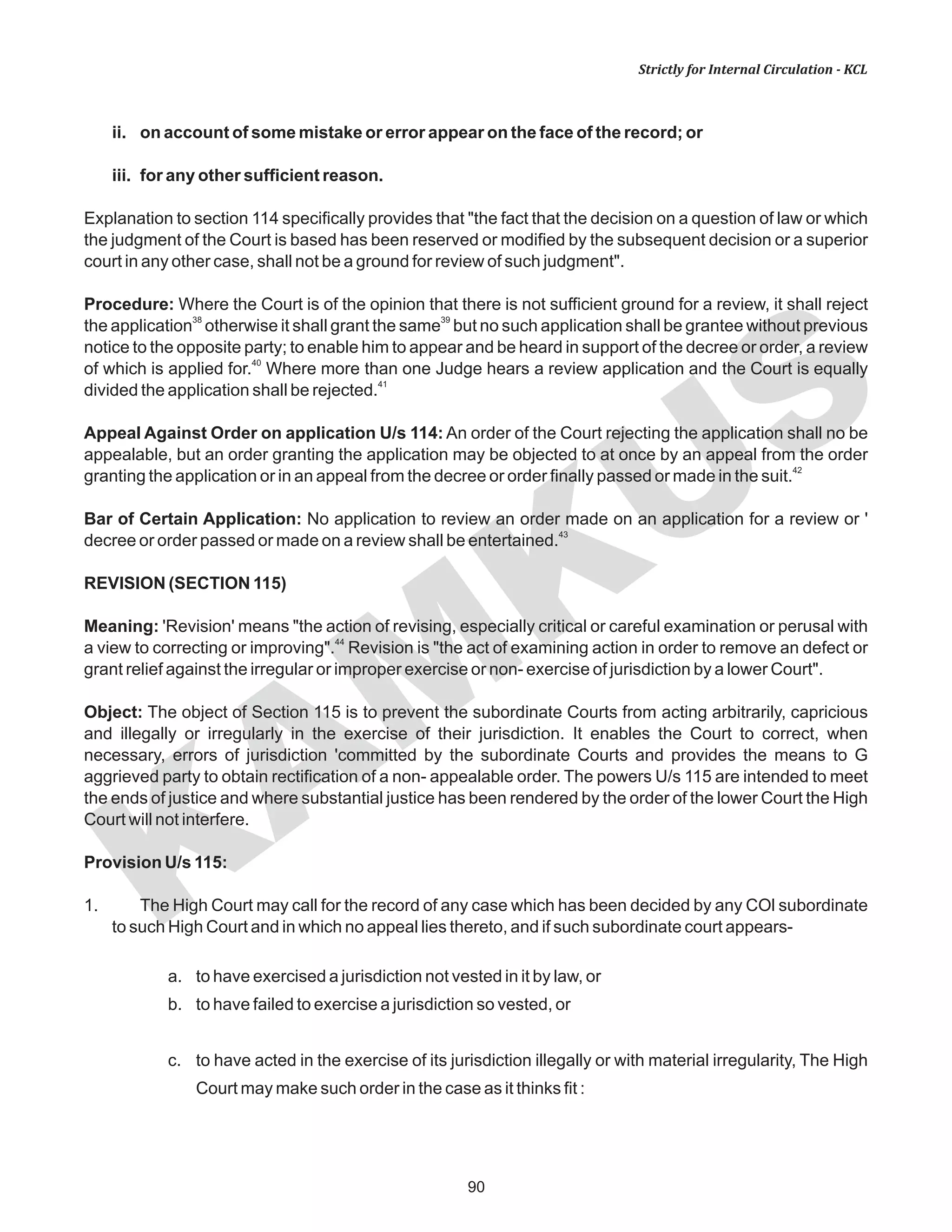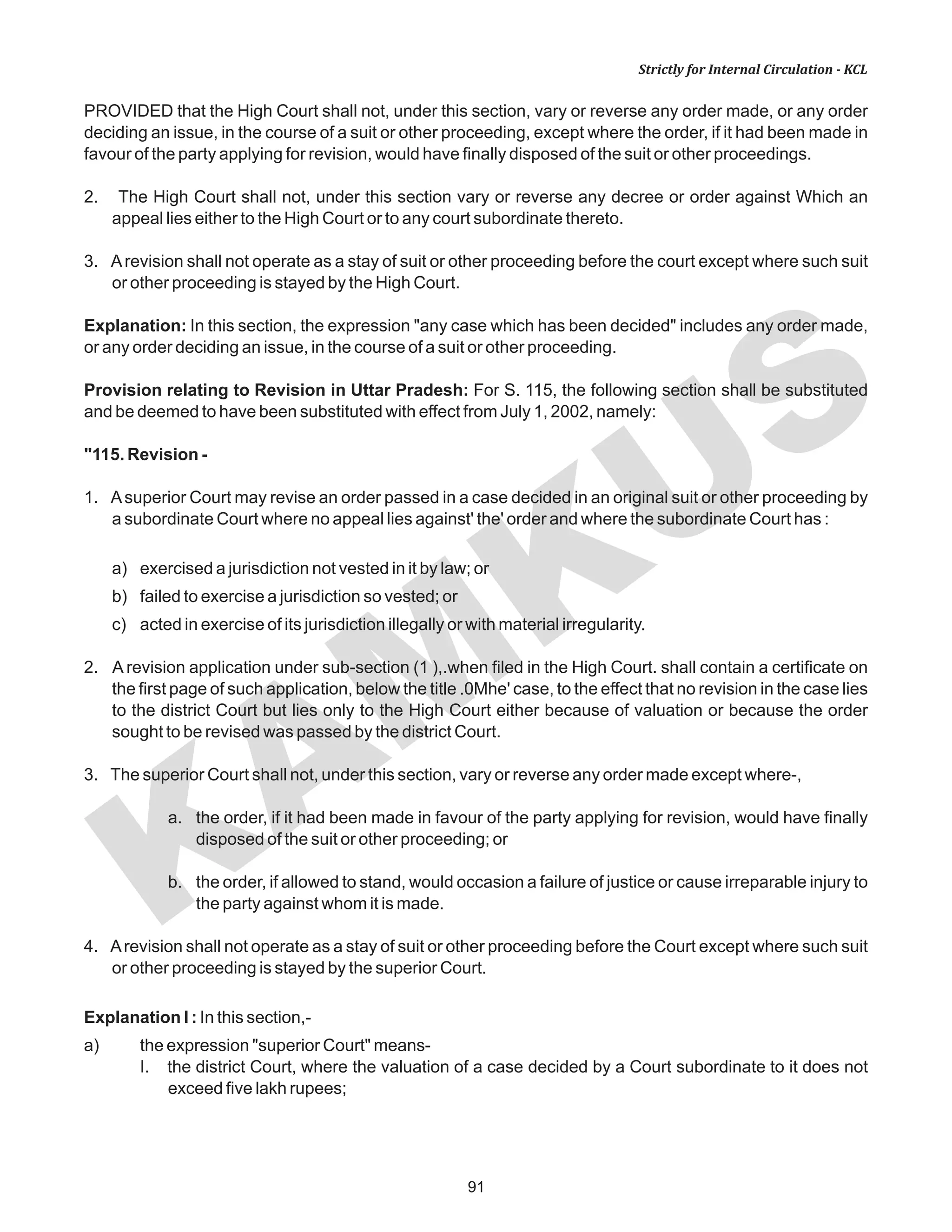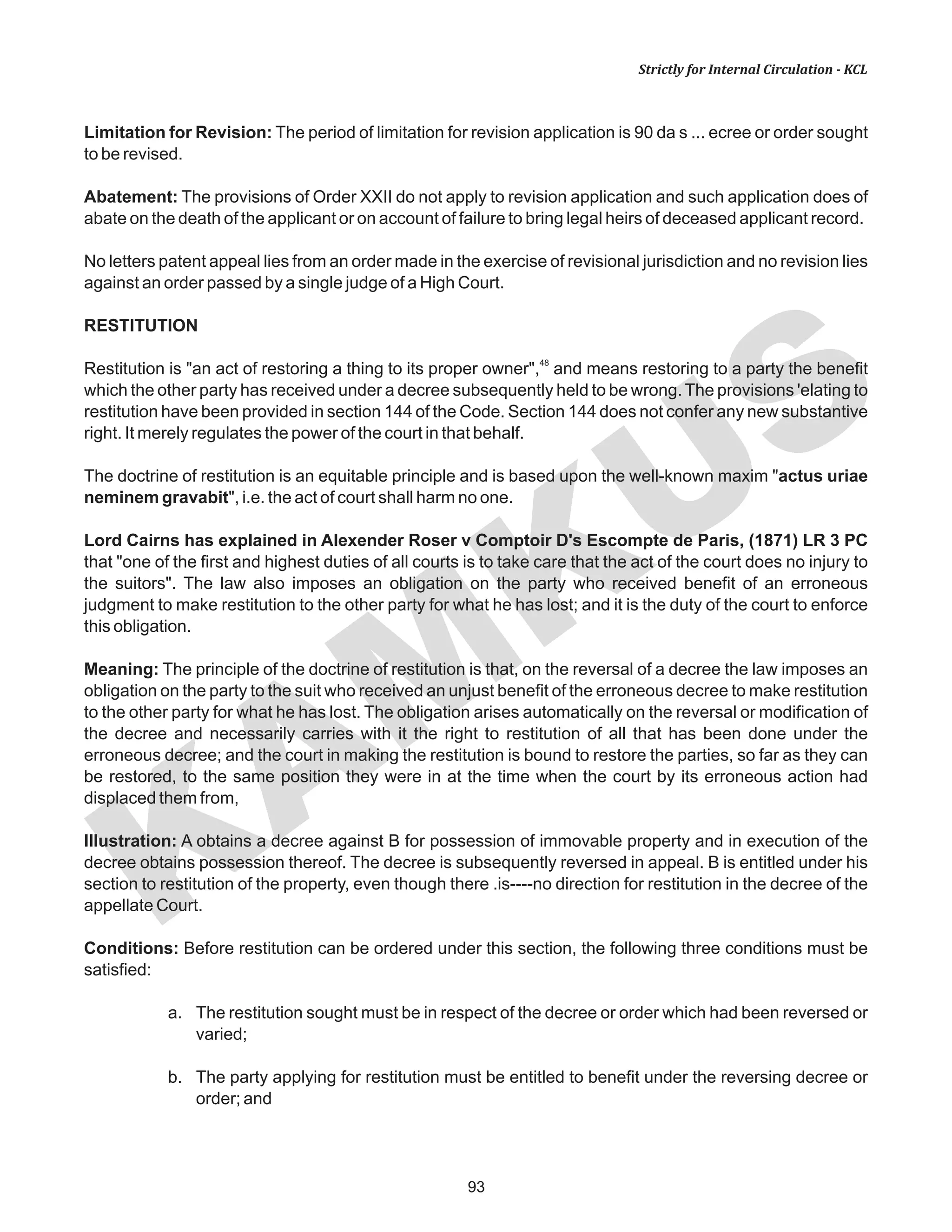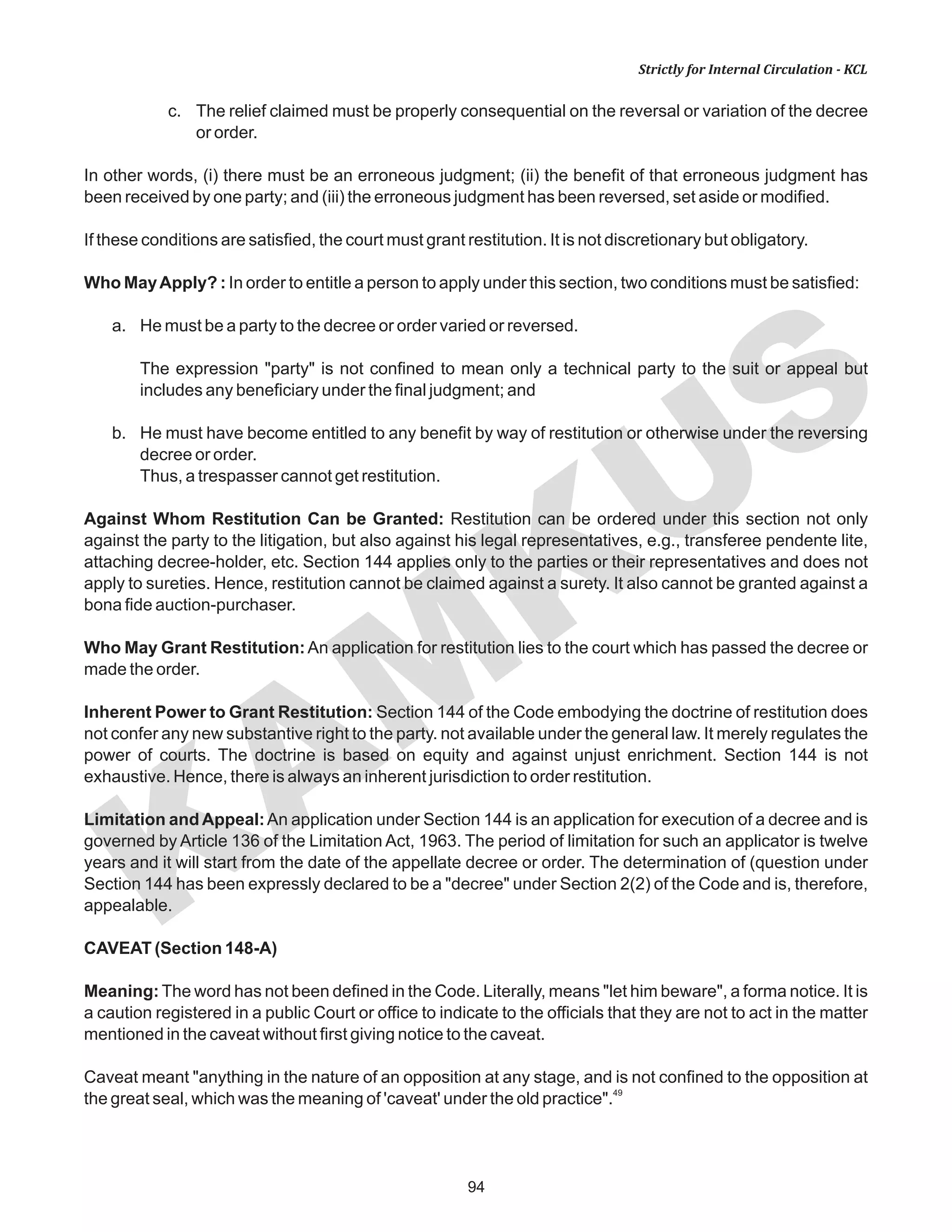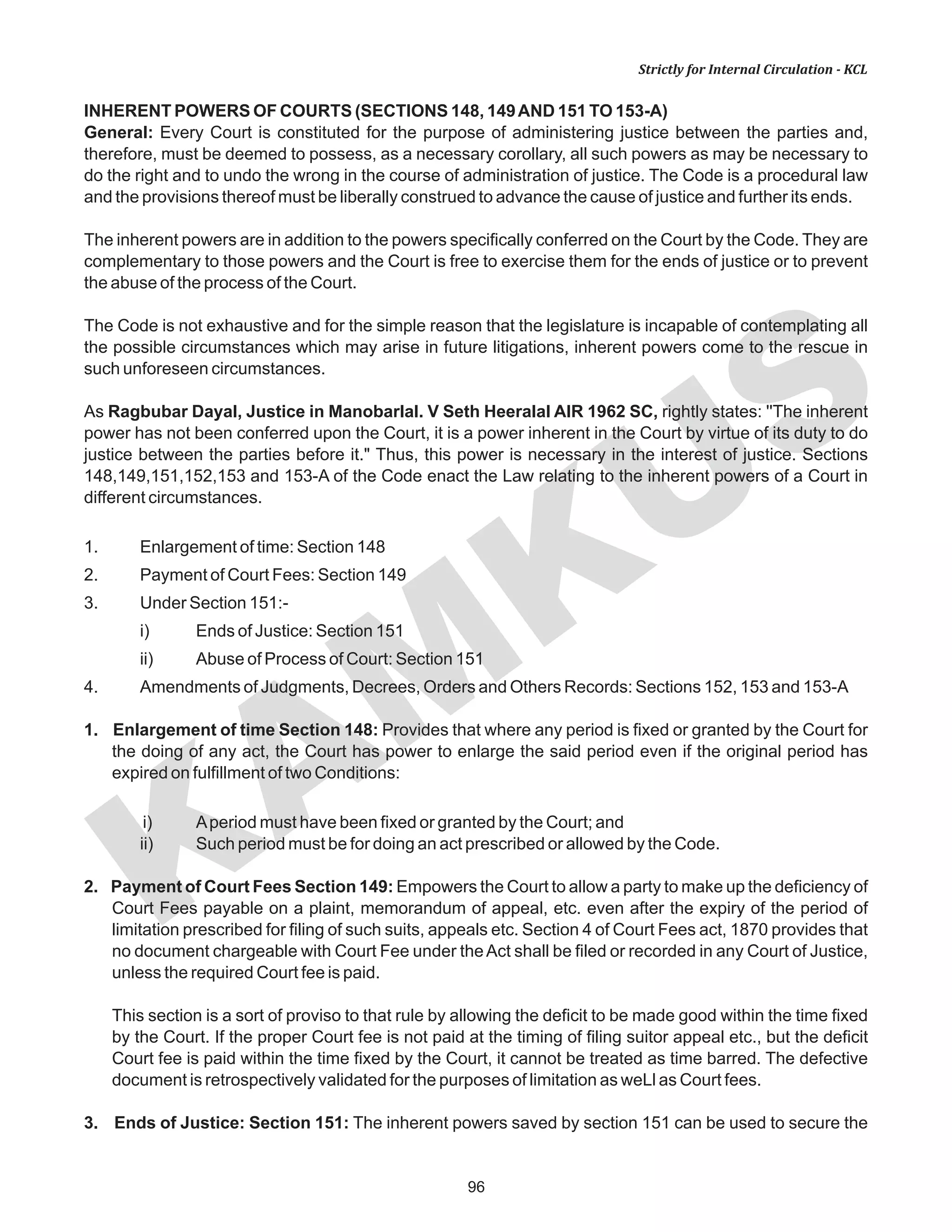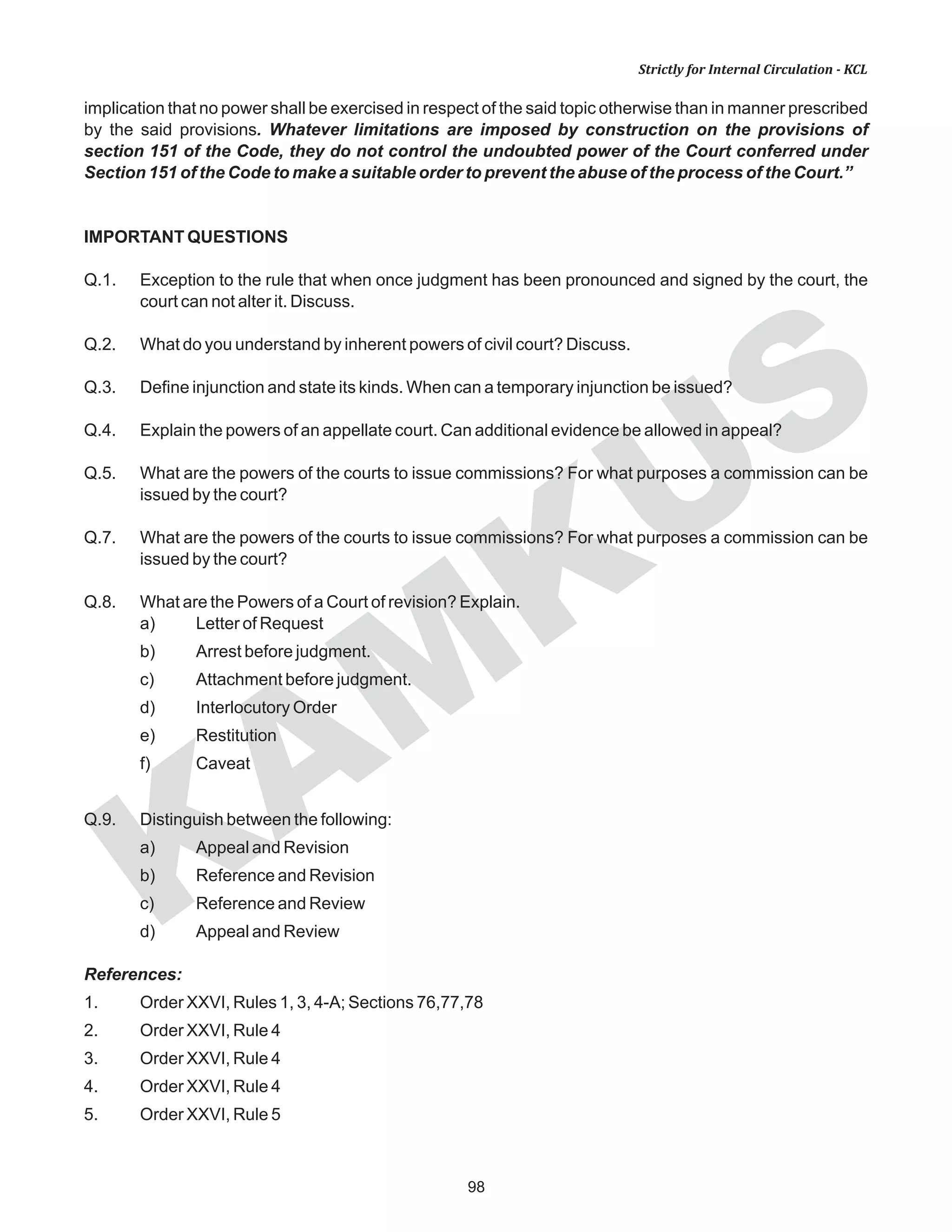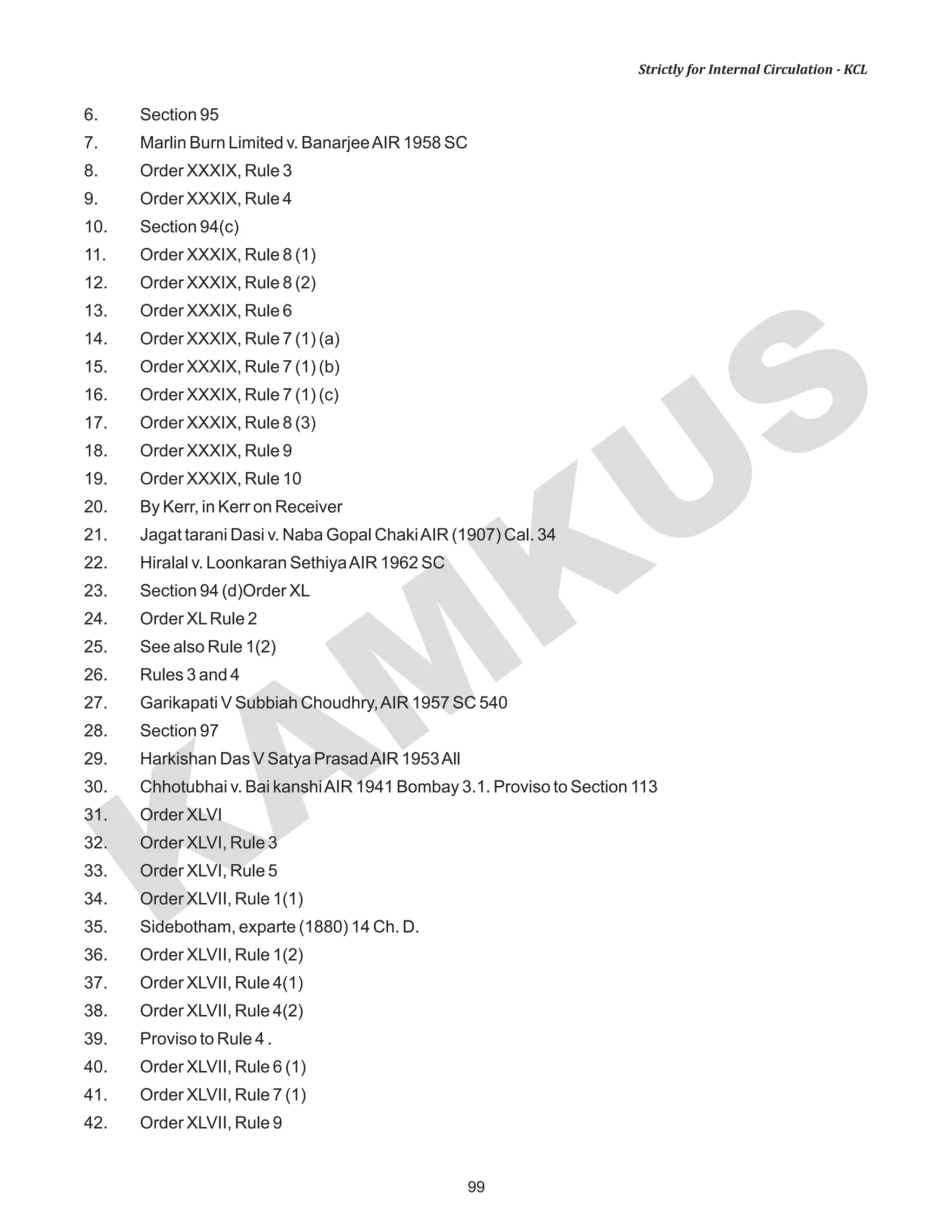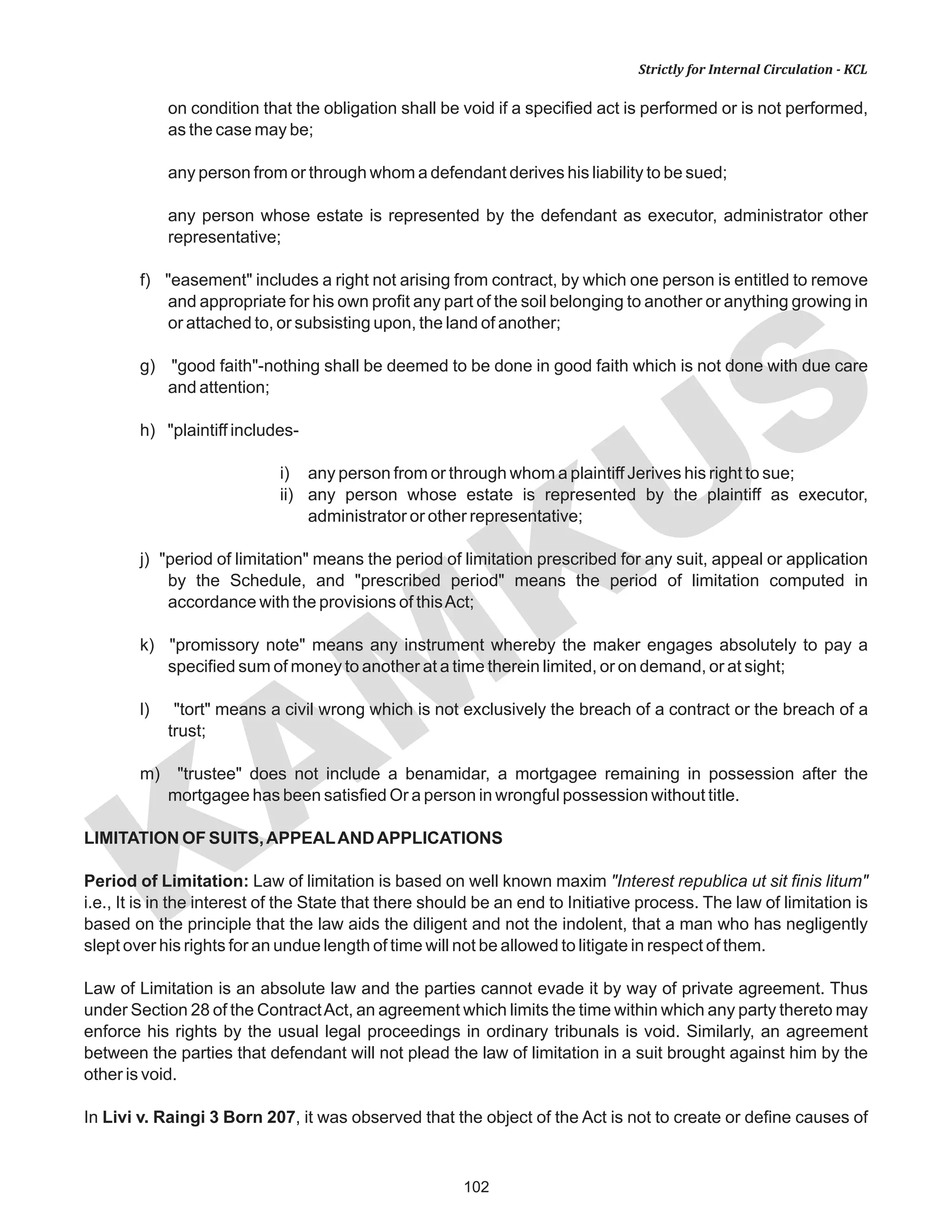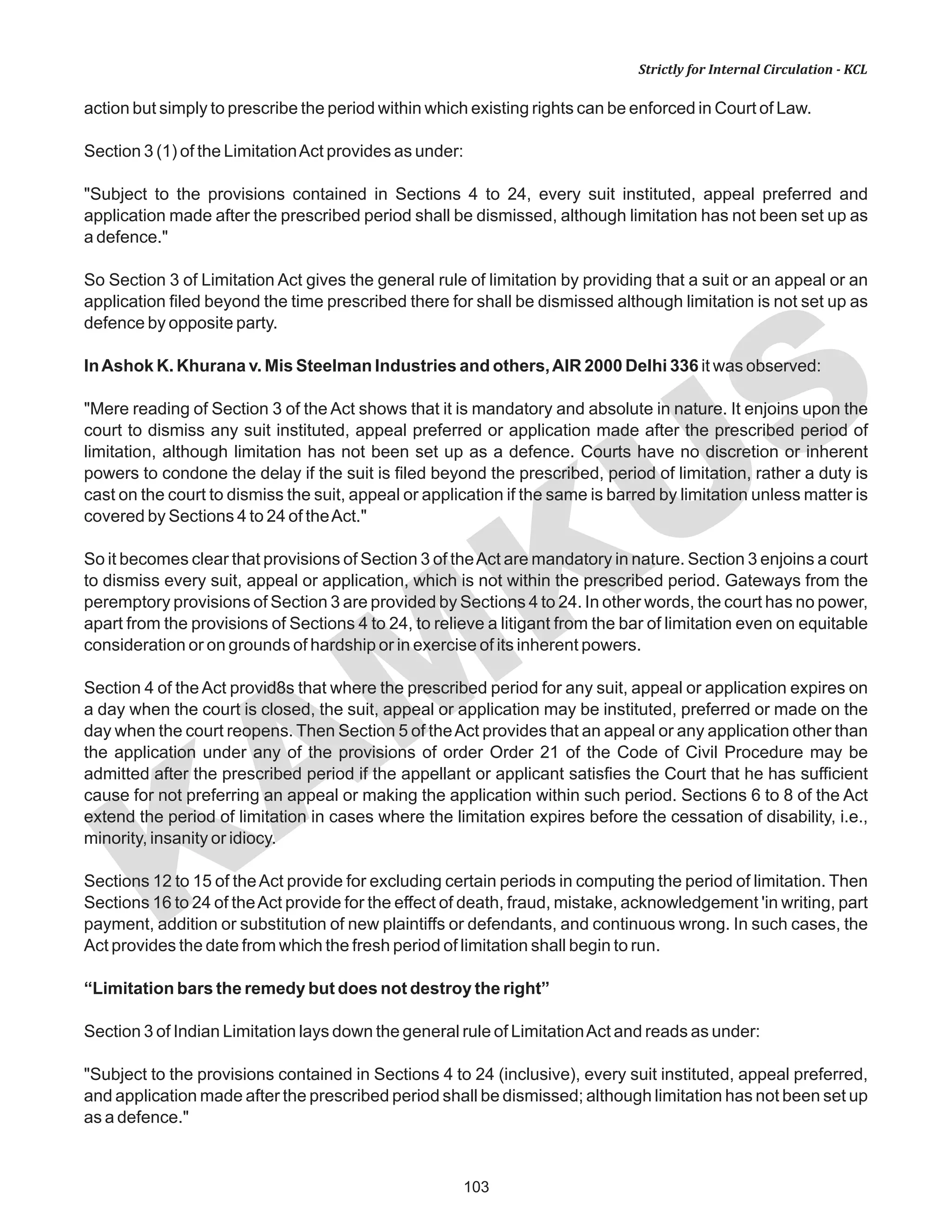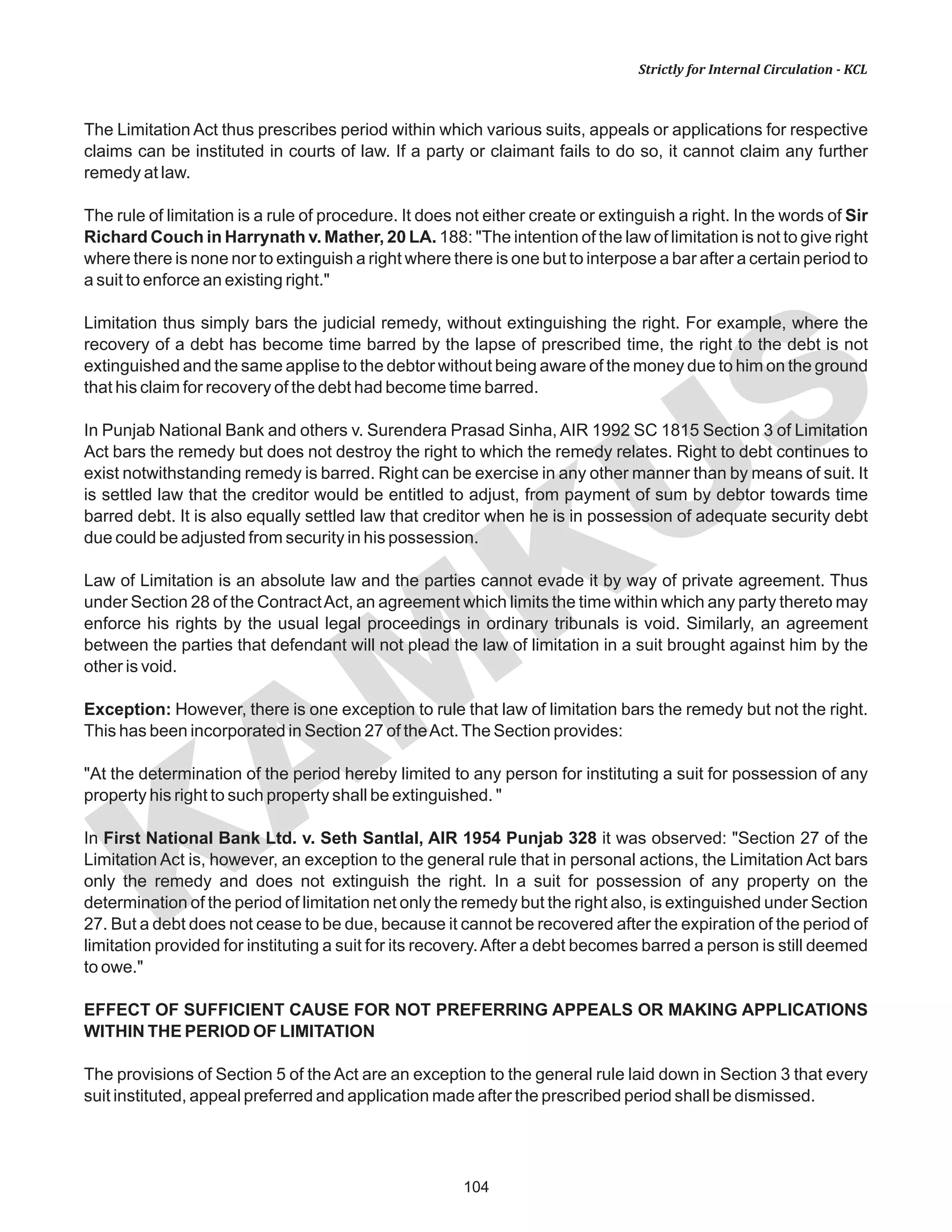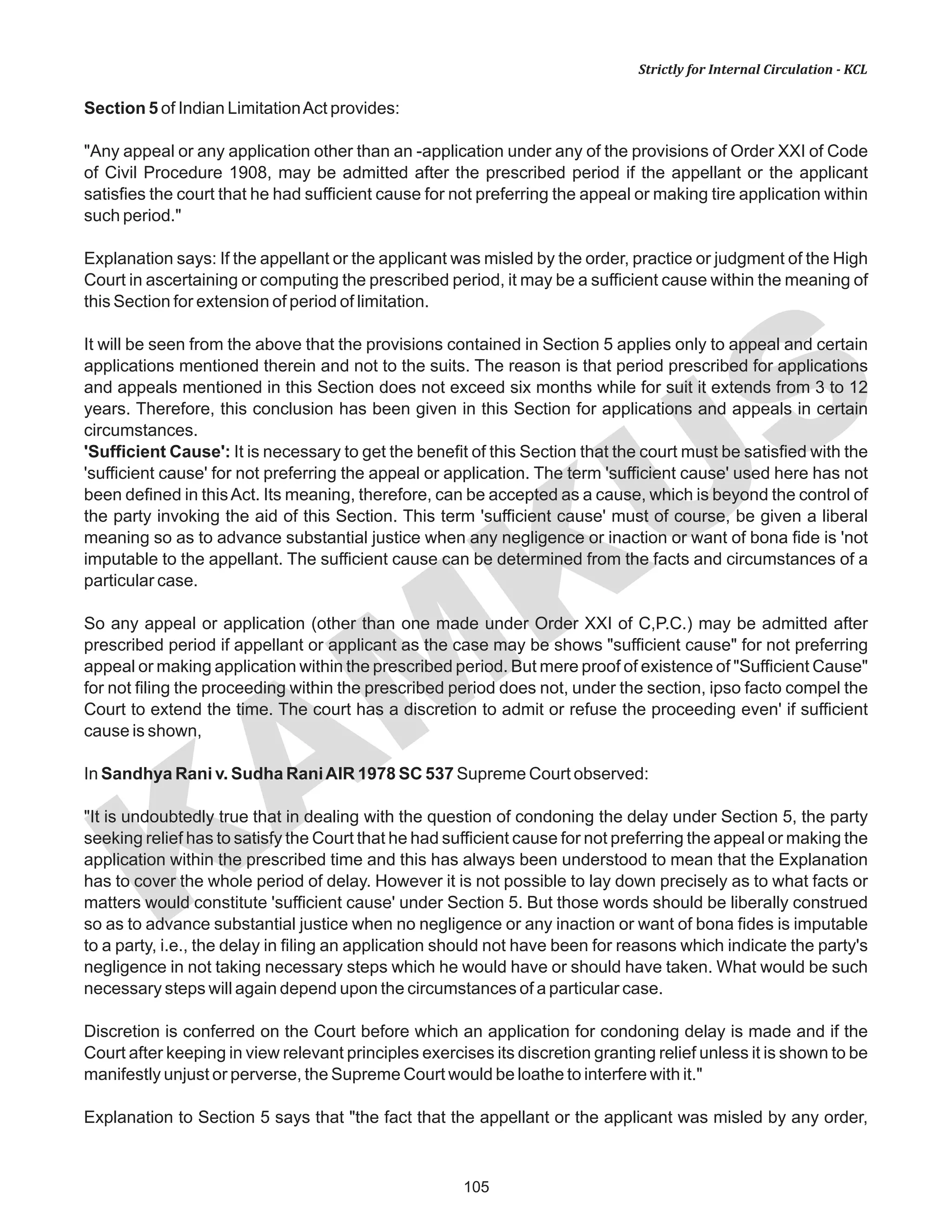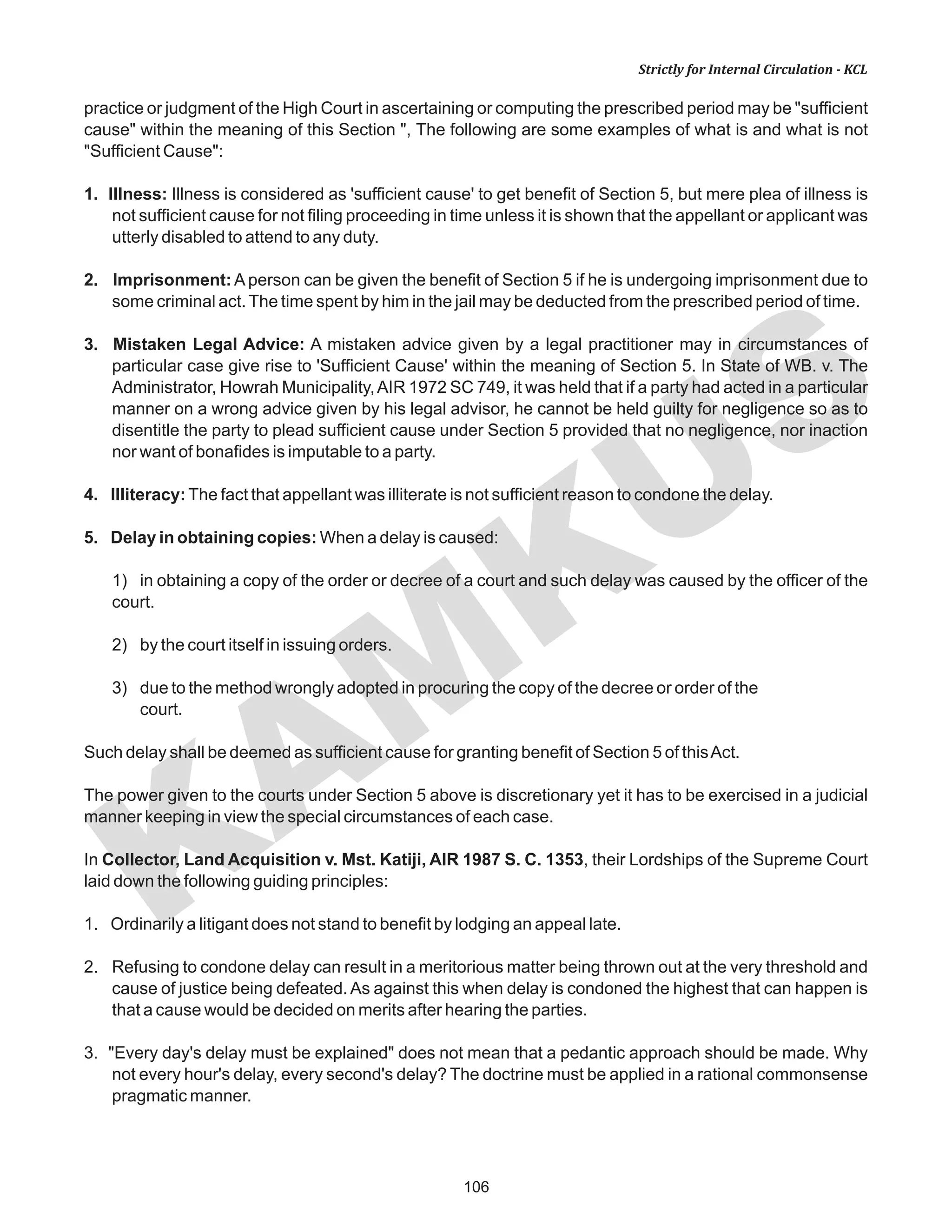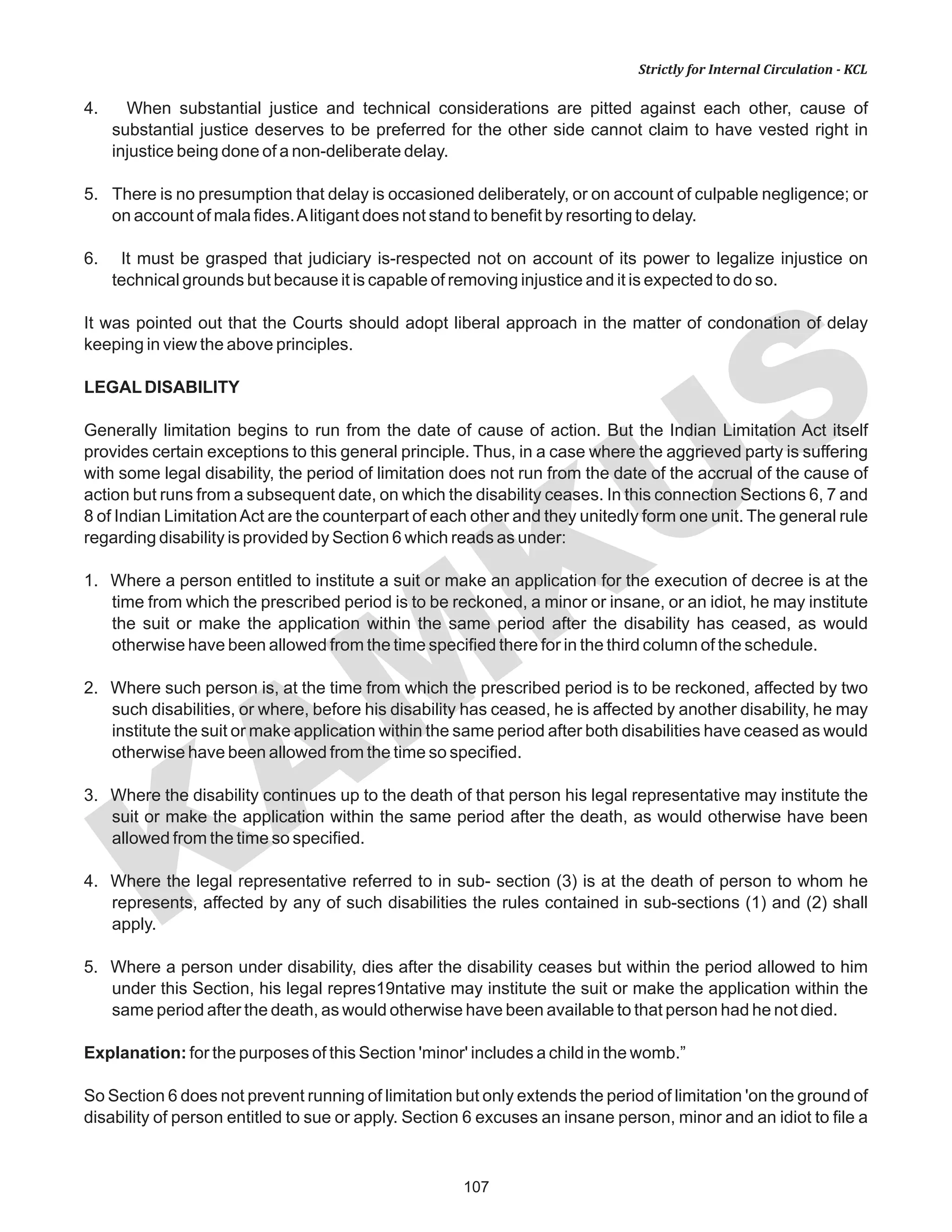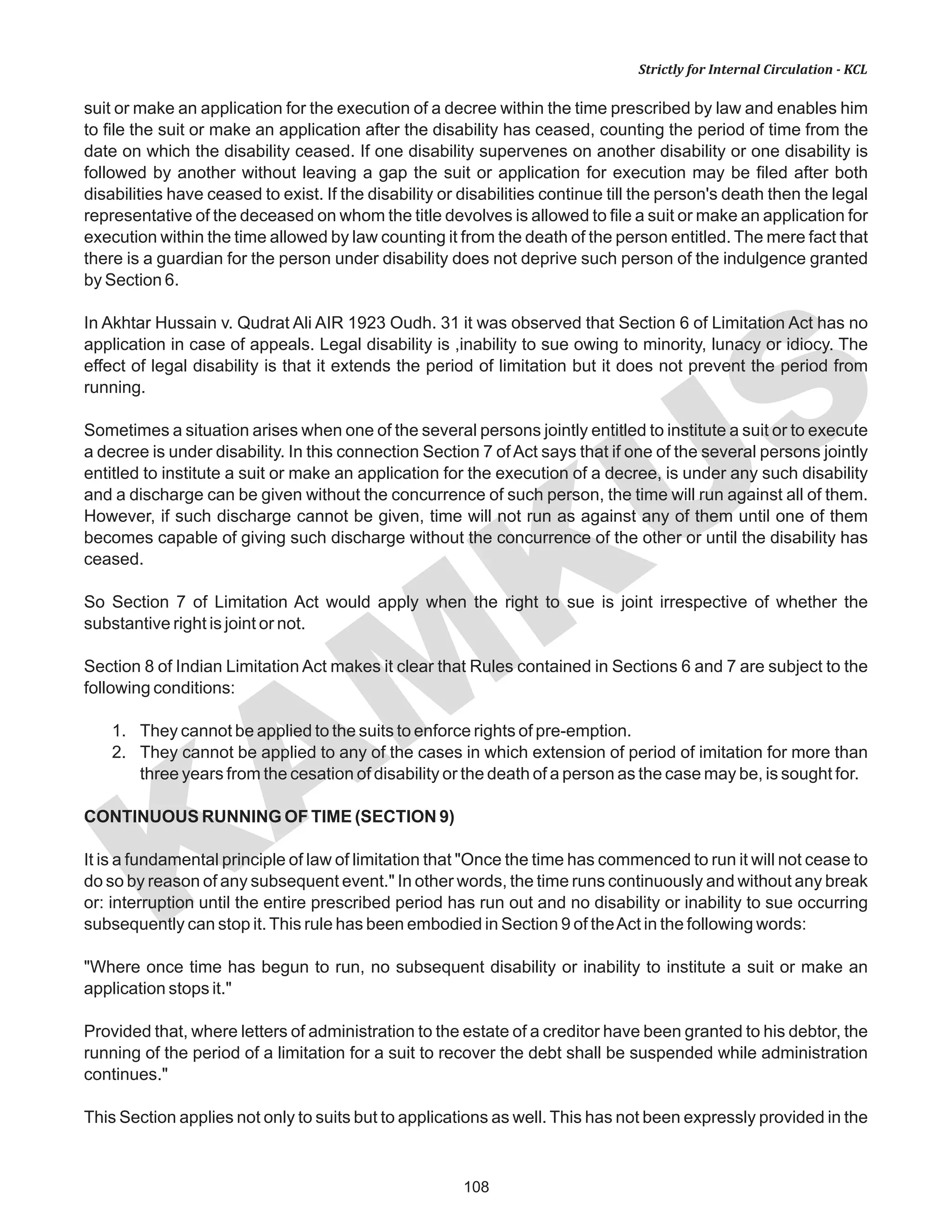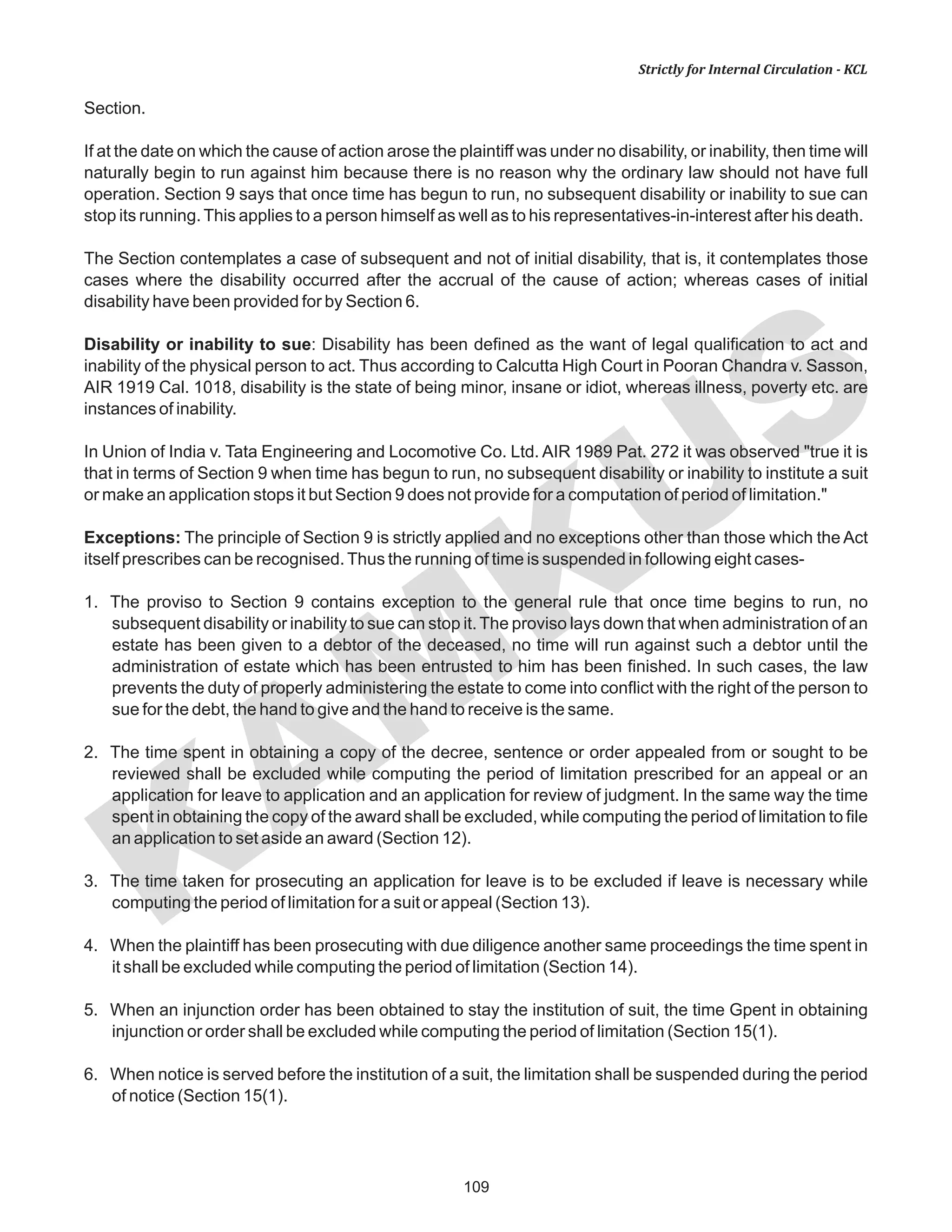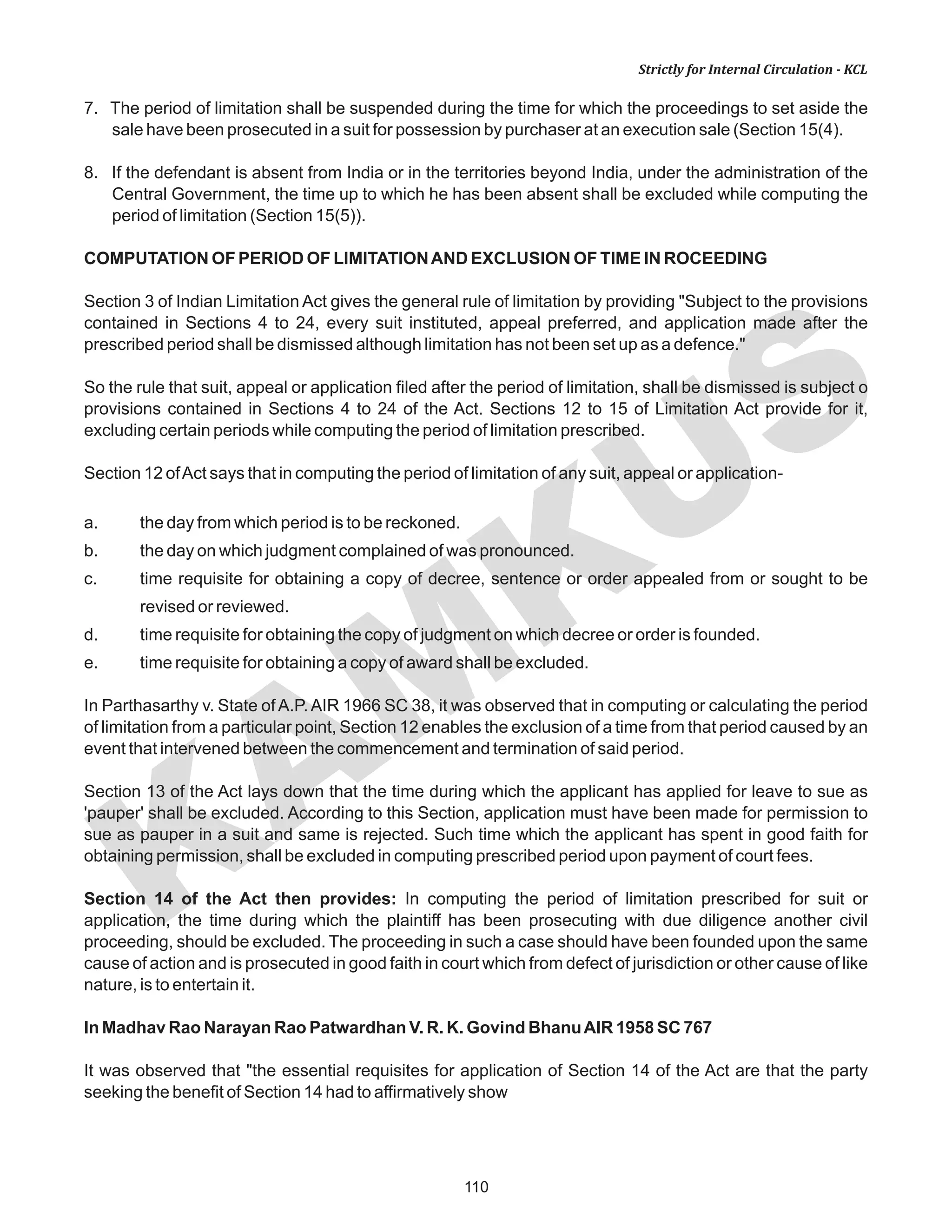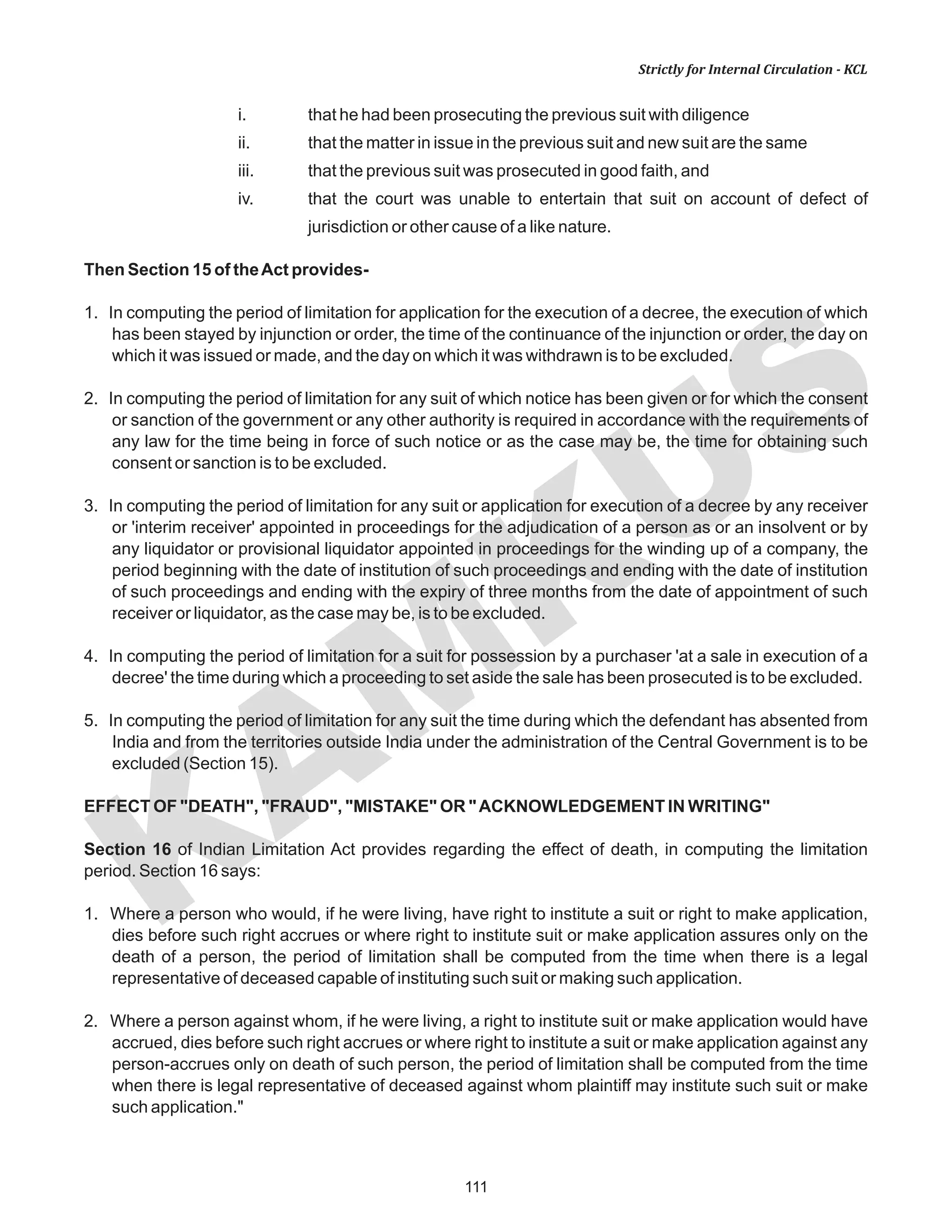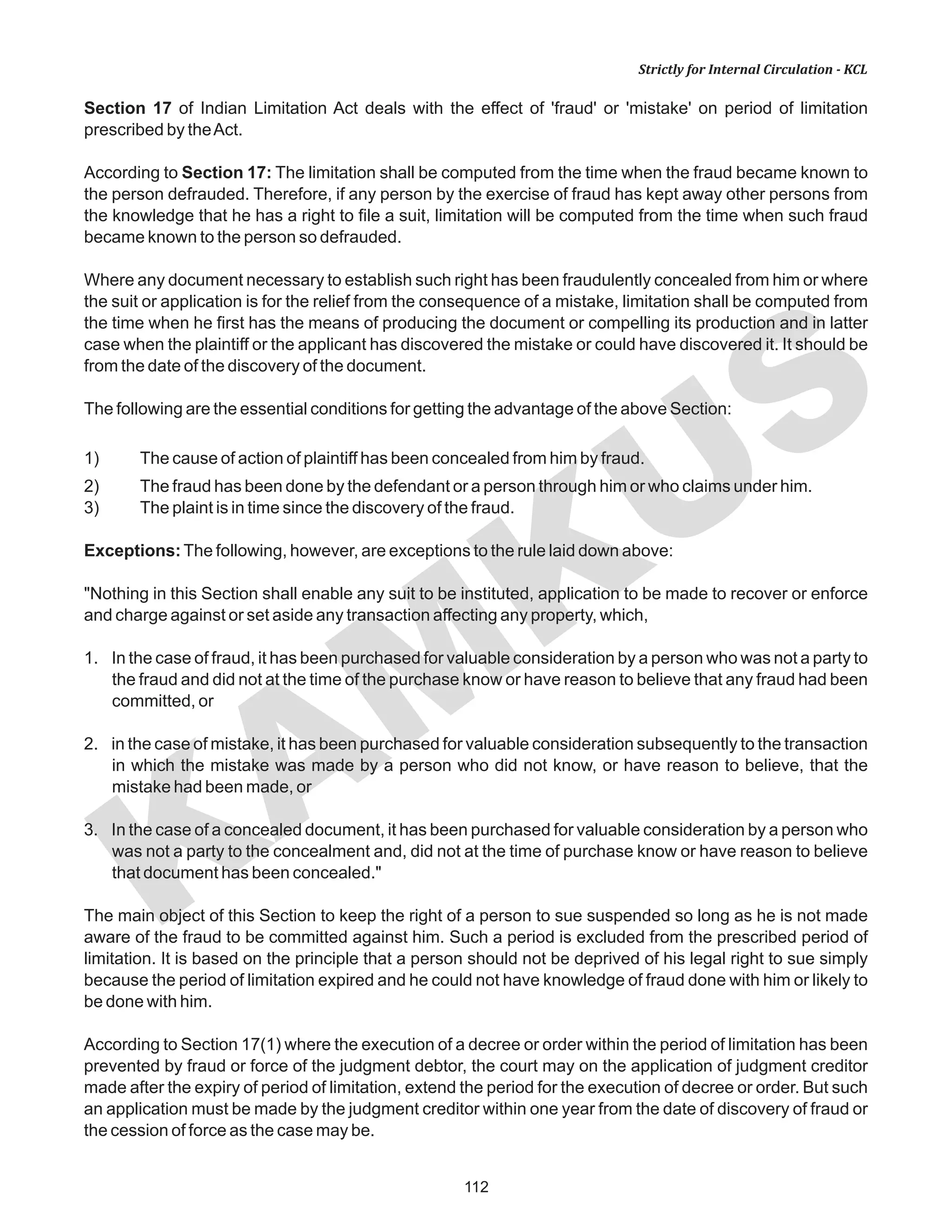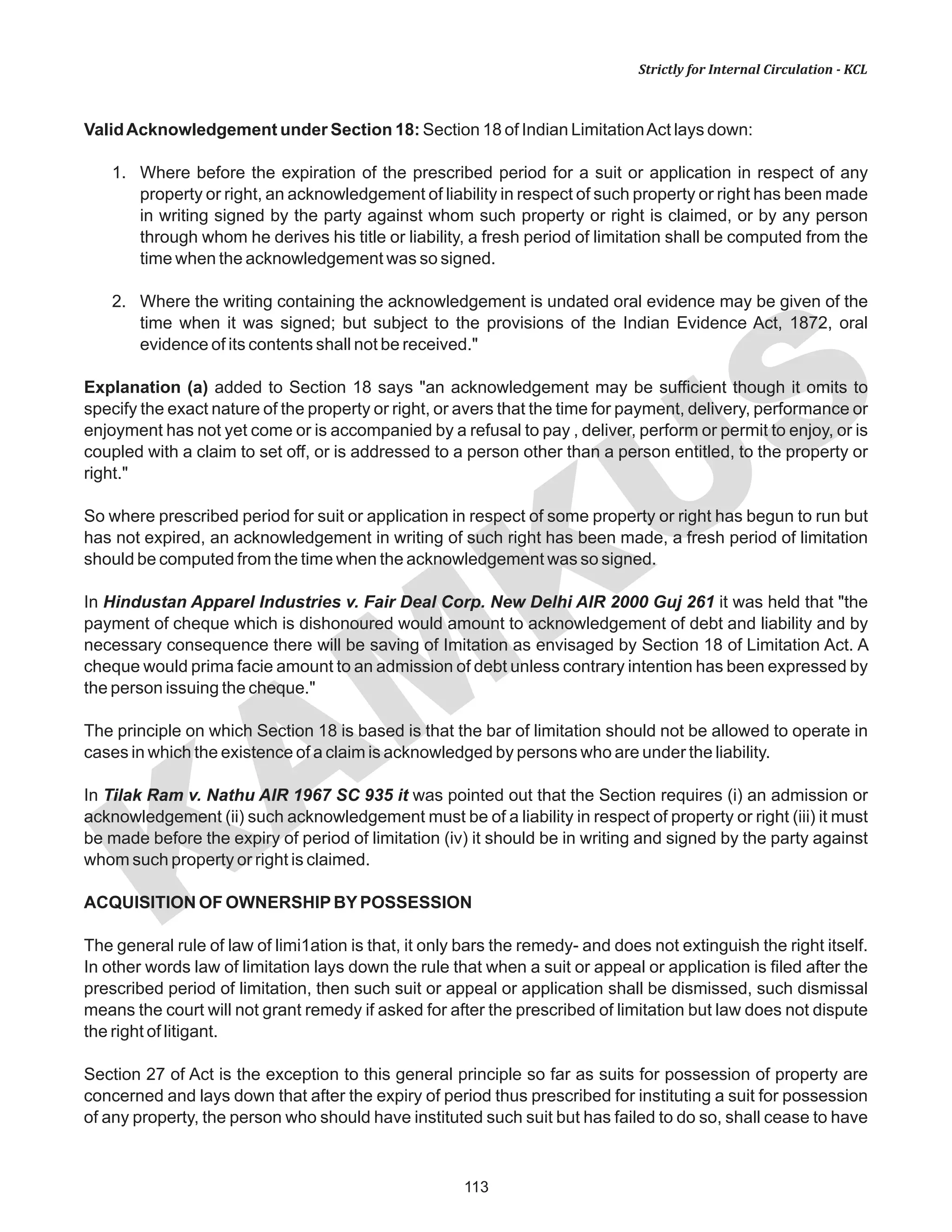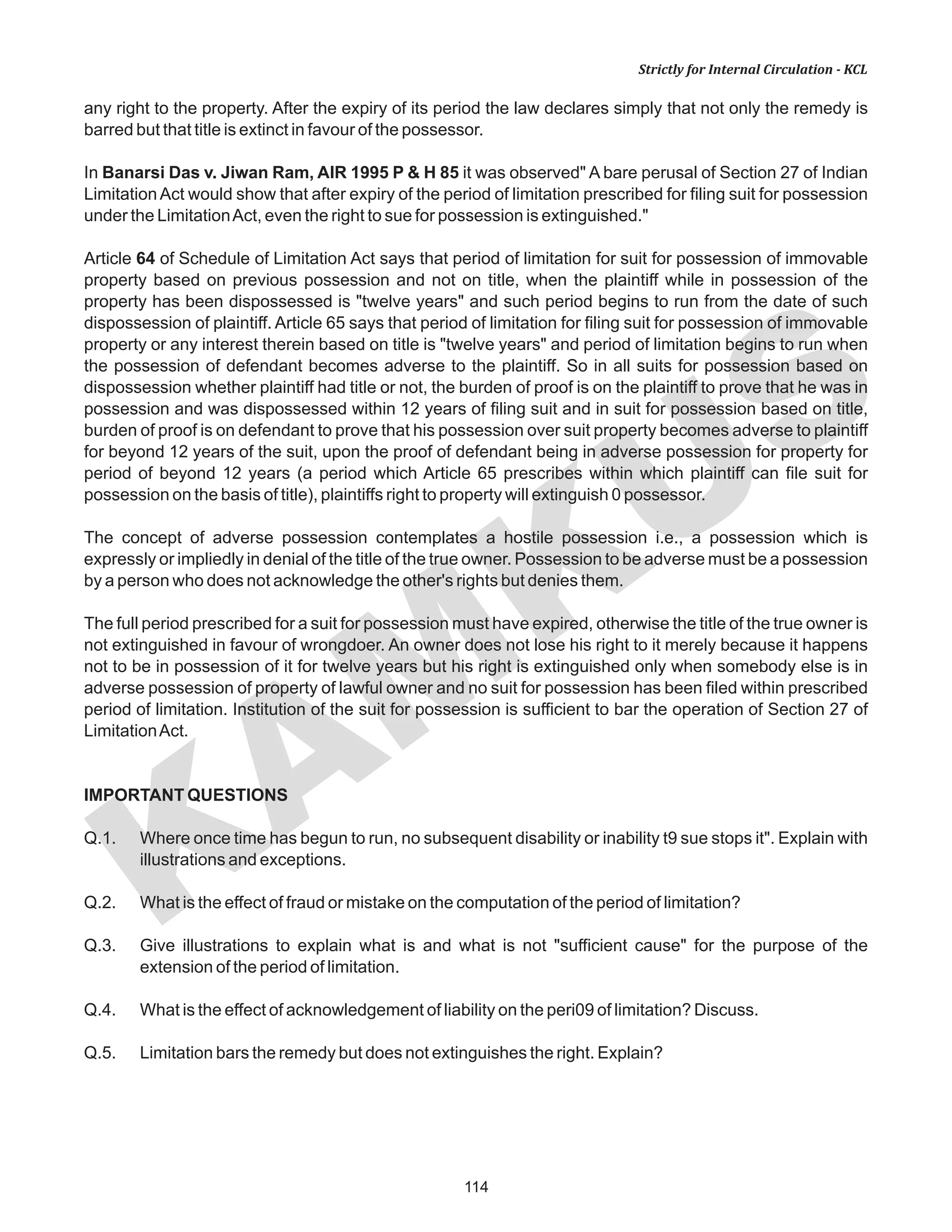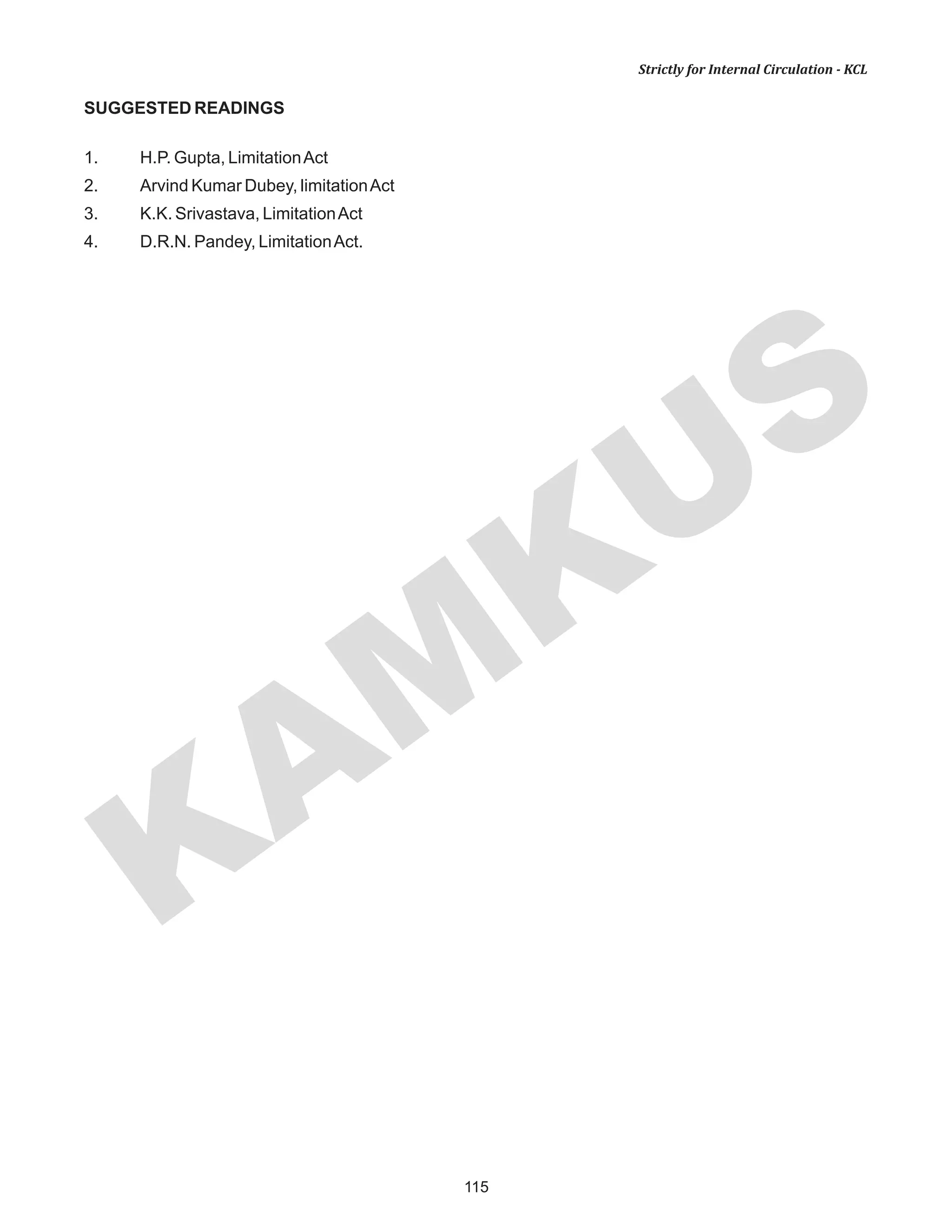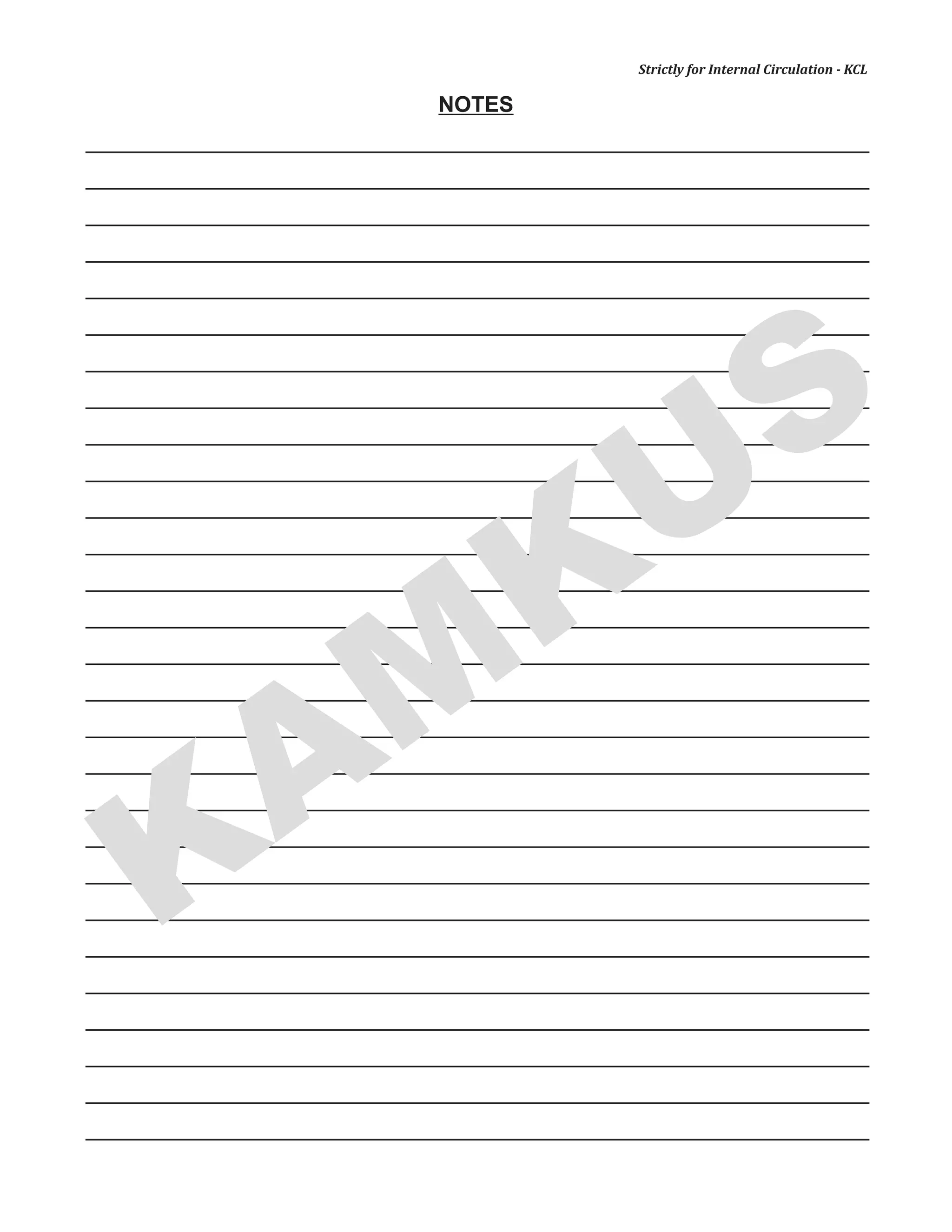The document provides an overview of key definitions and concepts from the Code of Civil Procedure in India across 5 units.
Unit I defines key terms like decree, suit of civil nature, and jurisdiction of courts. It notes a decree can be preliminary, final, or partly preliminary and partly final. A preliminary decree requires further steps, while a final decree completely resolves a suit.
The document outlines the structure of the Code of Civil Procedure and provides definitions of important terms from Section 2 like plaintiff, defendant, suit, and decree. It distinguishes decrees from orders.
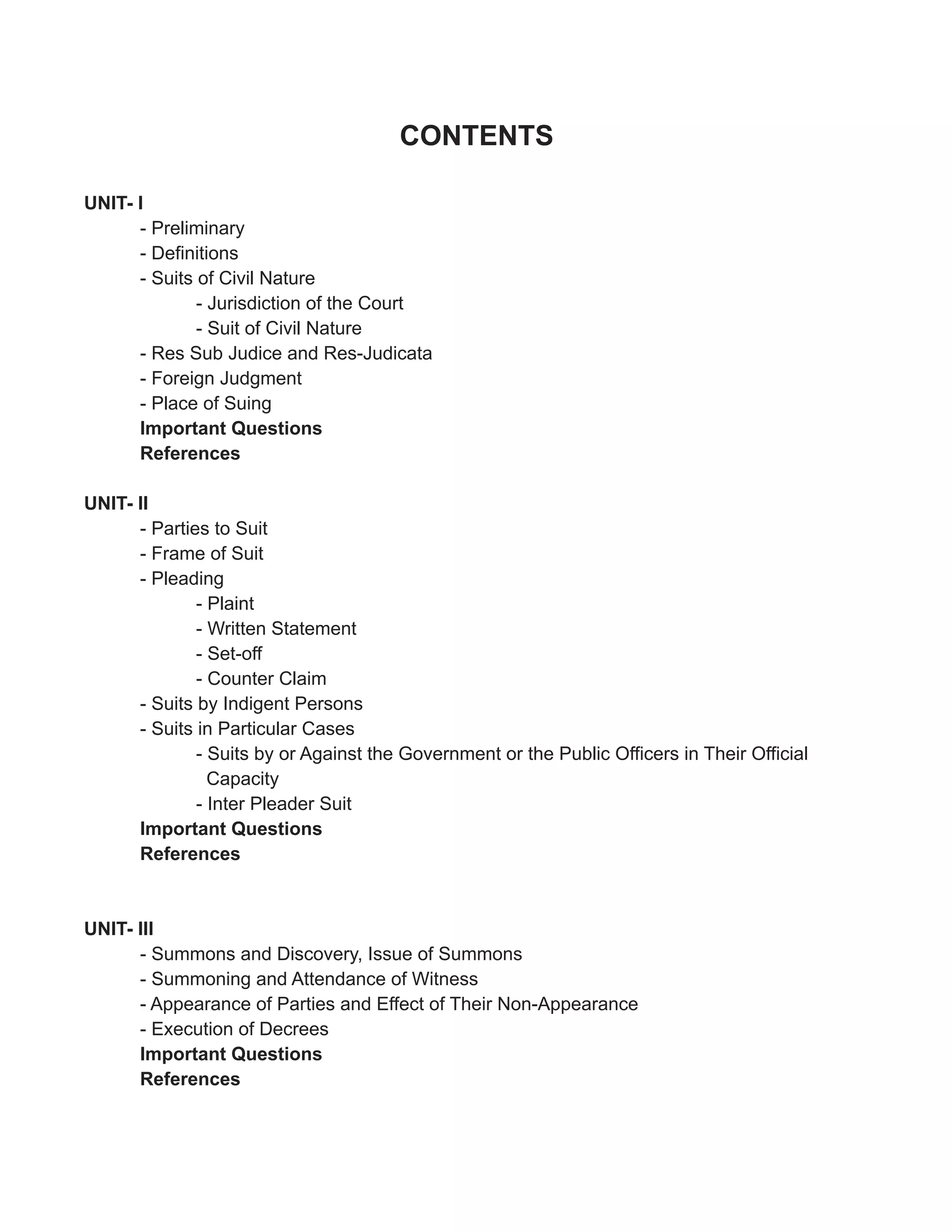
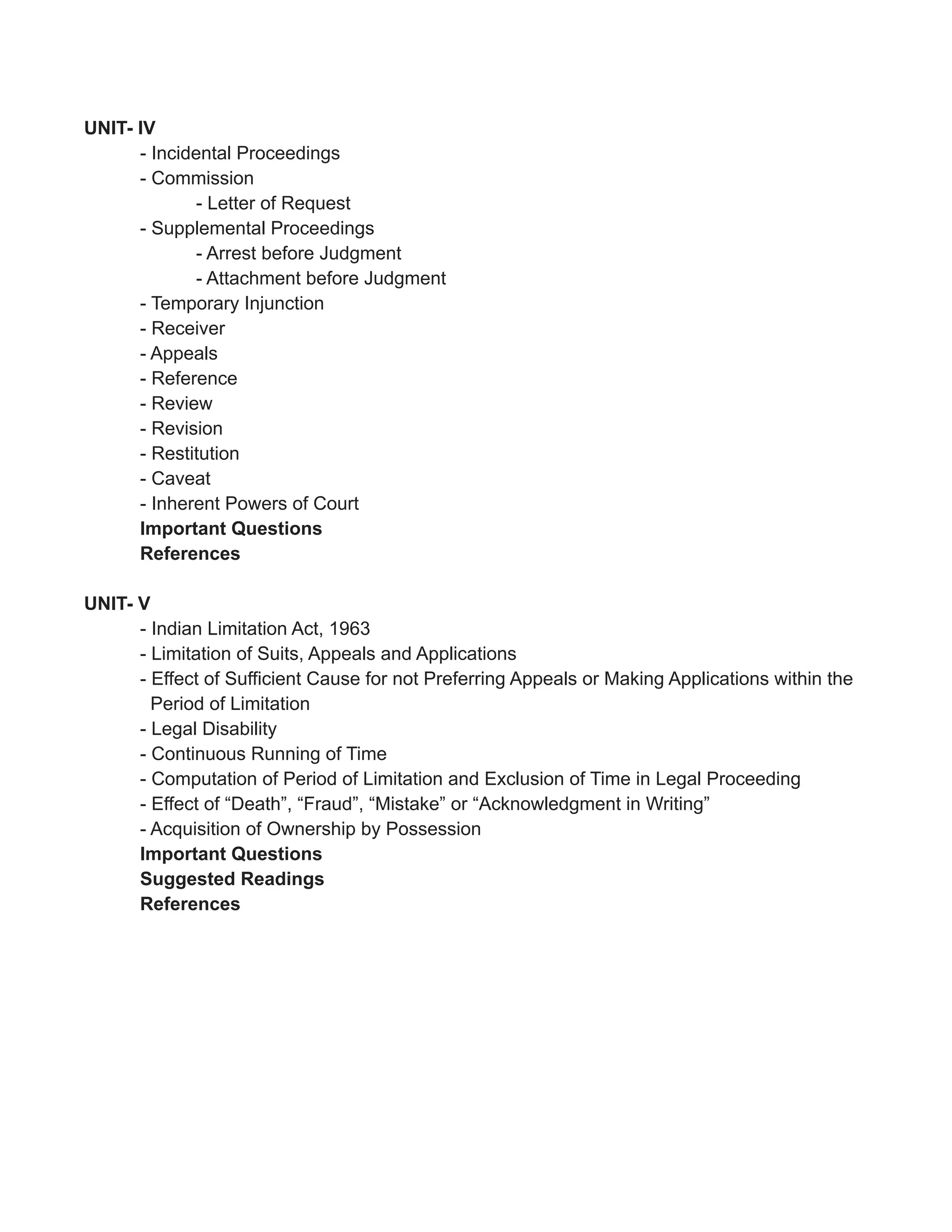
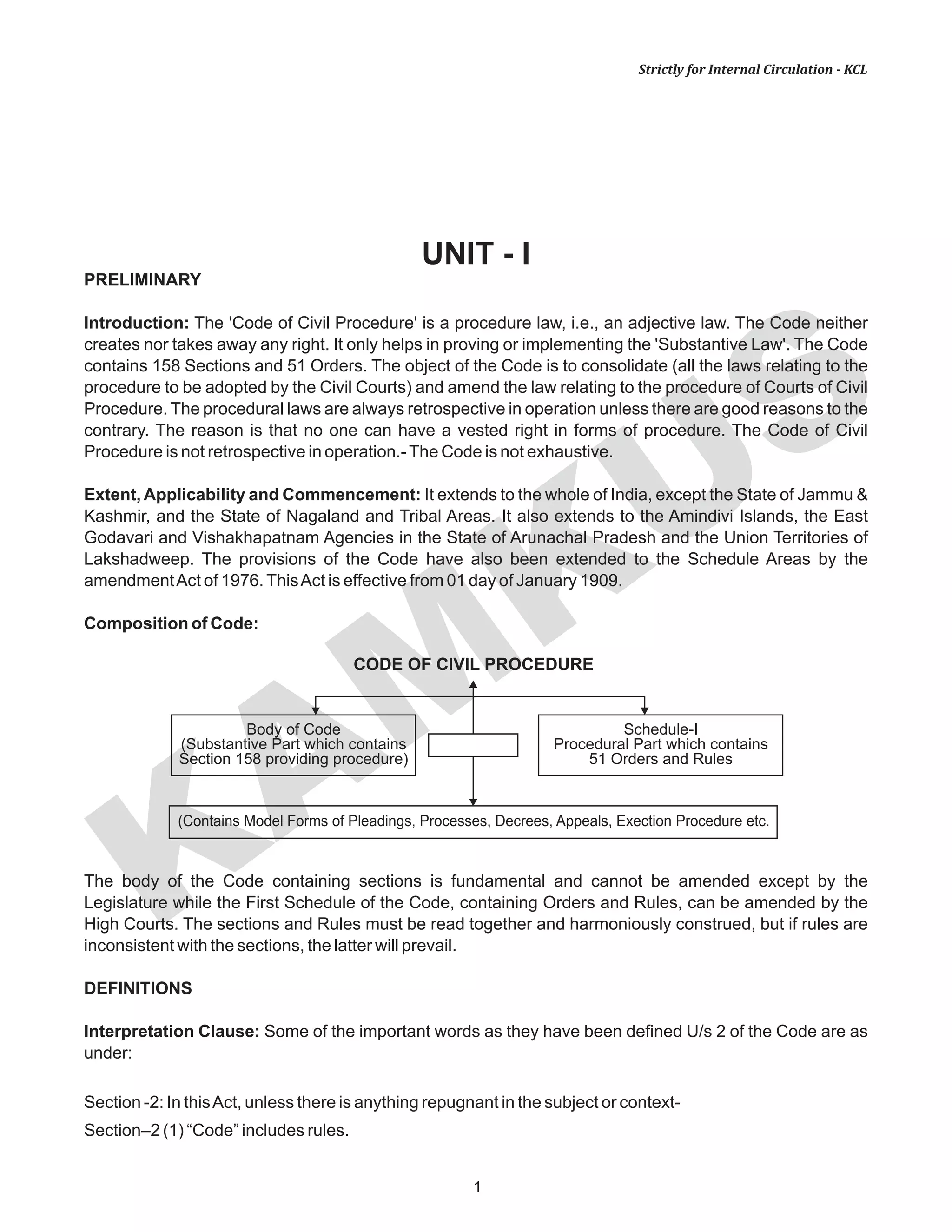
![KAM
KUS
2
Strictly for Internal Circulation - KCL
Section-2(2) "Decree" means the formal expression of an adjudication which, so far as regards the court
expressing it, conclusively determines the rights of the parties with regard to all or any of the matters in
controversy in the suit and may be either Preliminary or final. It shall be deemed to include the rejection of a
plaint and the determination of any question within Section-144, but shall not include:-
a) any adjudication from which an appeal lies as an appeal from an order, or
b) any order for dismissal for default.
Explanation: A decree is preliminary where further proceedings have to be taken before the suit can be
completely disposed of. It is final when such adjudication completely disposes of the suit. It may be partly
preliminary and partly final.
Decree [Section-2 (2)] and Order [Section-2 (14)]
Essential Elements of a decree: The decision of a Court can be termed as a "decree" upon the
satisfaction of the following elements:-
I. There must be an adjudication i.
II. Such adjudication must have been given in a suit ii.
III. It must have determined the rights of the parties iii with regard to all or any of the matter in
controversy in the suit.
IV. Such determination must be of a conclusive nature iv, and
V. There must be formal expression v of such adjudication.
a) An Adjudication:Adjudication means "the judicial determination of the matter in dispute". If there is no
judicial determination of any matter in dispute or such judicial determination is not by a Court, it is not a
decree; e.g., an order of dismissal of a suit in default for non appearance of parties, or of dismissal of an
appeal for want of prosecution are not decrees because they do not judicially deal with the matter in
dispute.
b) In a Suit: Suit means a Civil proceeding instituted by the presentation of a Plaint. Thus, every suit is
instituted by the presentation of Plaint. Where there is no Civil suit, there is no decree; e.g., Rejection of
an application for leave to sue in forma pauper is is not a decree, because there cannot be a plaint in
such case until the application is granted.
Exception: But where in an enactment specific provisions have been made to treat the applications as
suits, then they are statutory suits and the decision given thereunder are, therefore, decrees; e.g.,
proceeding under the Indian Succession Act, the Hindu Marriage Act, the Land Acquisition Act, the
ArbitrationAct, etc.
c) Rights of the parties: The adjudication must have determined the rights i.e., the substantive rights and
not merely procedural rights of the parties with regard to all or any of the matter in controversy in the suit.
"Rights of the parties" under section 2(2).
The rights of the parties inter se (between the parties) relating to status, limitation, jurisdictions, frame of](https://image.slidesharecdn.com/cpc-smartnotes-190508082159/75/Cpc-smart-notes-4-2048.jpg)
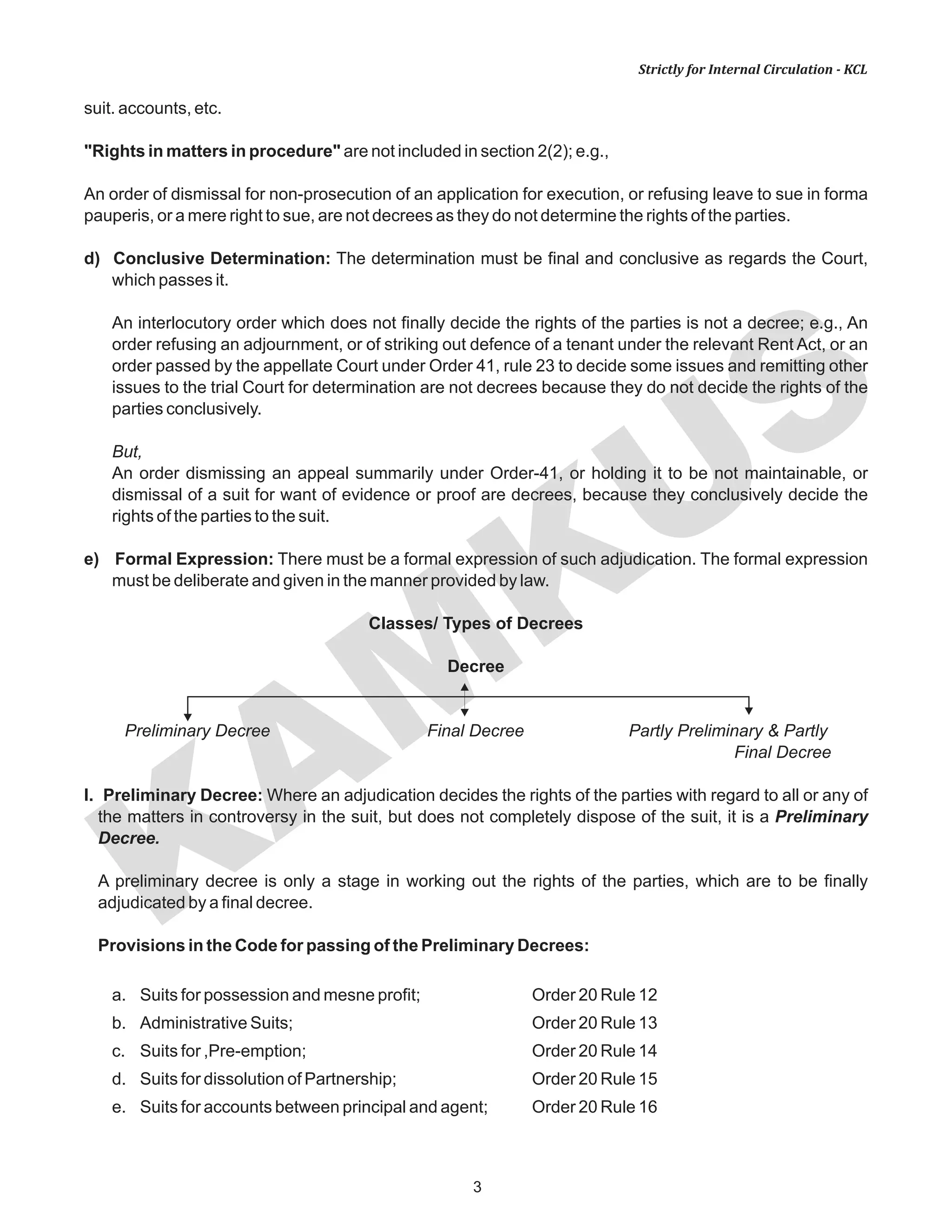
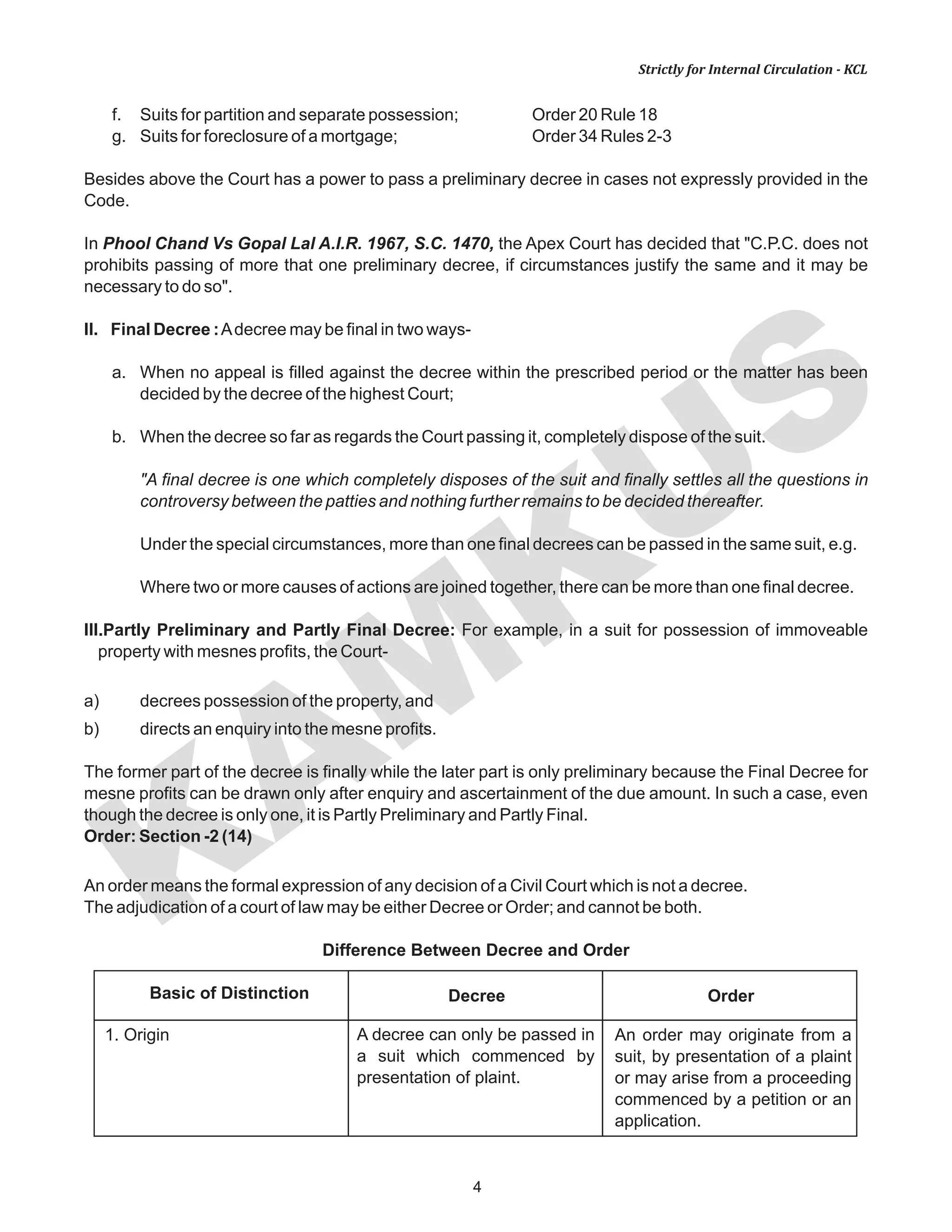
![KAM
KUS
5
Strictly for Internal Circulation - KCL
2(3) "Decree-Holder" means any person in whose favour a decree has been passed or an order capable
of execution has been made.
2(5) "Foreign Court" means a Court situate outside India and not established or continued by the authority
of the Central Government;
2(6) "Foreign Judgment" means the judgment of a foreign Court;
2(8) "Judge" means the presiding officer of a Civil Court;
2(9) "Judgment" means the statement given by the Judge on the grounds of a decree or order.
2(10) "Judgment-Debtor" means any person against whom a decree has been passed or an order
capable of execution has been made.
2(11) "Legal Representative" means a person who in law represents the estate of a deceased person,
and includes any person who intermediates with the estate of the deceased and where a party sues or is
sued in a representative character the person on whom the estate devolves on the death of the party so
suing or sued.
2(12) "Mesne Profits" of property means those profits which the person in wrongful possession of such
property actually received or might with ordinary diligence have received therefrom, together with interest
on such profits, but shall not include profits due to improvements made by the person in wrongful
possession;
A decree is an adjudication
conclusively determining the
rights of the parties with regard
to all or any of the matters in
controversy.
A decree may be Preliminary or
Partly Preliminary or Partly
Final.
2. Determination of Rights
3. Type of Decree Decree may be Preliminary or
Party Preliminary or Party Final.
There cannot be a Preliminary
Order.
4. No. of Order/ Decree
5. Appeal From
In every suit, there can be only
one decree, except in certain
suits, where two decrees, one
Preliminary and one Final are
passed.
Every decree is appealable
unless otherwise expressly
provided.
A second appeal lies to the High
Court on Certain grounds from
the decree passed in First
Appeal (Sec. 100). Thus there
may be two appeals.
In case of suit or proceeding
number of order may be
passed.
Every order is not appealable.
Only those orders are
appealable as specified in the
Code i.e. Section 104 & Order
43 Rule 1.
No Second appeal lies in case
of appealable orders [Sec.
104(2)].
6. Second Appeal](https://image.slidesharecdn.com/cpc-smartnotes-190508082159/75/Cpc-smart-notes-7-2048.jpg)
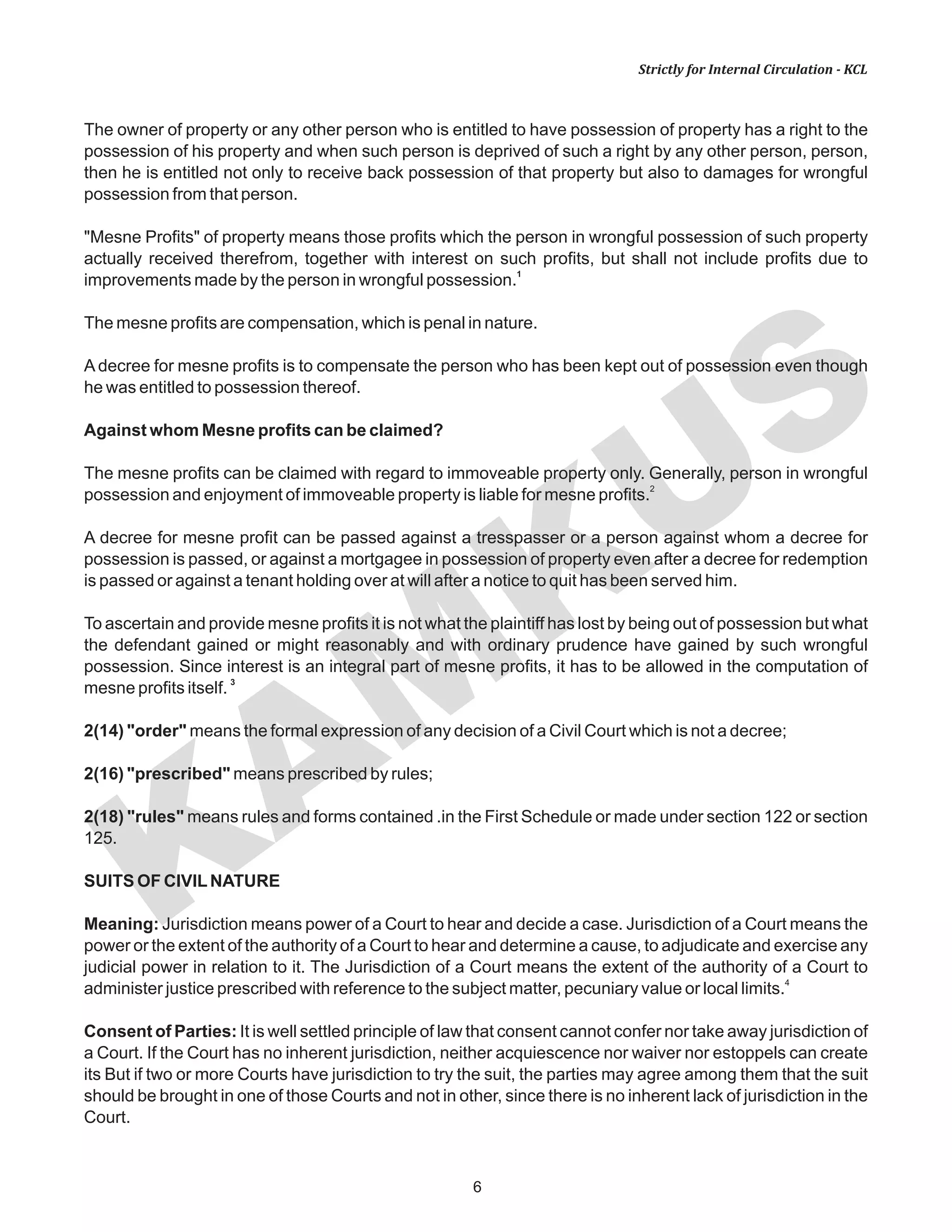
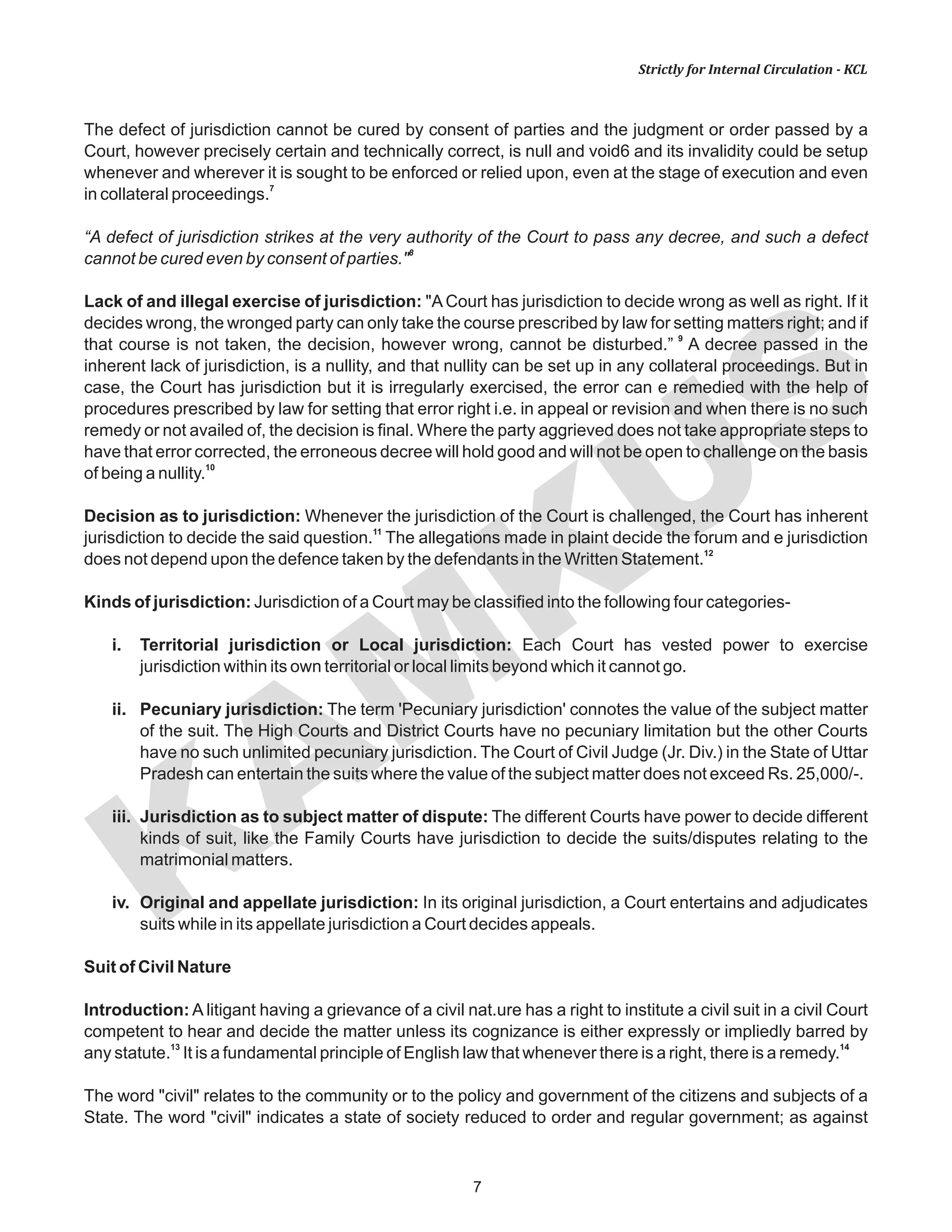
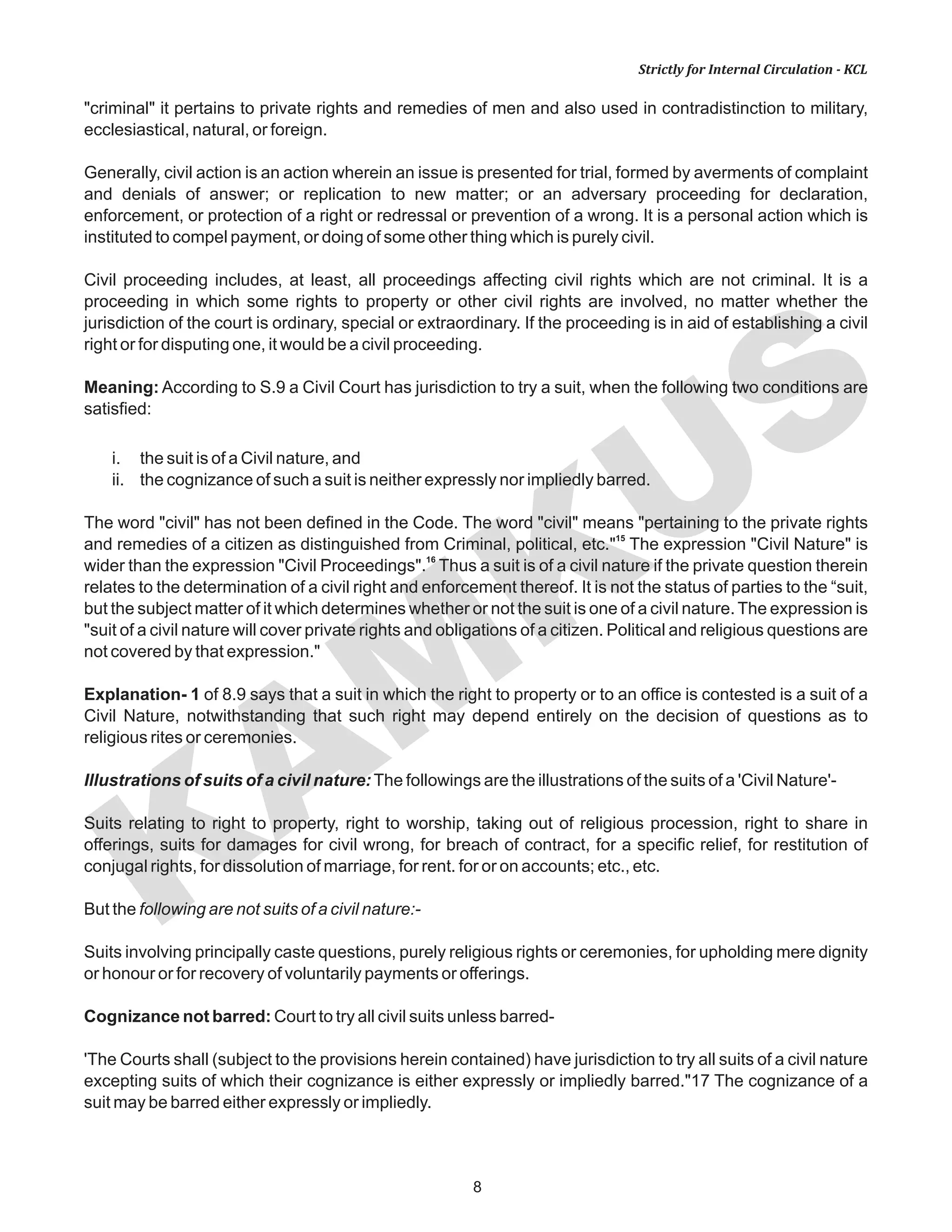
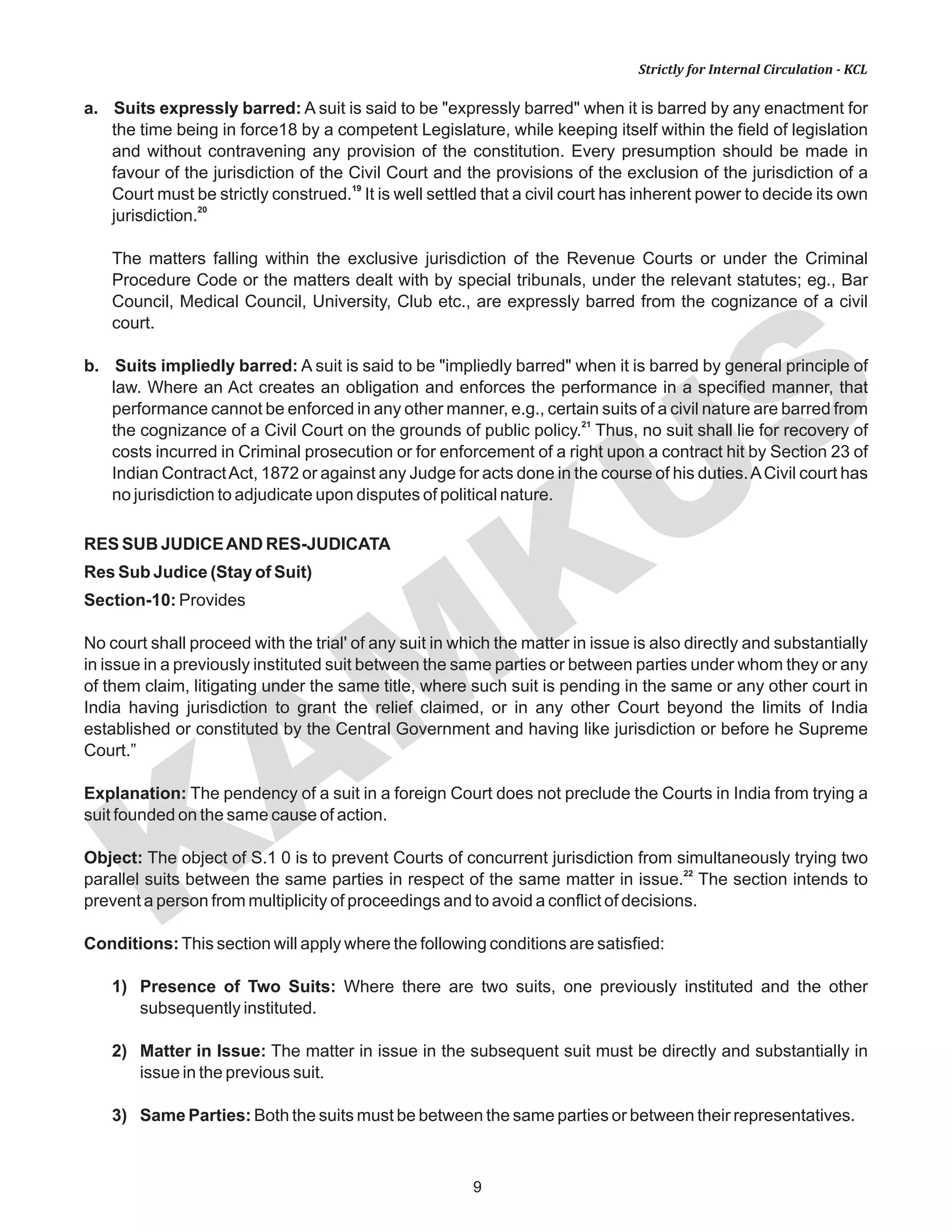
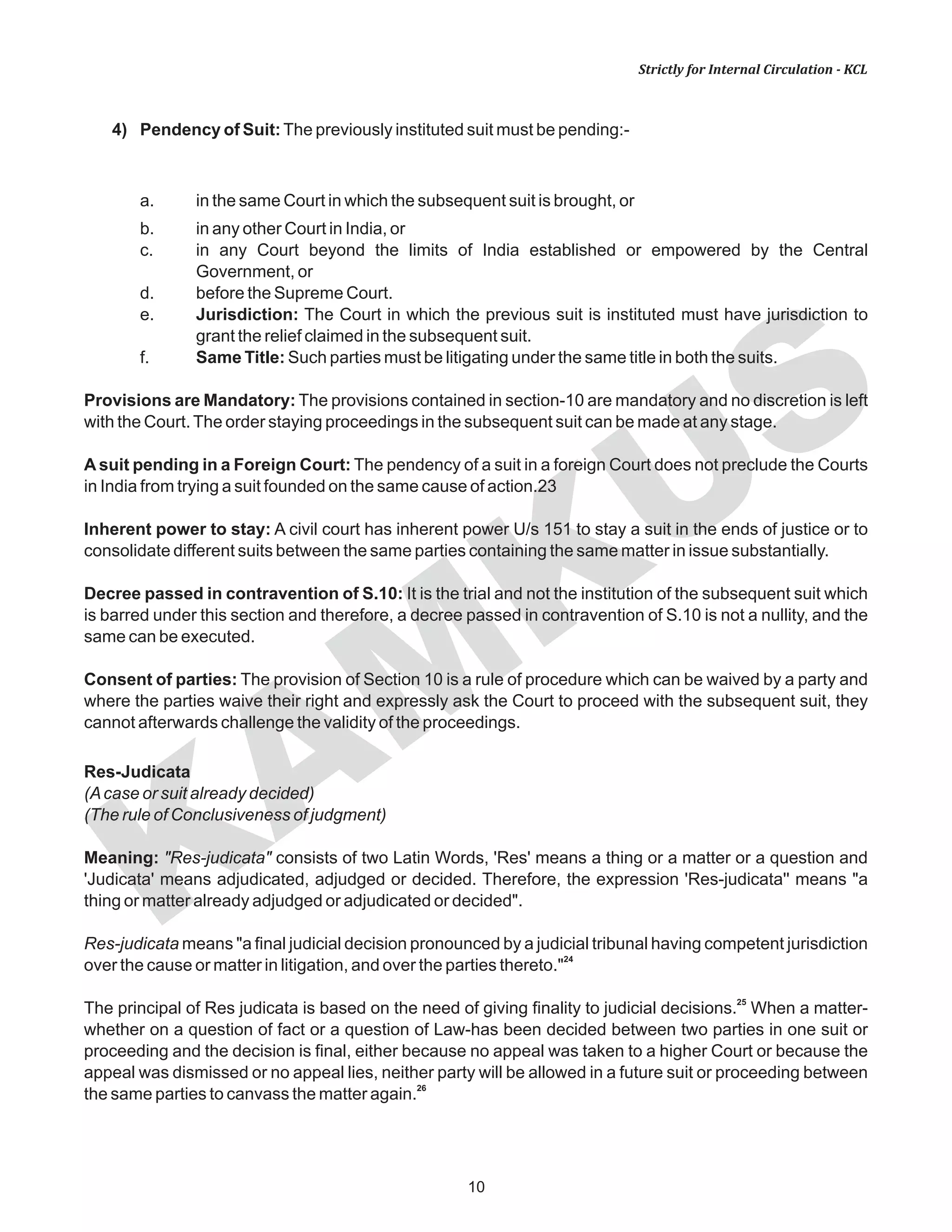
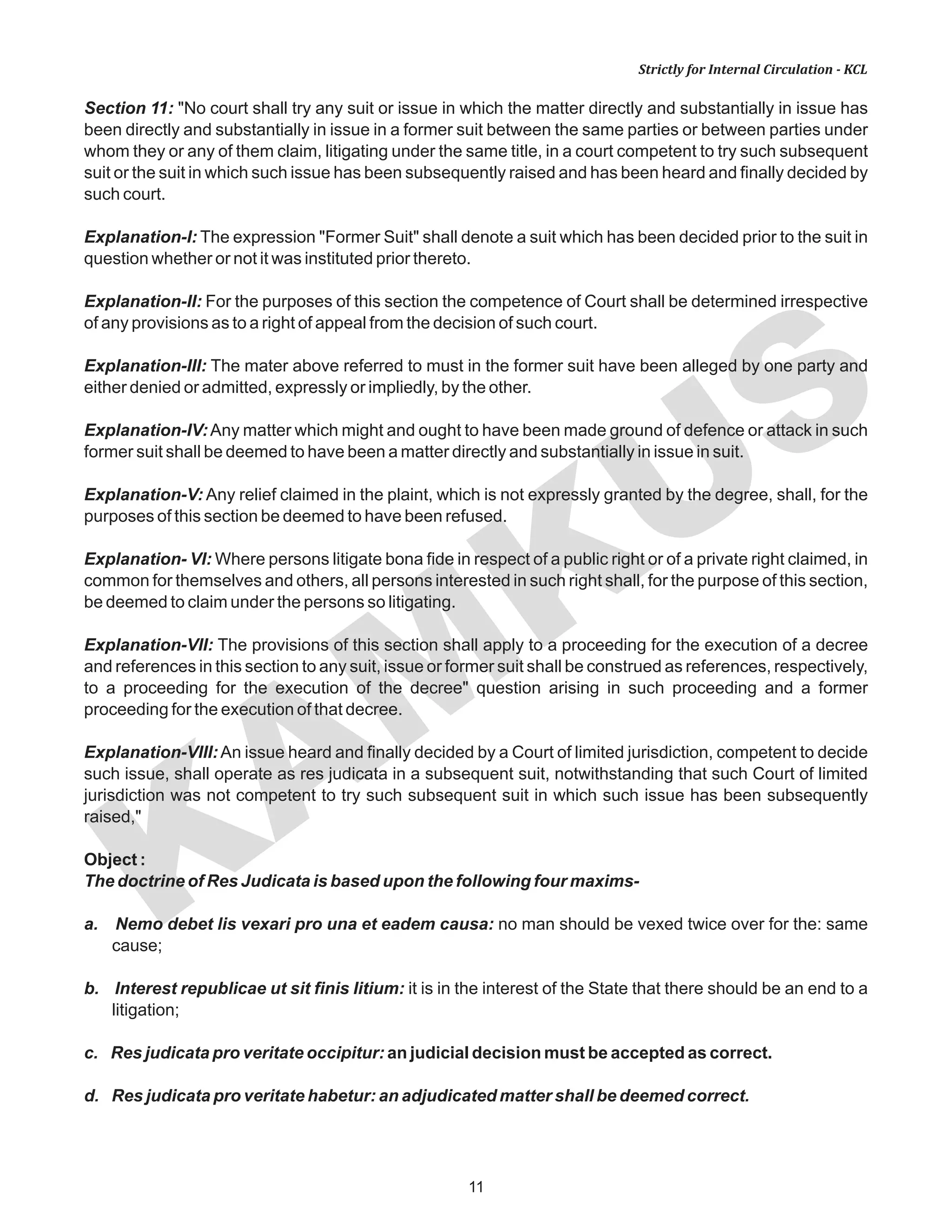

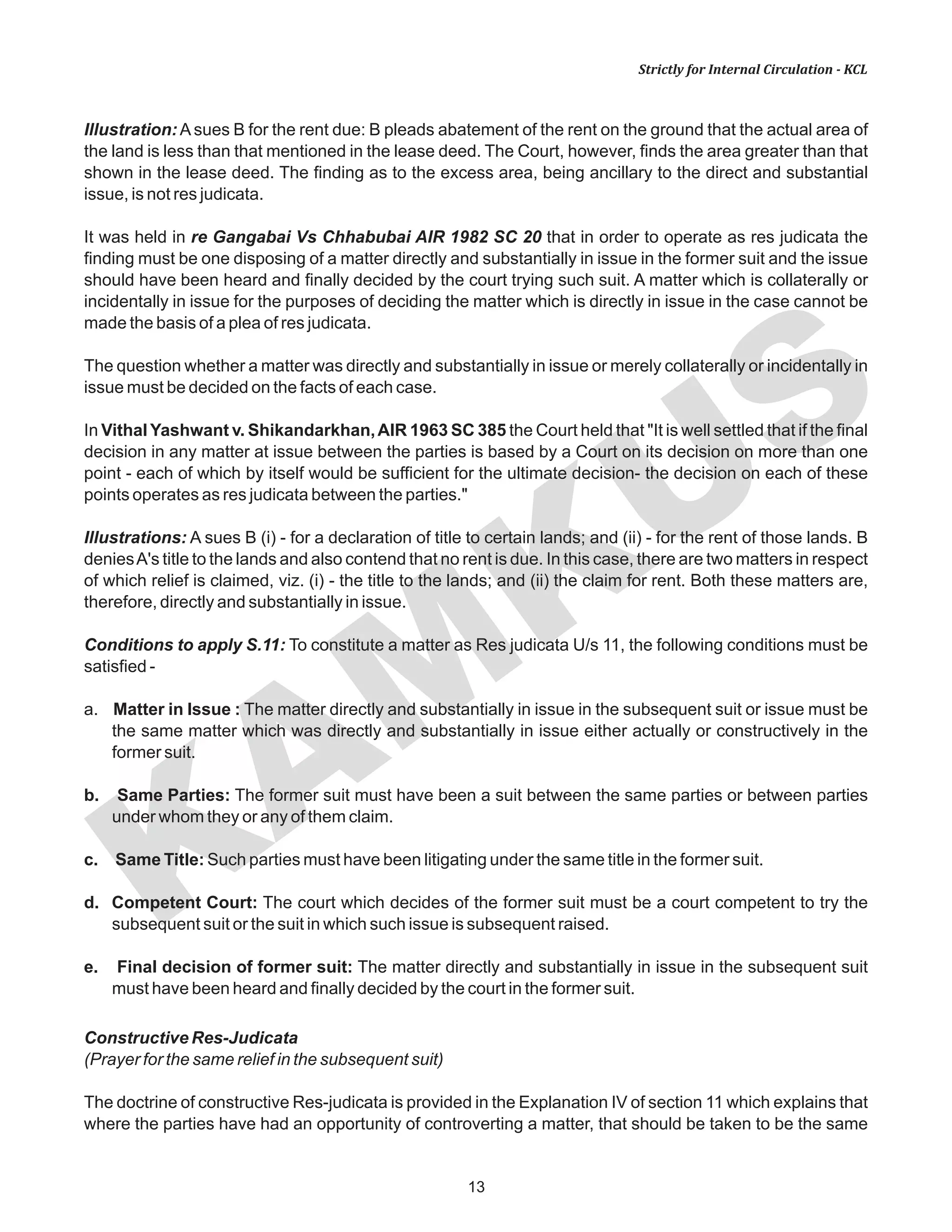
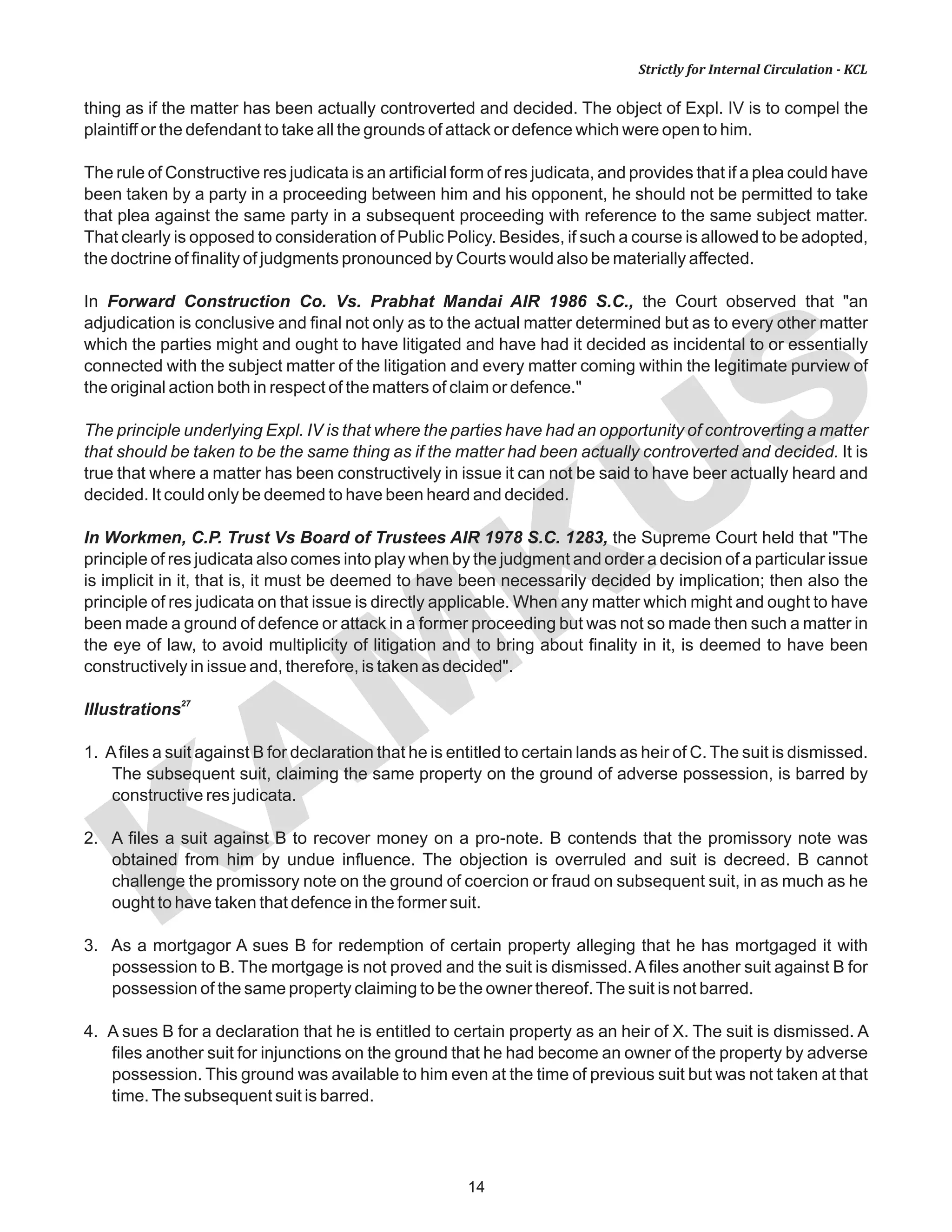
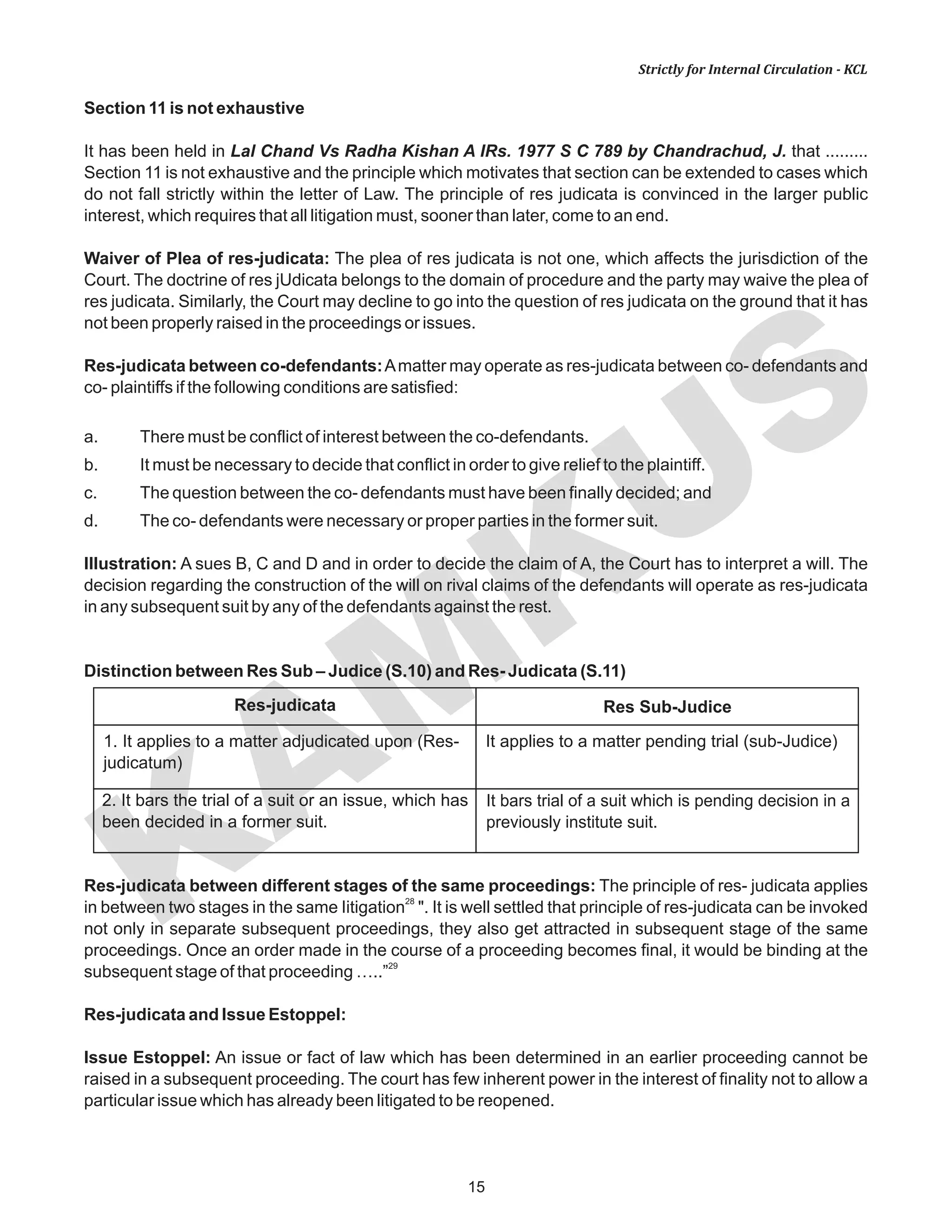
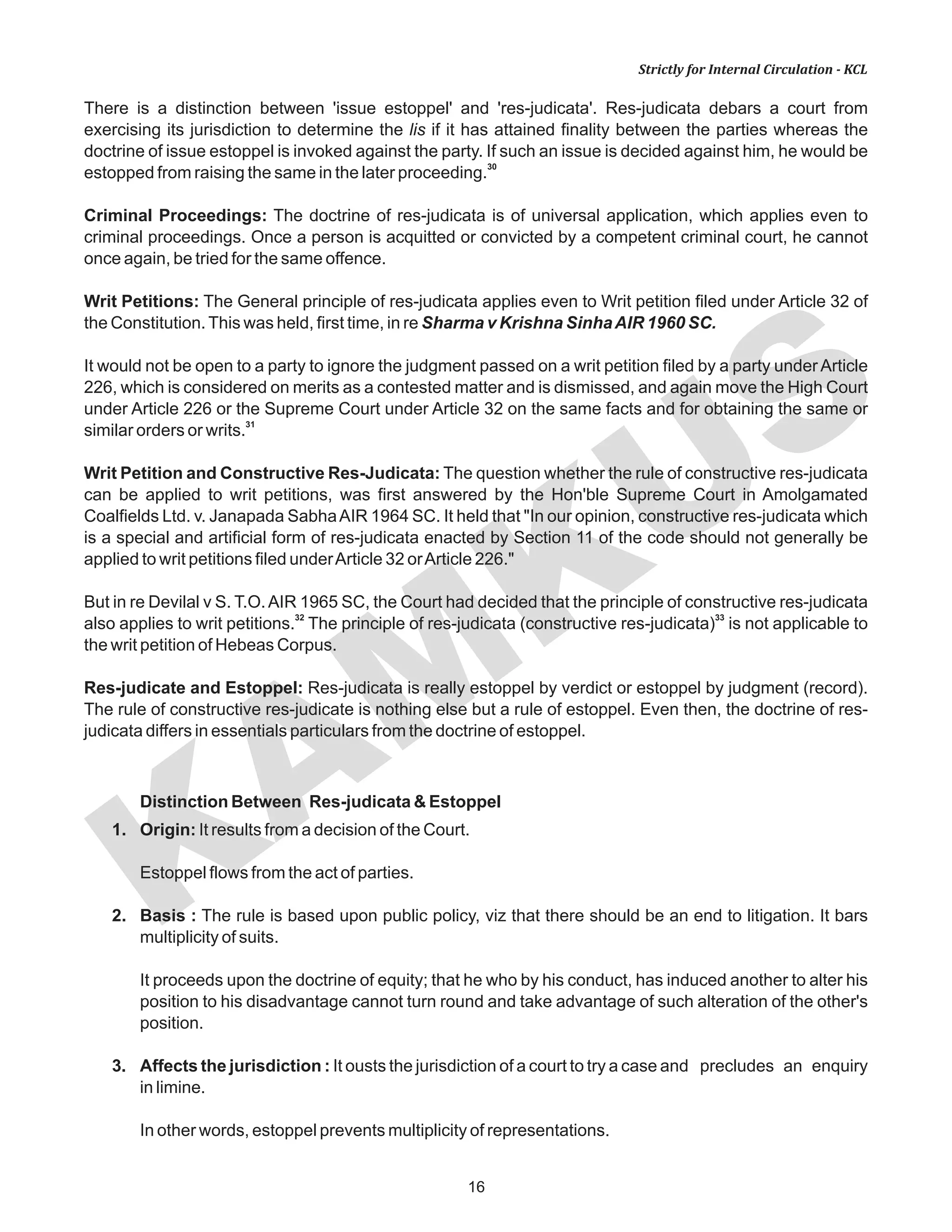
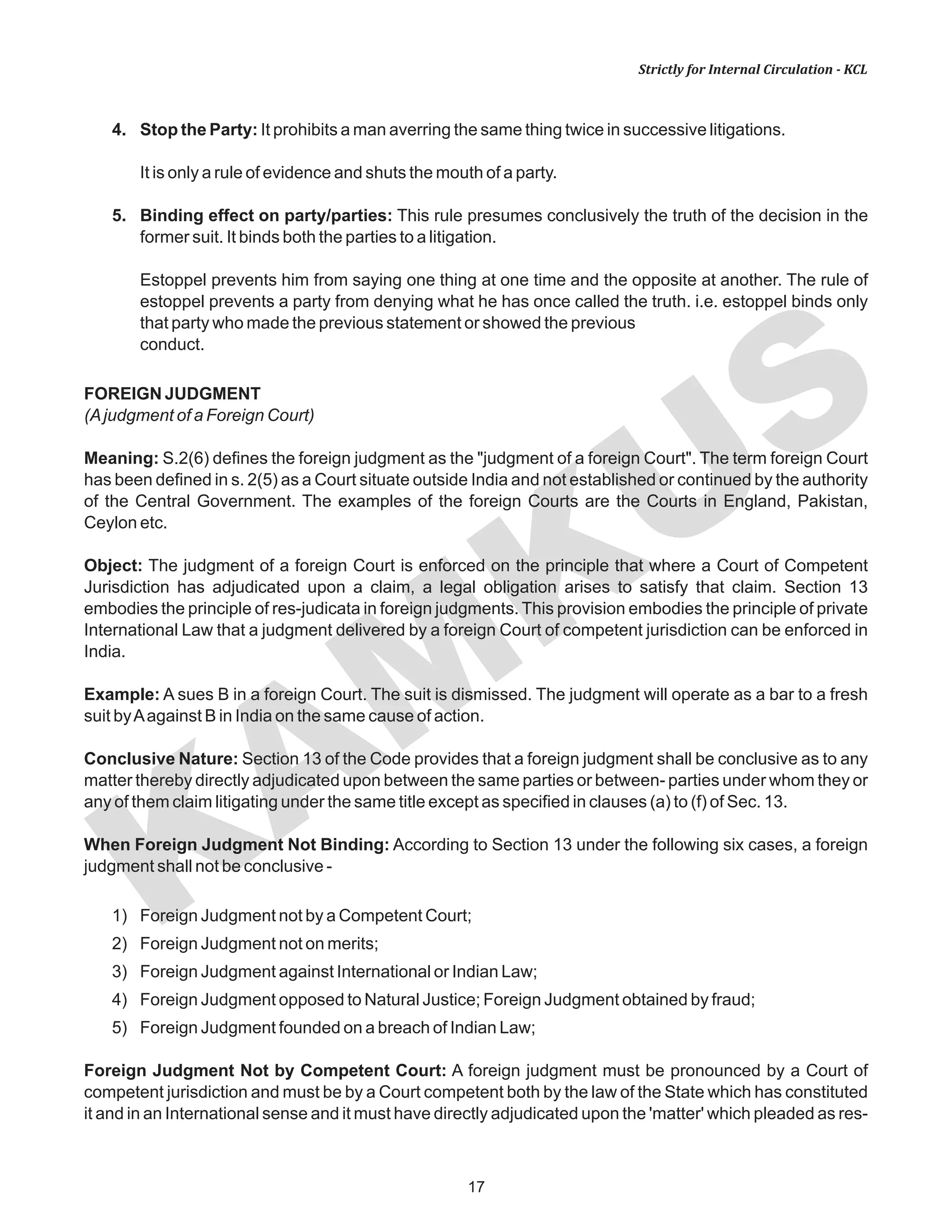
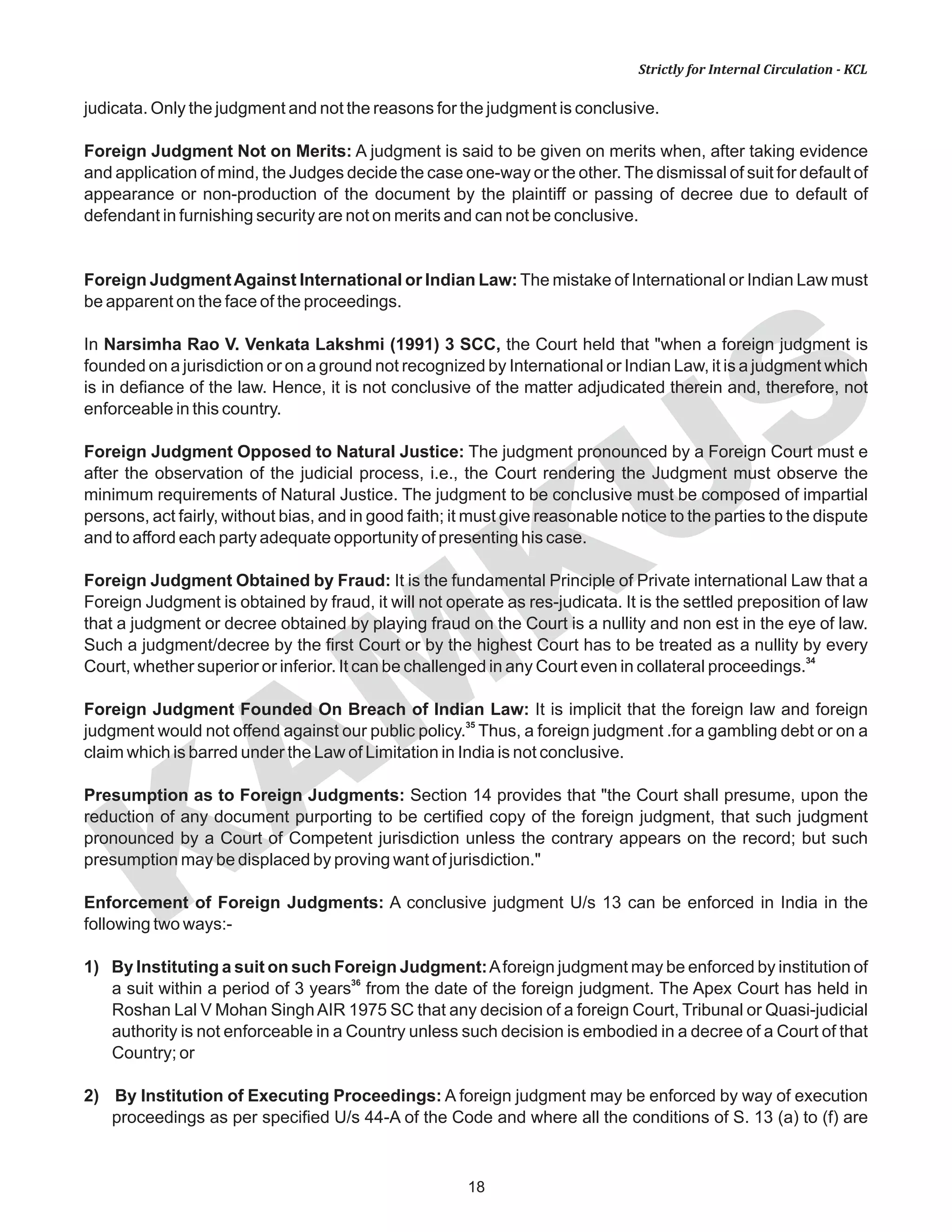
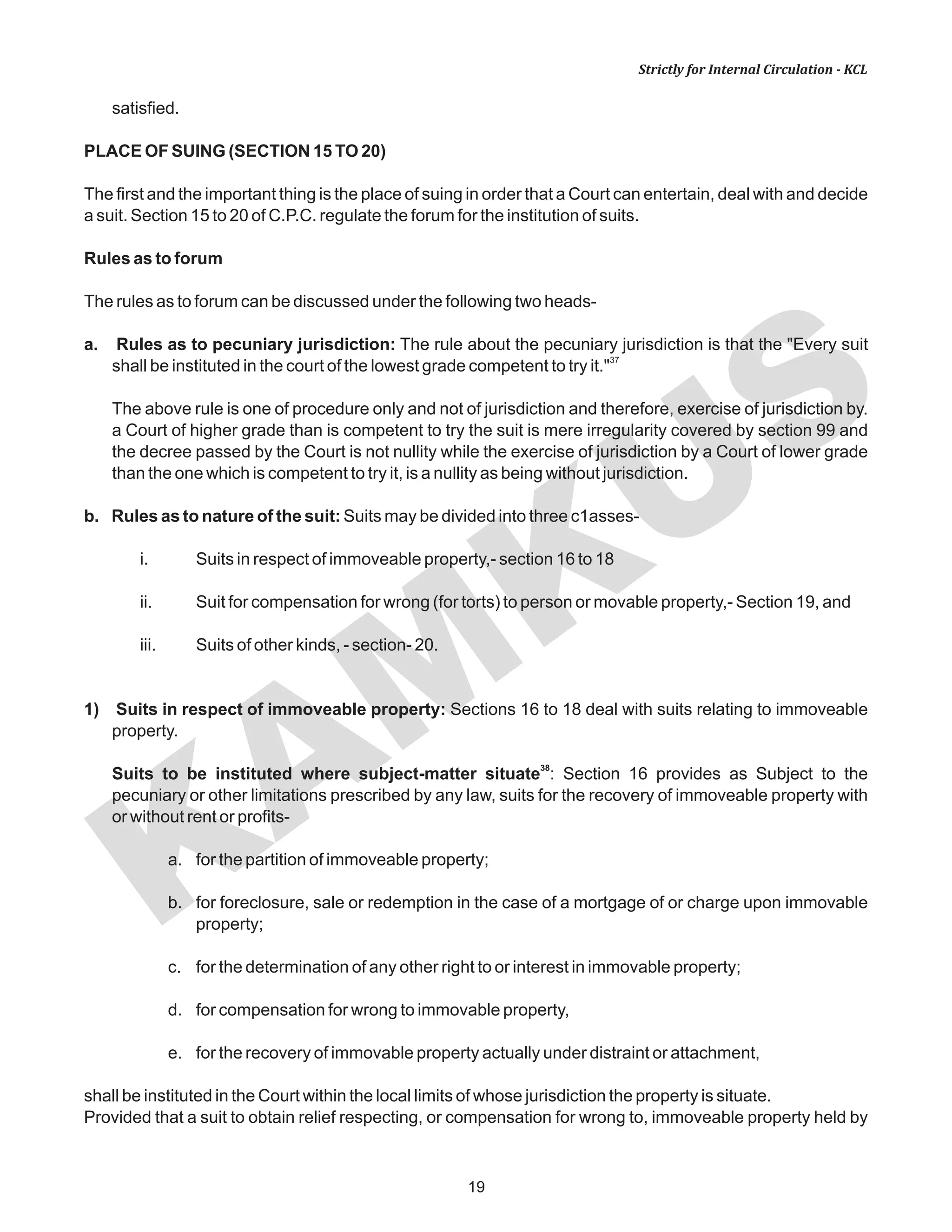
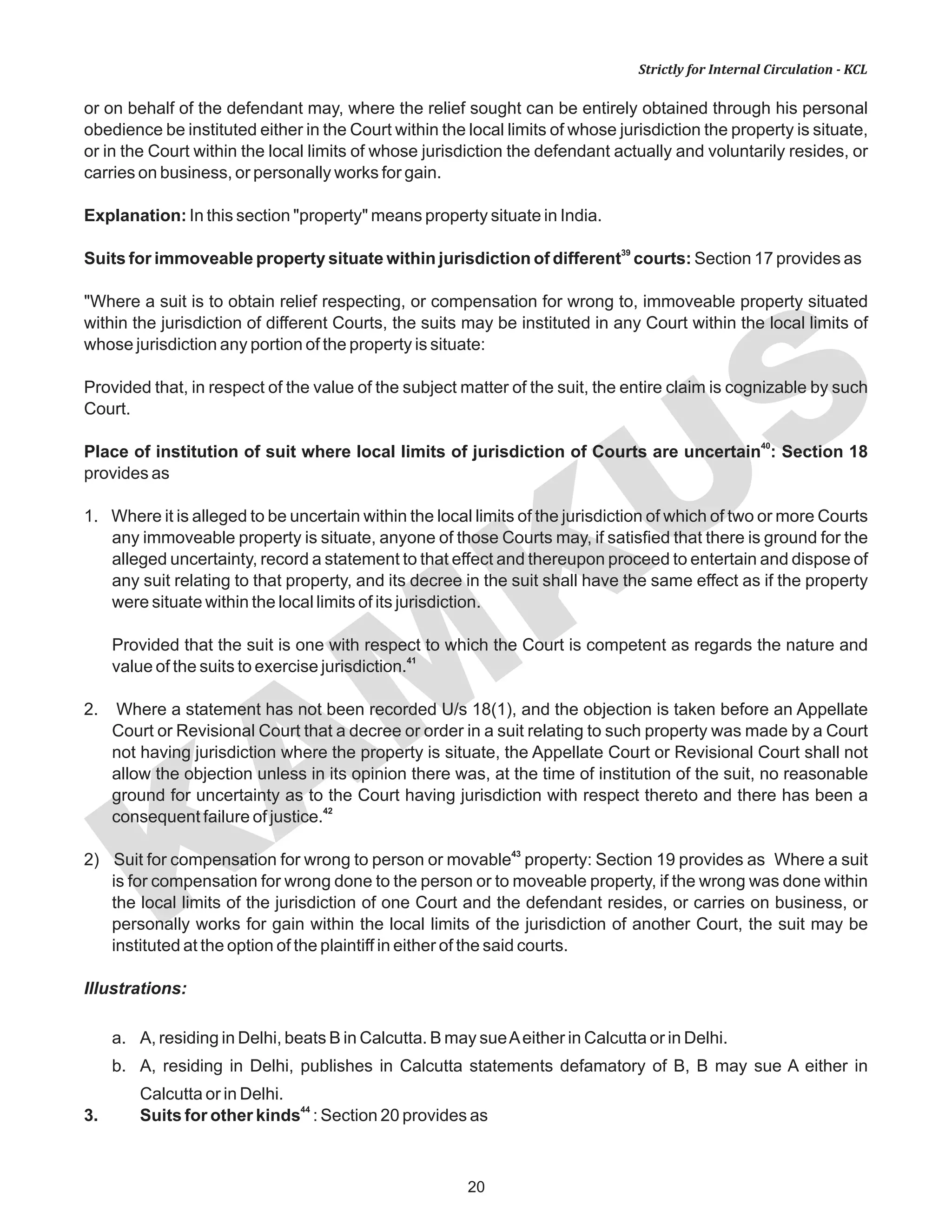
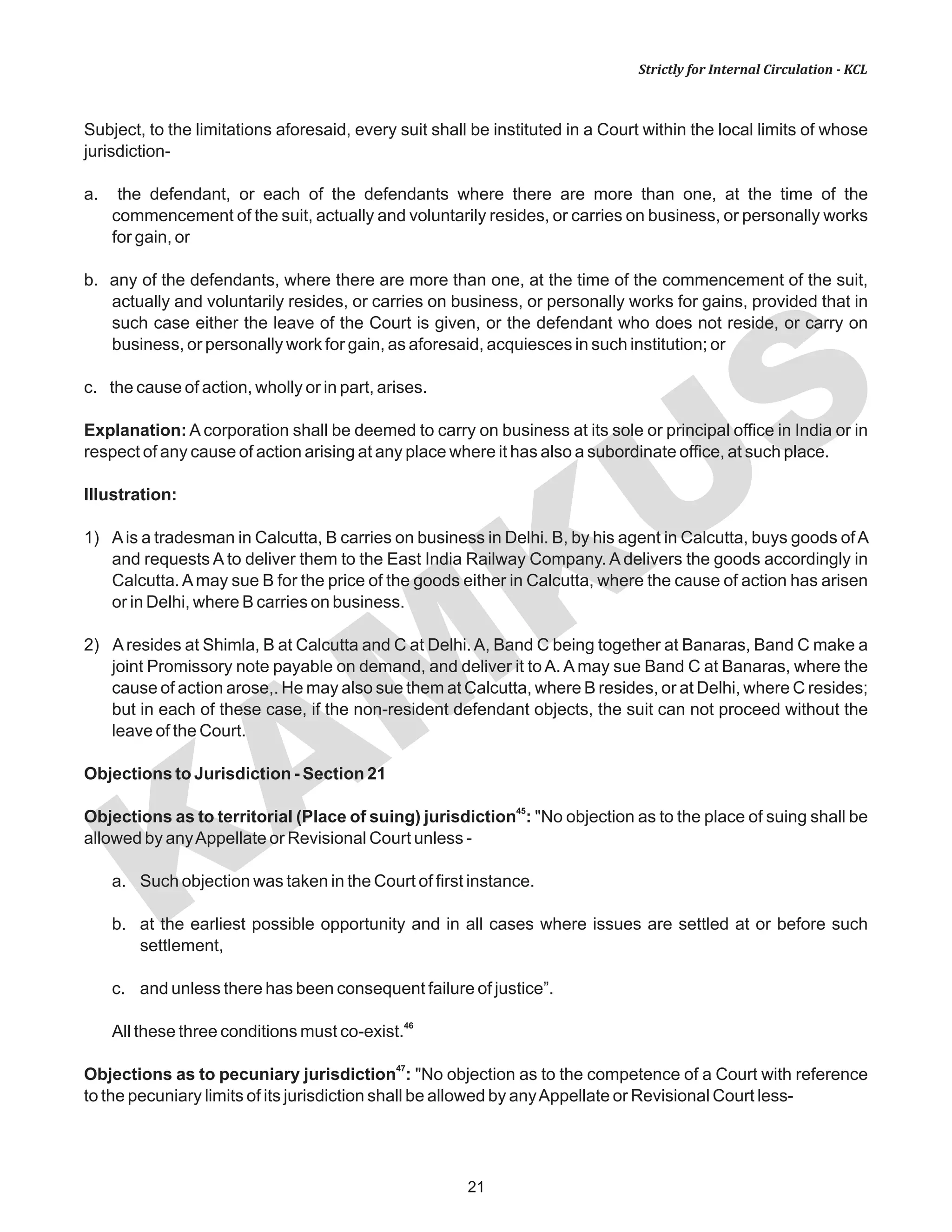
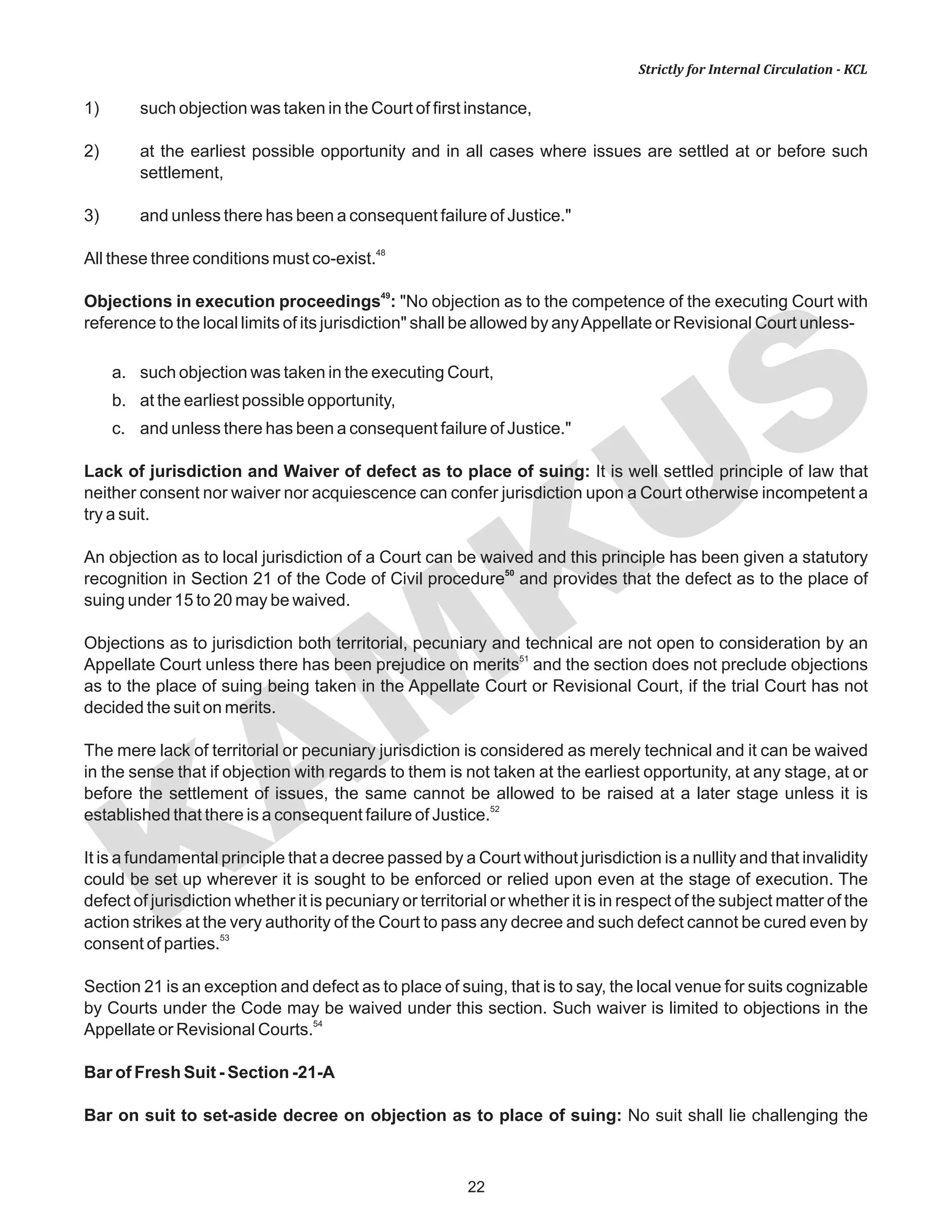
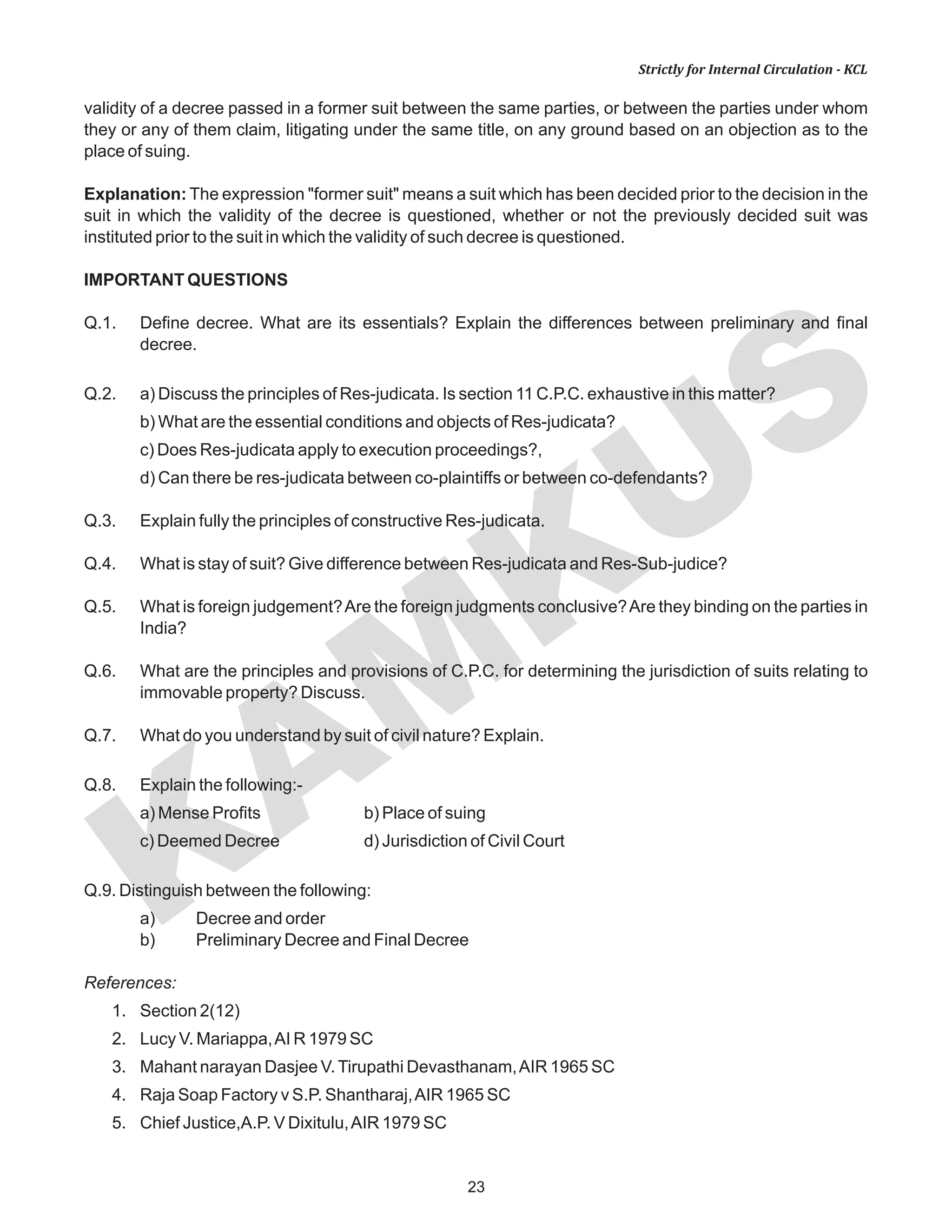
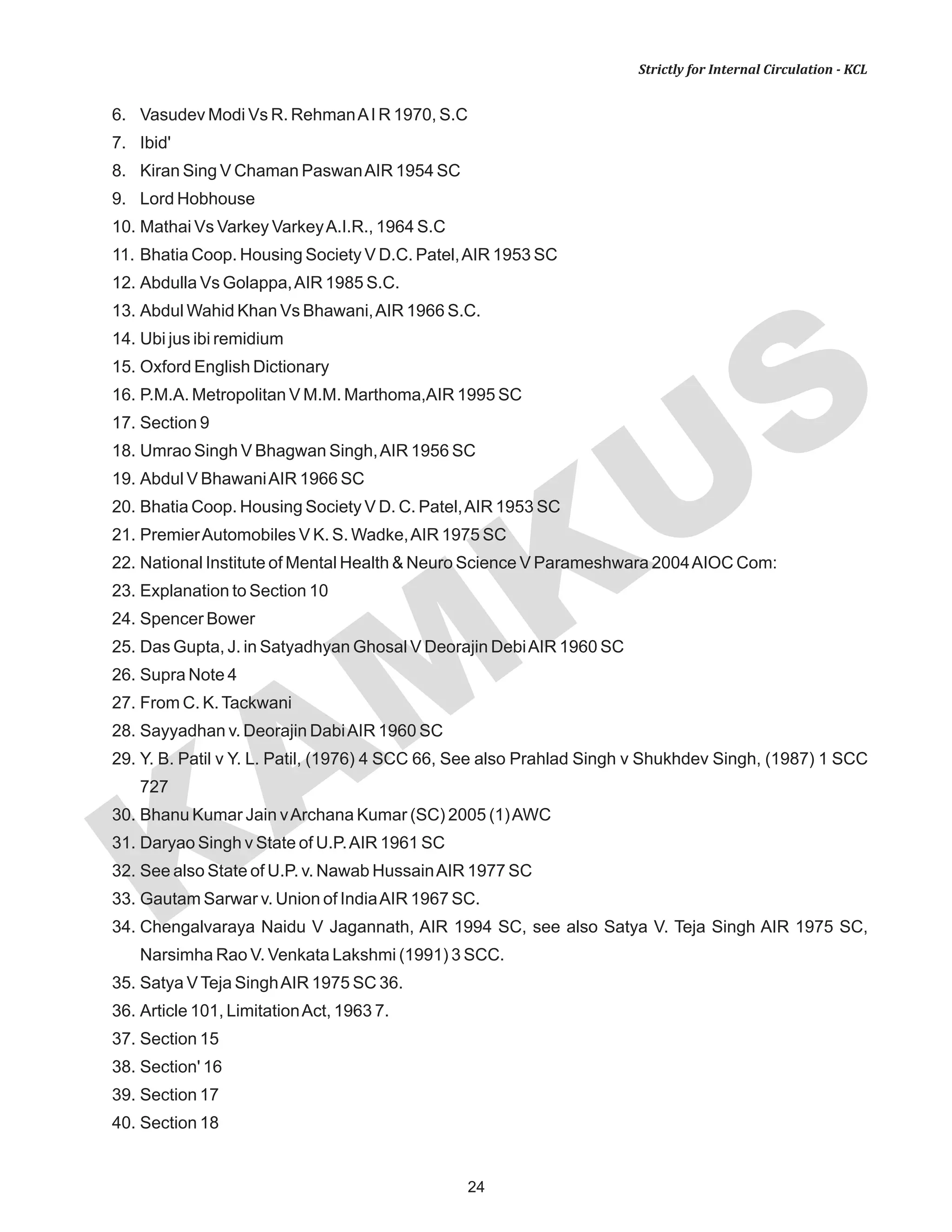
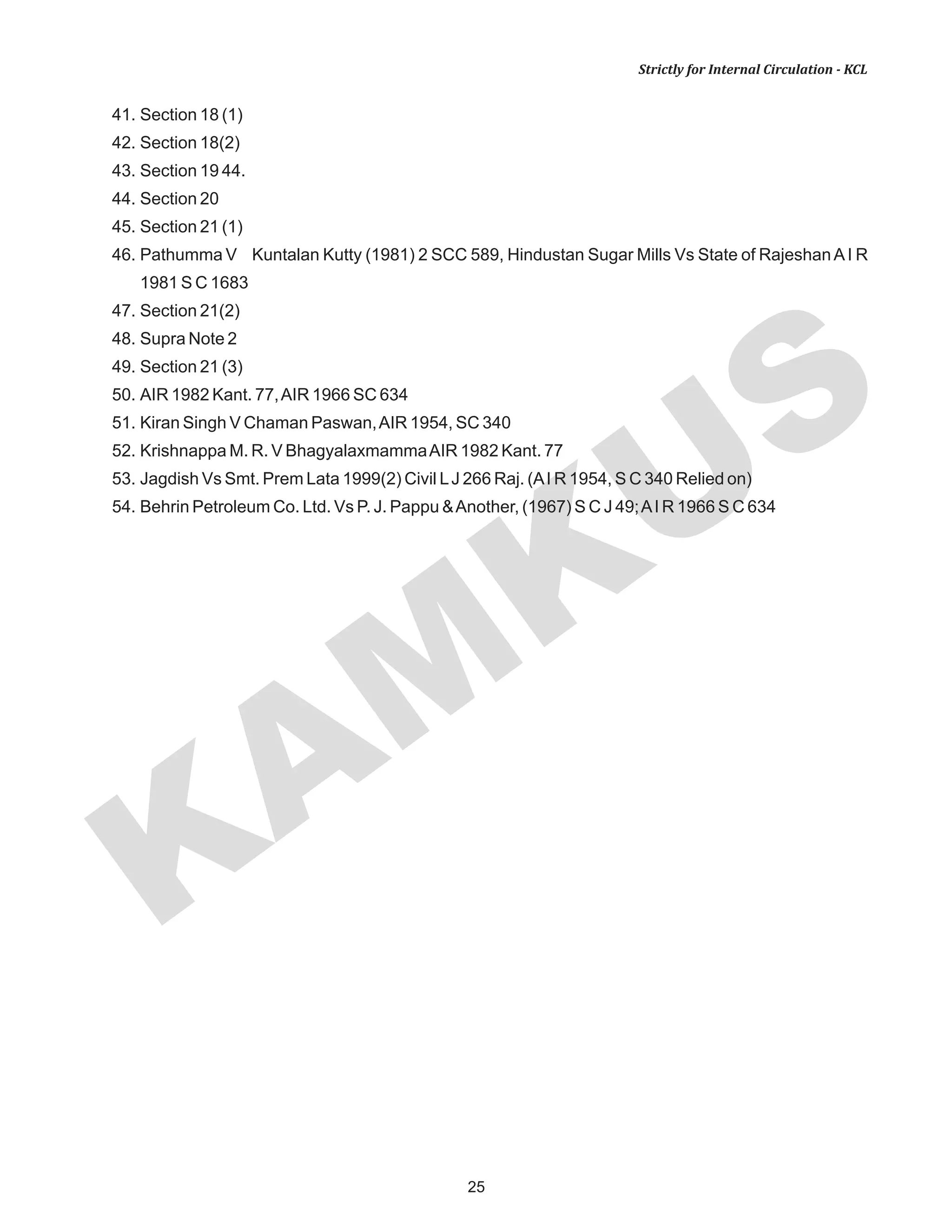
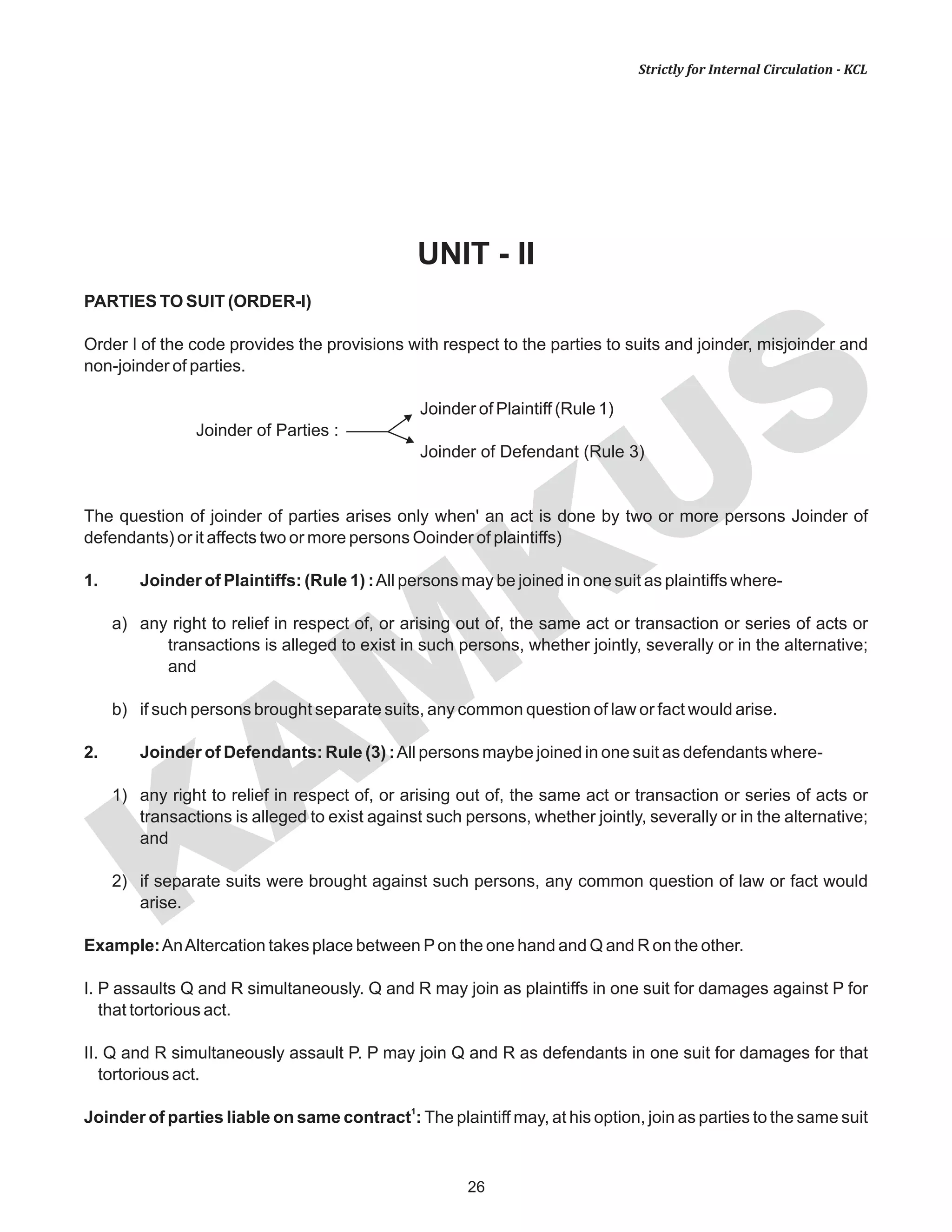
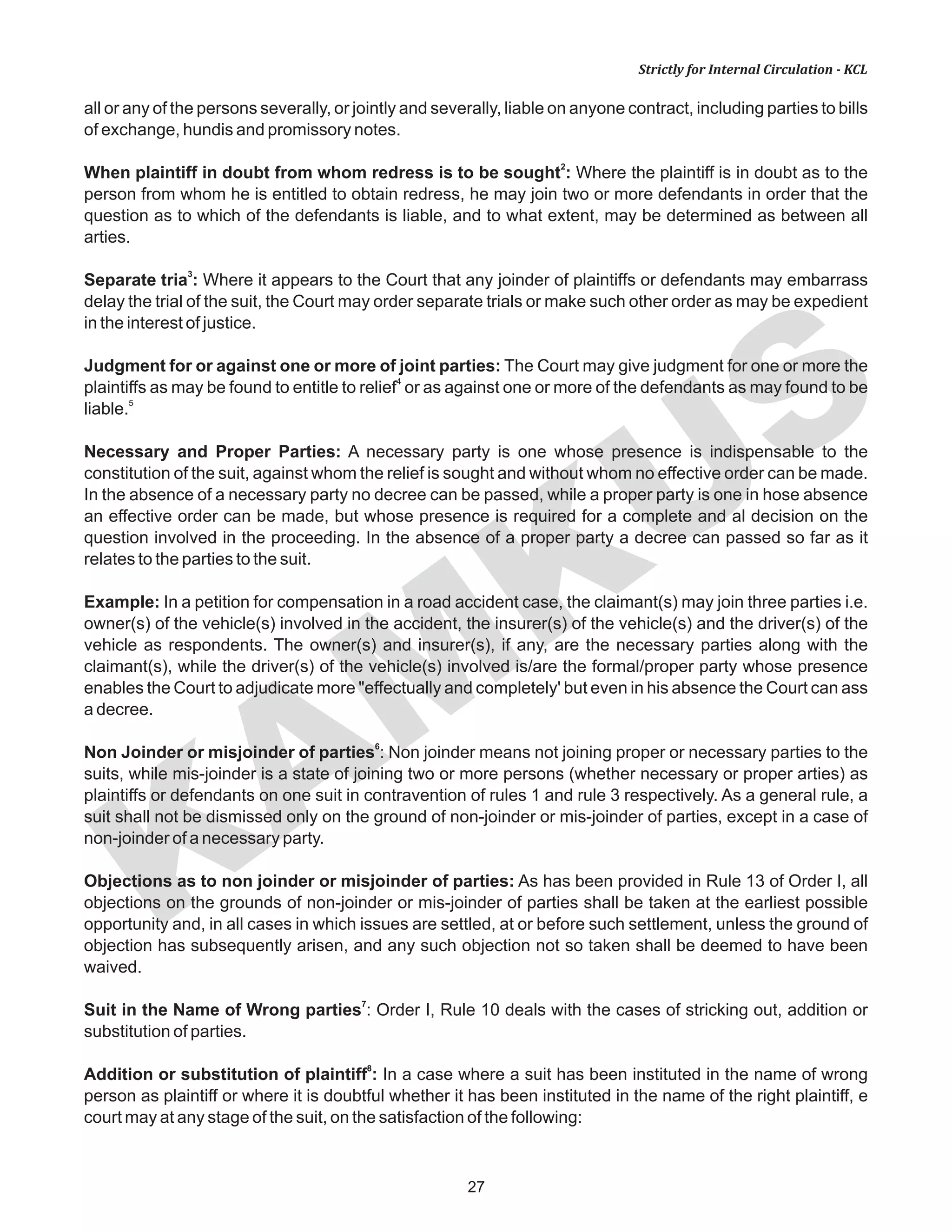
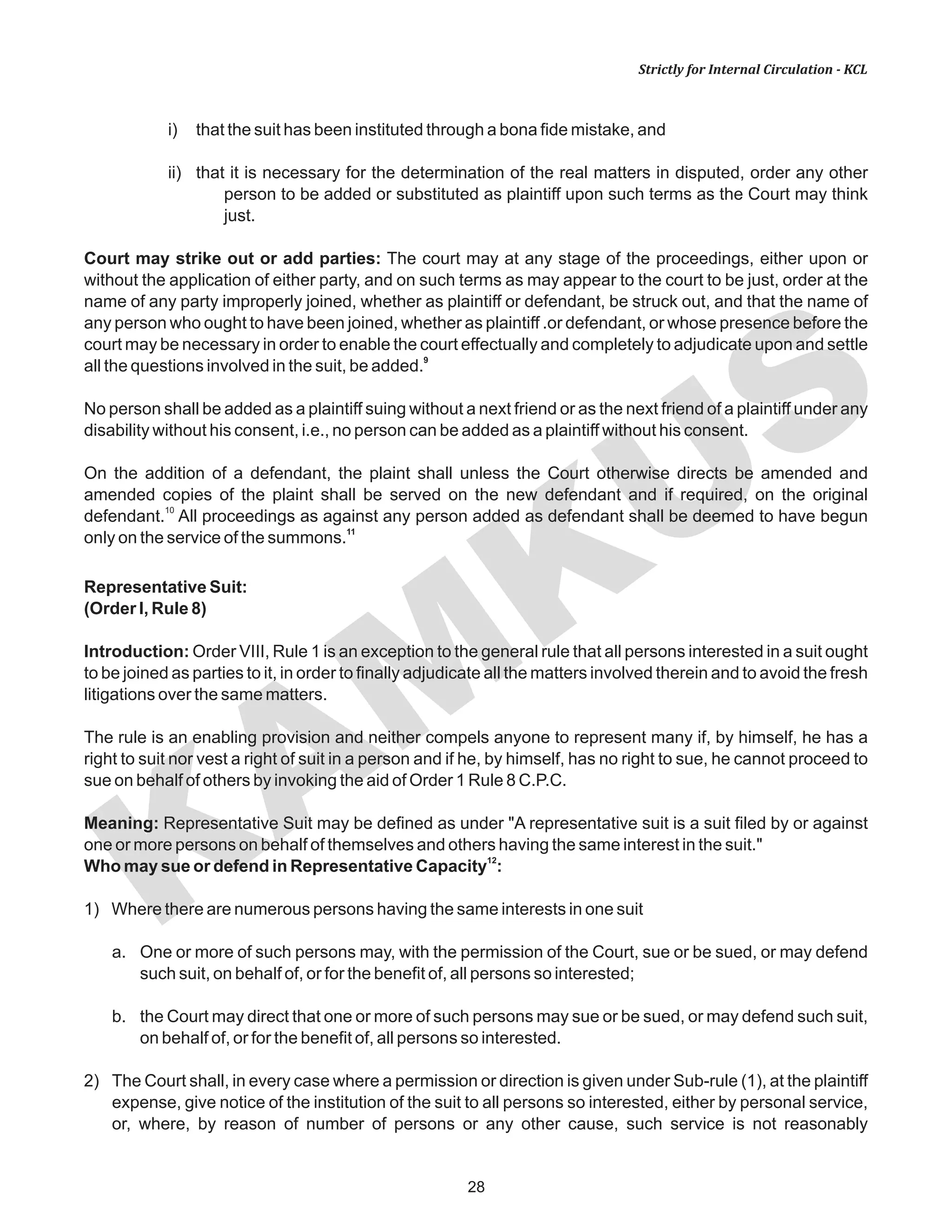
![KAM
KUS
29
Strictly for Internal Circulation - KCL
practicable, by public advertisement, as the Court in each case may direct.
3) Any person on whose behalf, or for whose benefit, a suit is instituted or defended, under Sub-rule (1),
may apply to the Court to be made a party to such suit.
4) No part of the claim in any such suit shall be abandoned under Sub- rule (1) and no such suit shall be
withdrawn under Sub- rule (3) of Rule (1) of Order XXIII, Le. Order 23, Rule 1 (3), and no agreement,
compromise or satisfaction shall be recorded in any such suit under Rule (3) of that Order, unless the
Court has given, at the plaintiff's expense, notice to all persons so interested in the manner specified in
sub-rule (2).
5) Where any person suing or defending in any suit does not proceed with due diligence in the suit or
defence, the Court may substitute in his place any other person having the same interest in the suit.
6) A decree passed in a suit under this rule shall be binding on all persons on whose behalf, or for whose
benefit, the suit is instituted, or defended, as the case may be.
Explanation: For the purpose of determining whether the persons who sue or are sued, or defend, have
the same interest in one suit, it is not necessary to establish that such persons have the same cause of
action as the" persons on whose behalf, or for whose benefit, they sue or are sued or defend the suit, as the
case may be.
Conditions to Apply Rule 8 : The Apex Court has decided in T. N. Housing Board v. Ganapathy, AIR
1990 SC that for the application of Rule 8 the following conditions must be fulfilled:-
a. the parties must be numerous; Rule 8(1)
b. they must have the same interest in the suit; Rule 8(1)
c. the permission must have been granted [Rule 8(1) (a)] or direction must have been given by
the Court [Rule 8( 1) (b)]; and
d. notice must have been issued to the parties whom it is proposed to represent in the suit.
Rule 8(2)
1) Numerous persons: The word" numerous" means a group of persons. It is not necessary that the
number of persons should be capable of being ascertained. But it is necessary that the body of
persons represented by the plaintiffs or the defendants must be sufficiently definite so as to enable
the Court to recognize as participants in the suit.
2) Same Interest: The persons on whose behalf the suit is instituted must have the same interest
which is common to all of them or they must have a common grievance which they seek to get
redressed.
For the purpose of this condition the above explanation to Rule 1 is relevant.
13
3) Permission or direction by the Court
4) Notice 14: The fact about the representative nature of the suit must be stated in the body of the](https://image.slidesharecdn.com/cpc-smartnotes-190508082159/75/Cpc-smart-notes-31-2048.jpg)
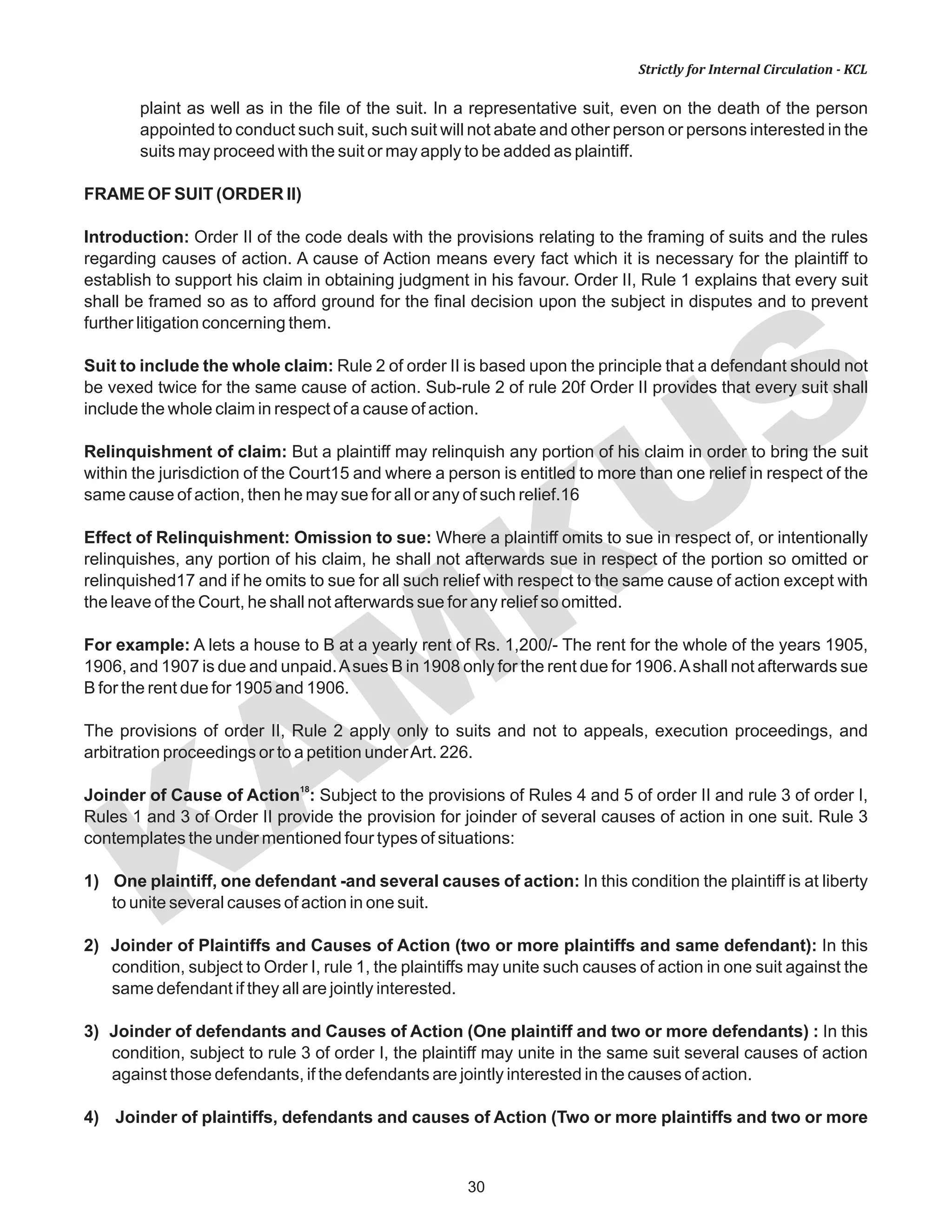
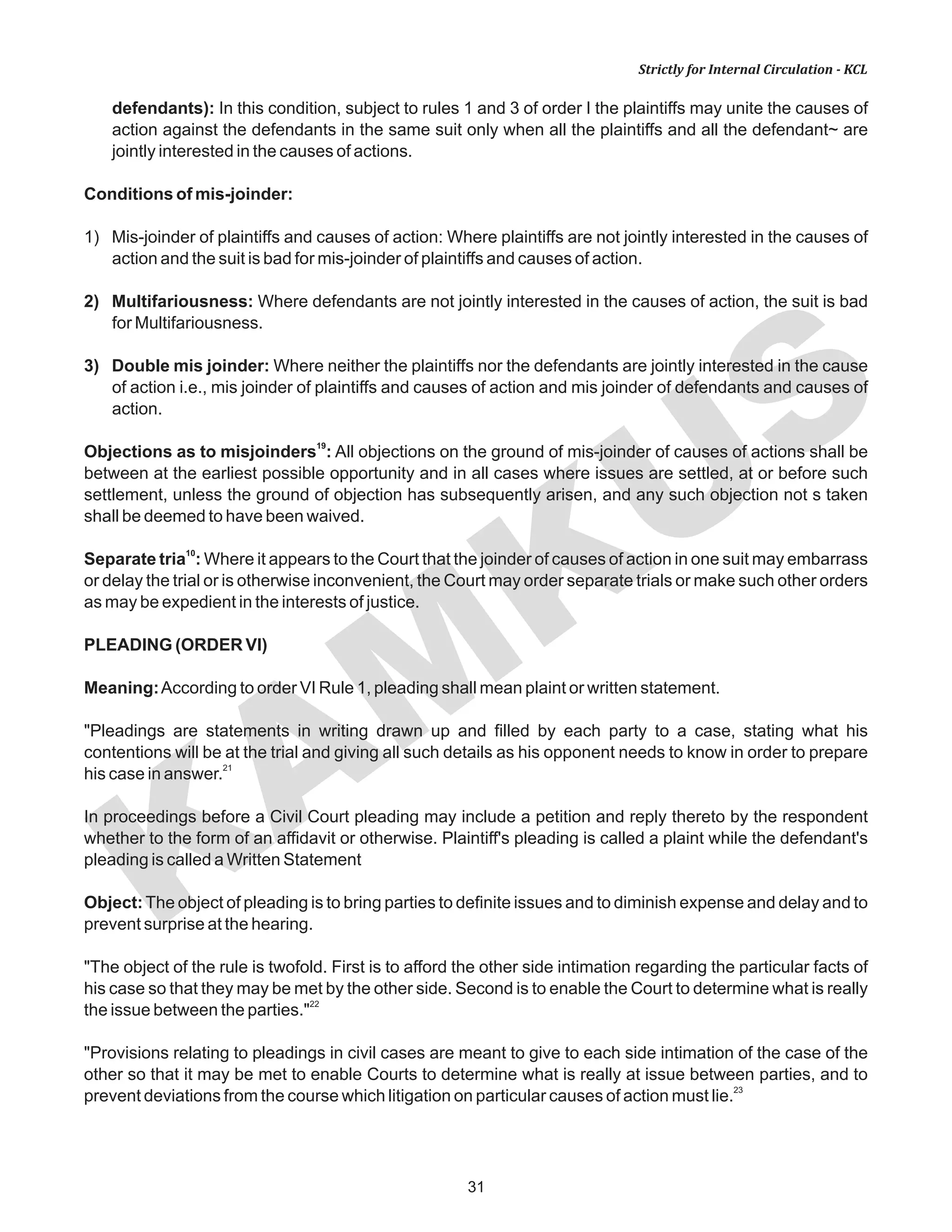
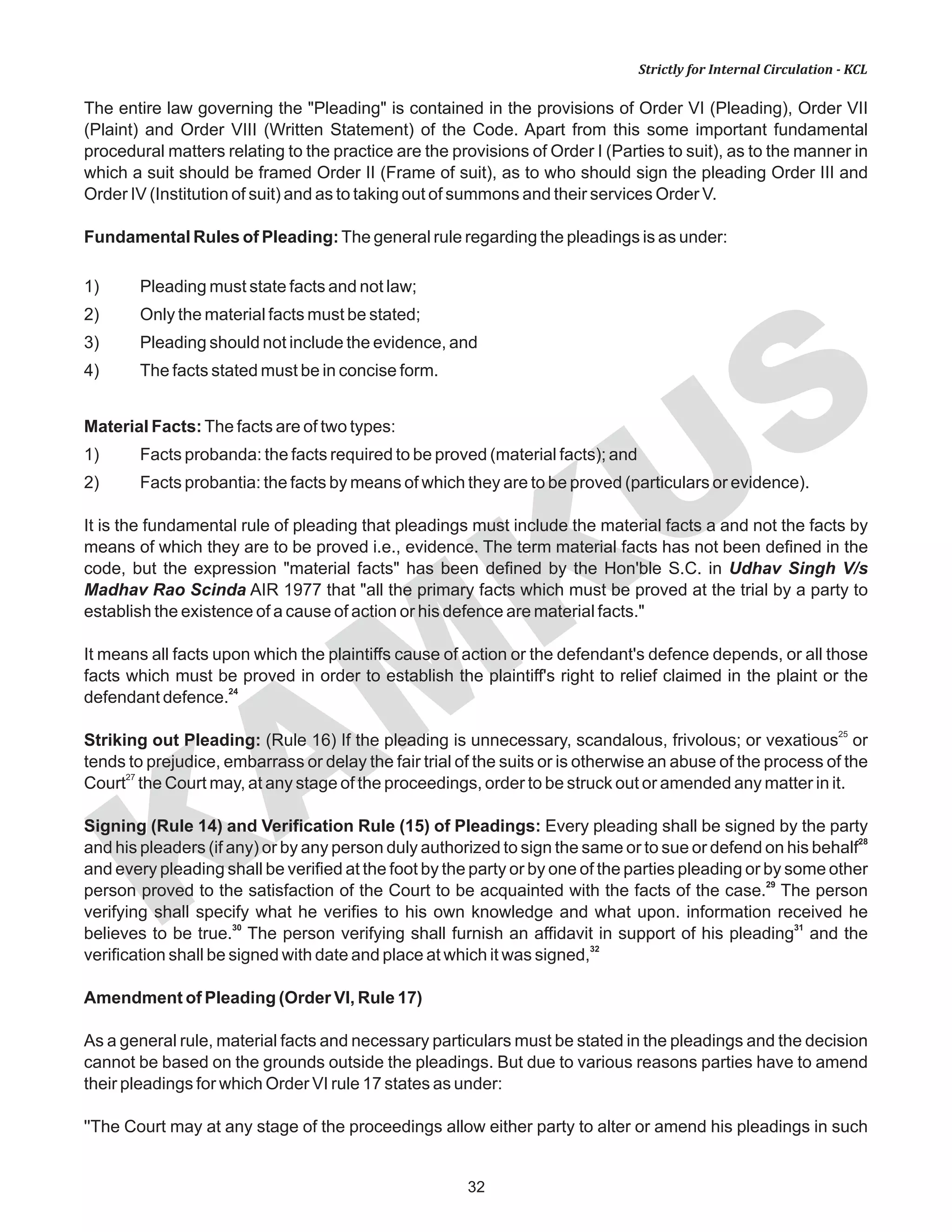
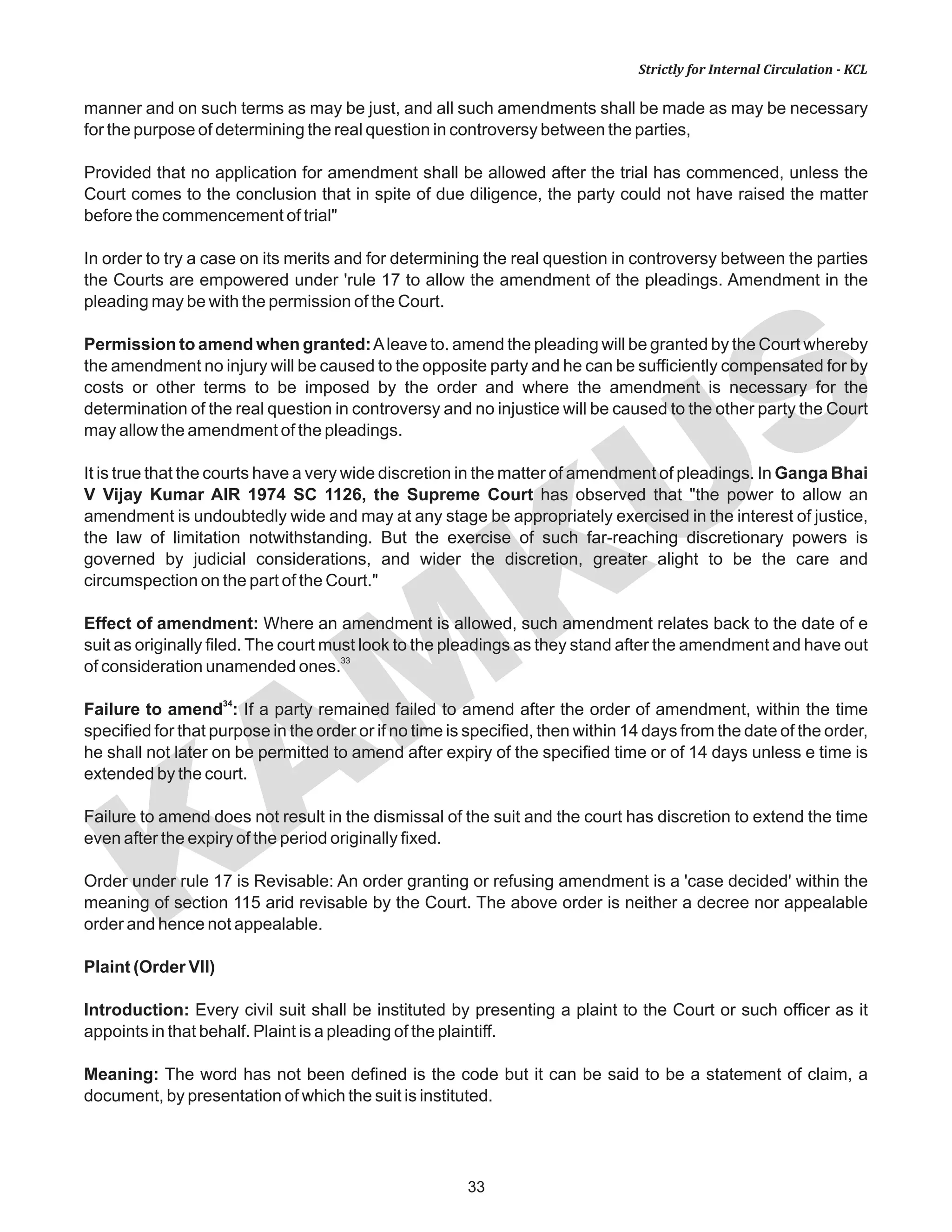

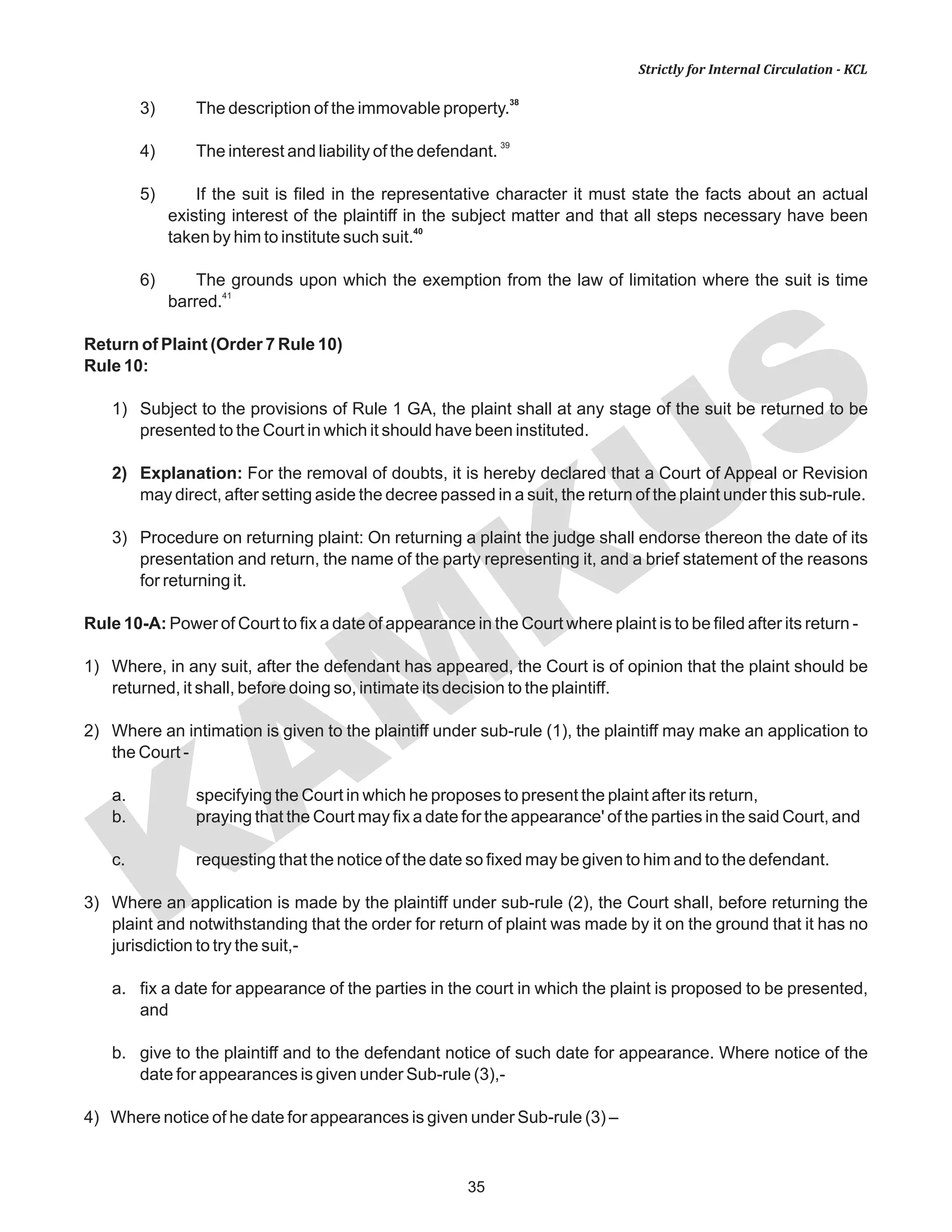
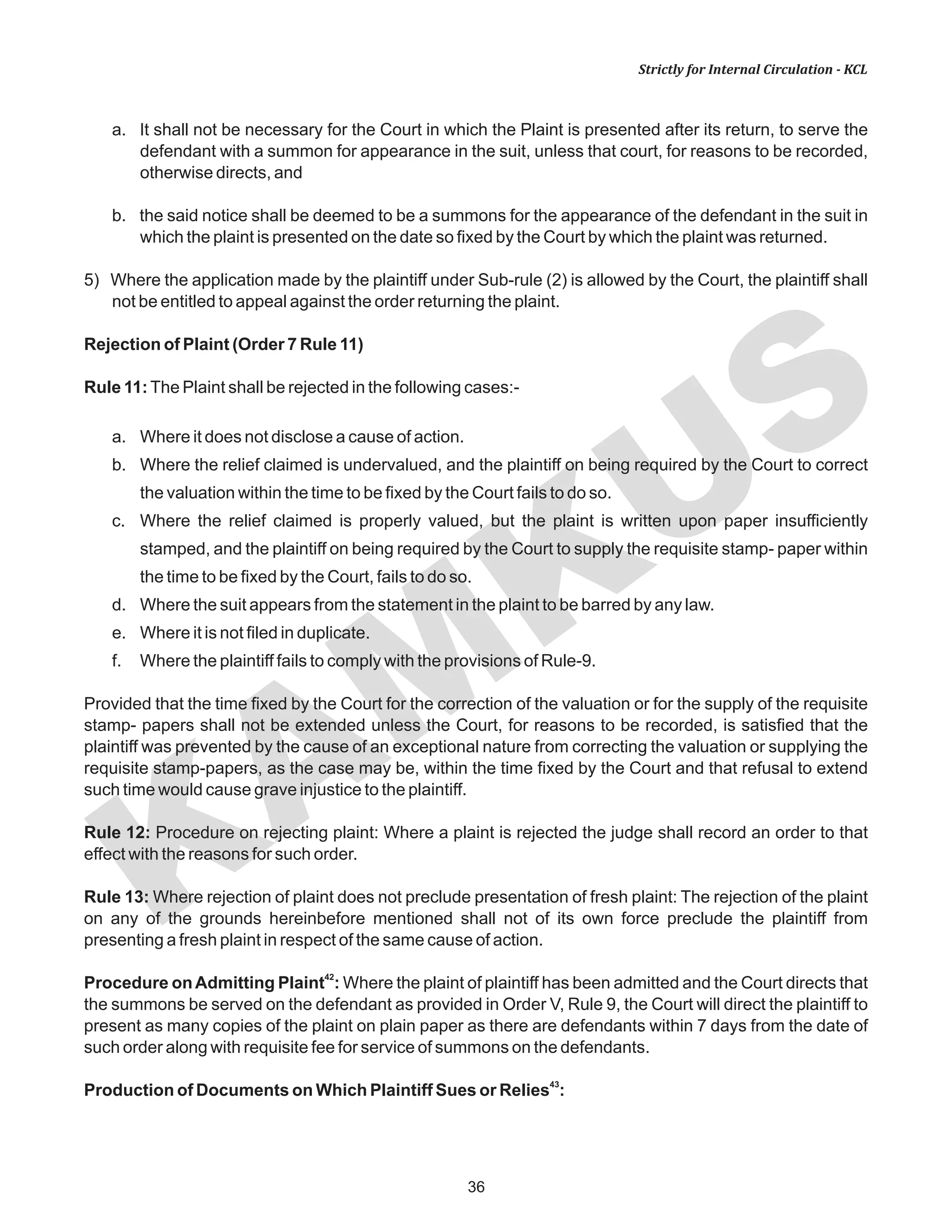

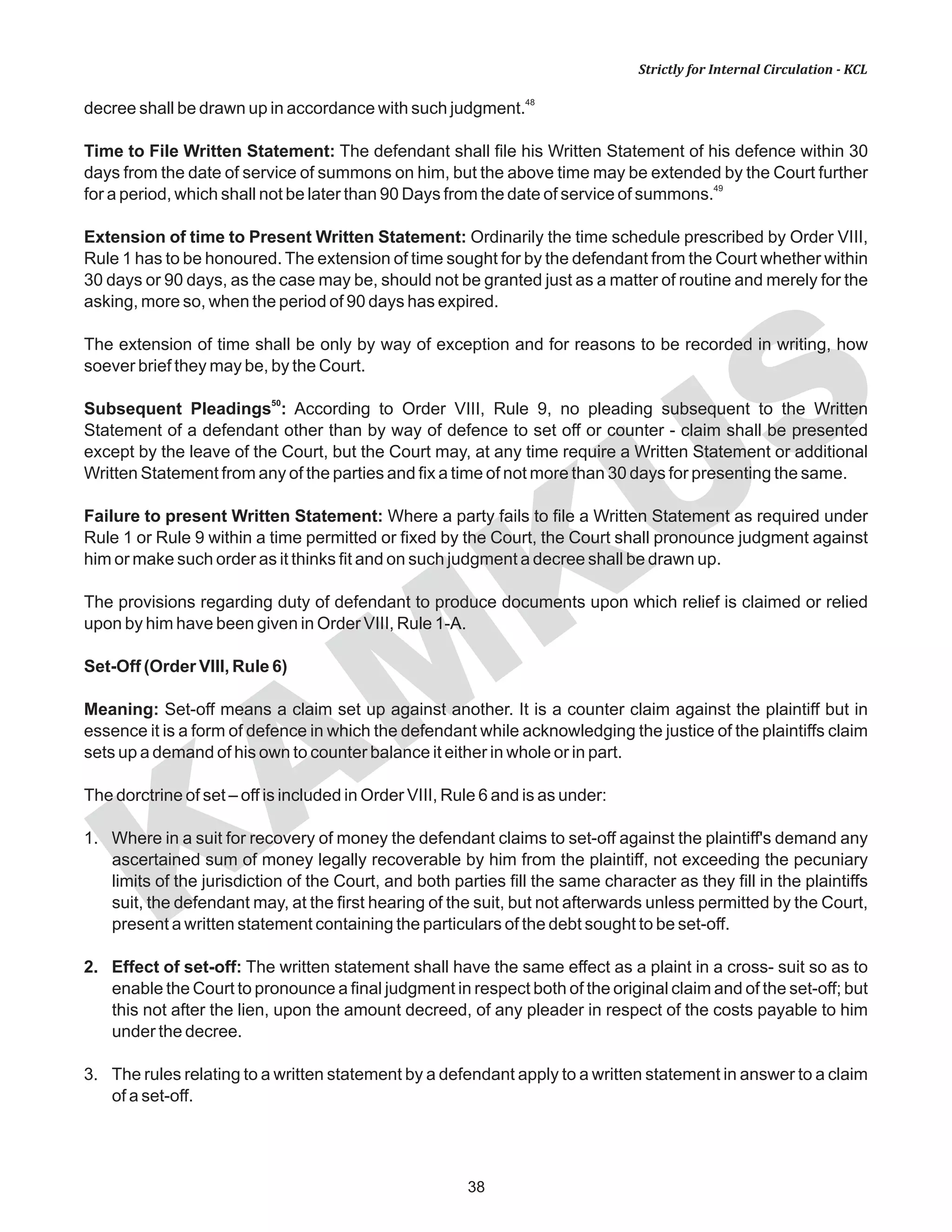
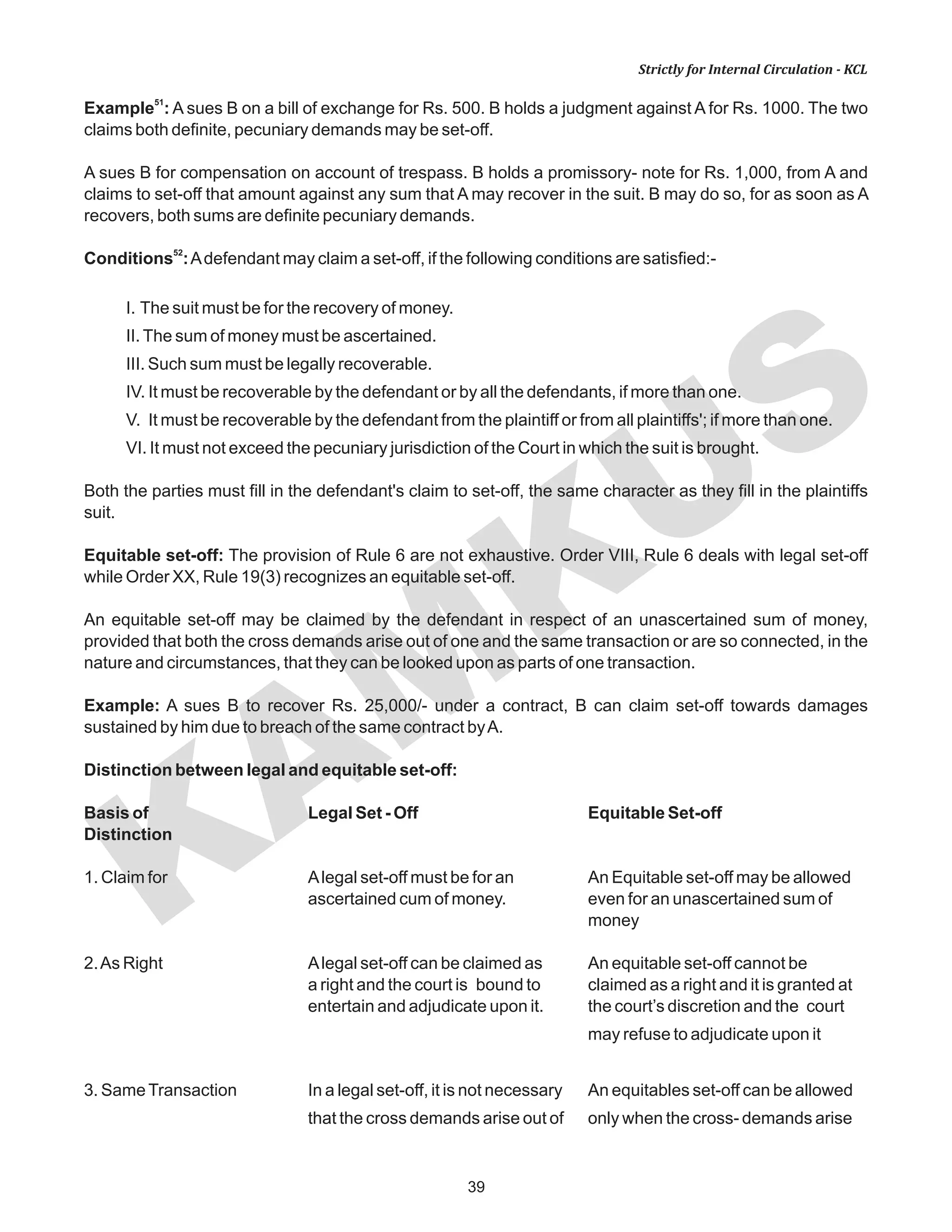
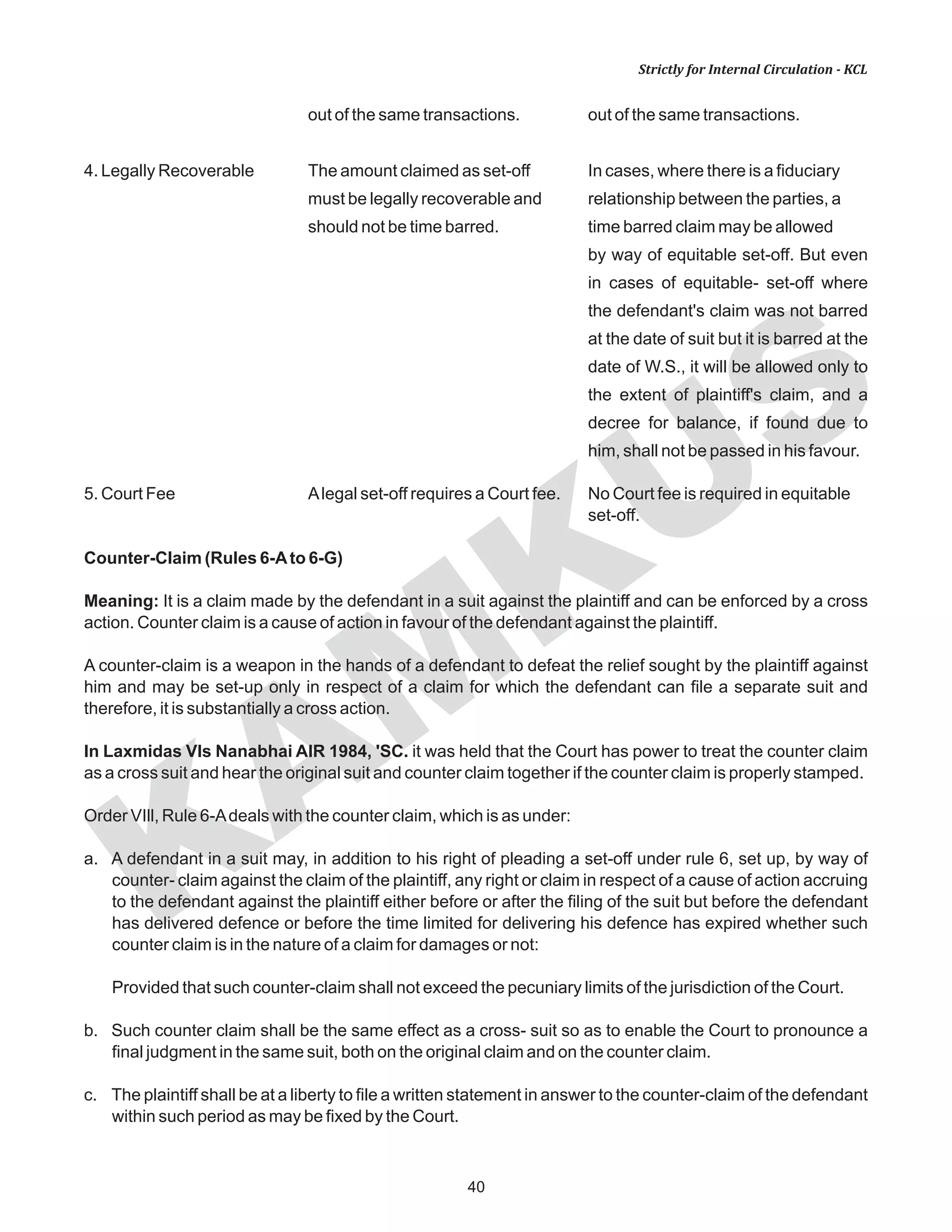
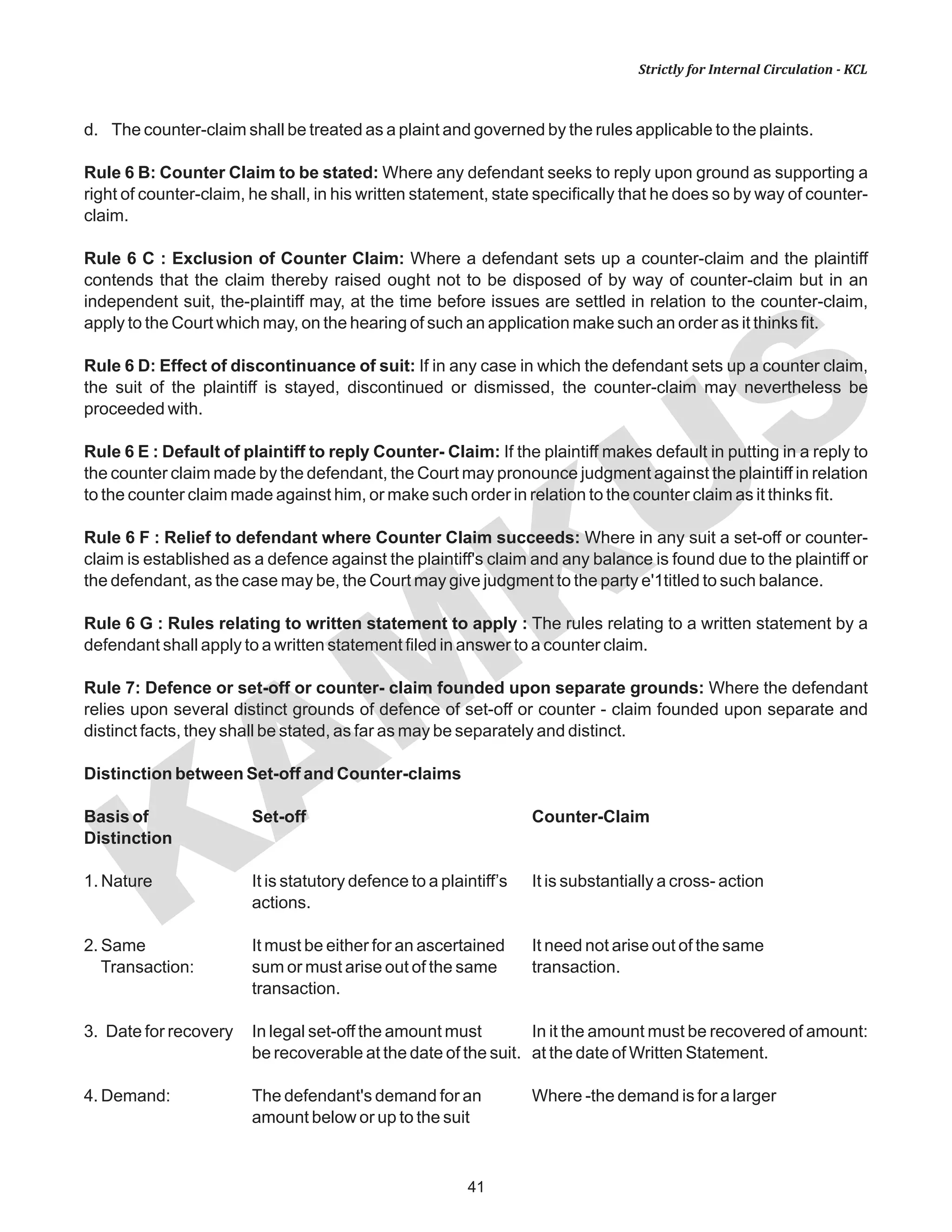
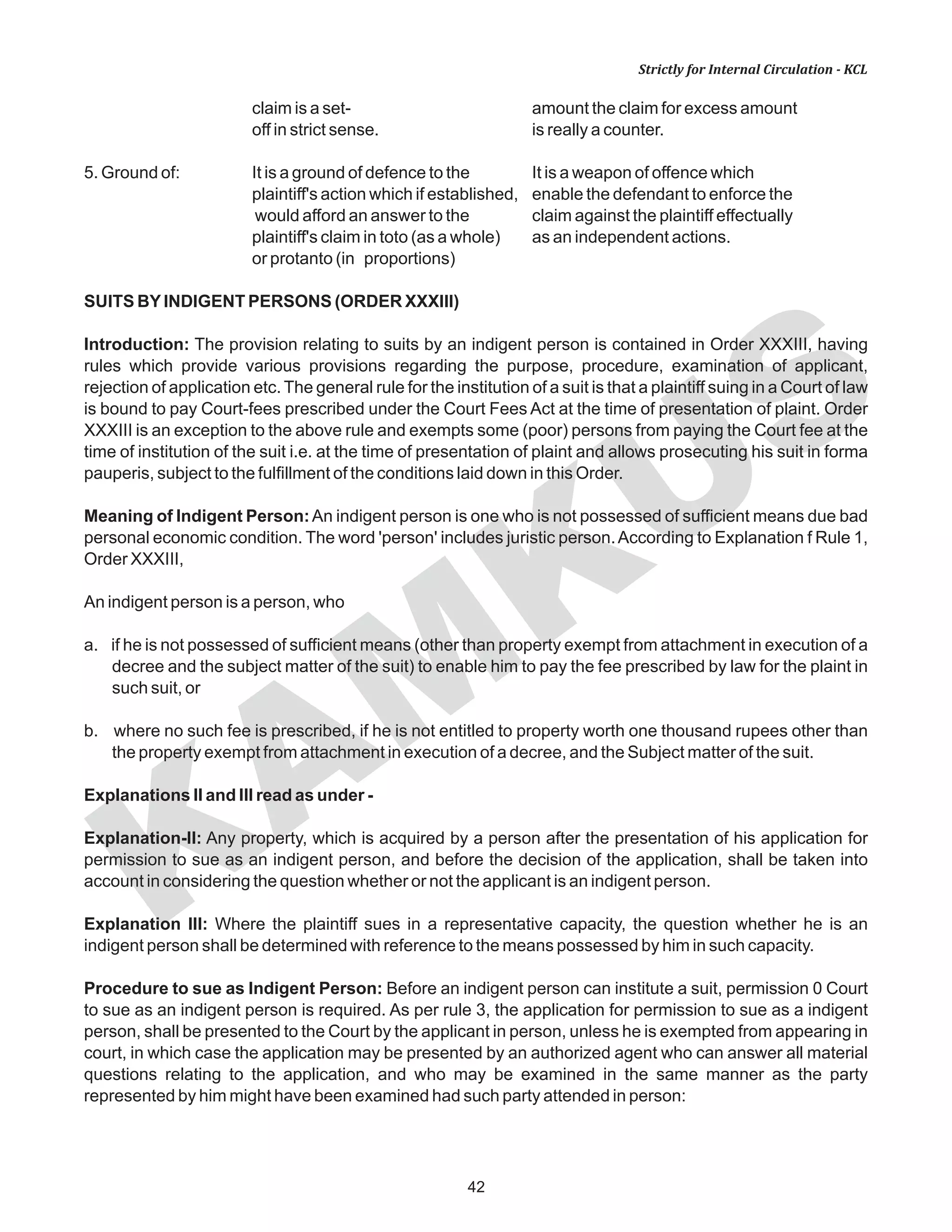

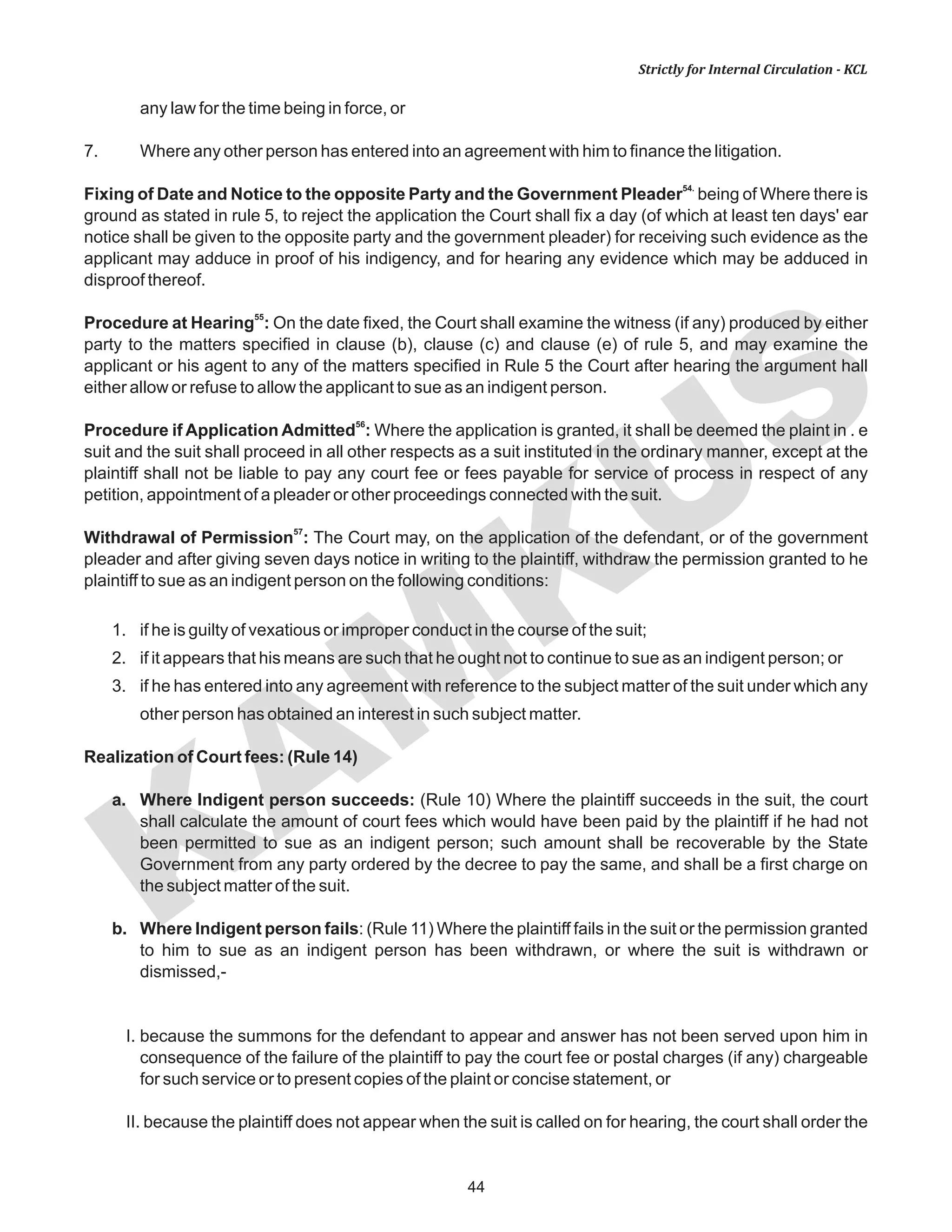
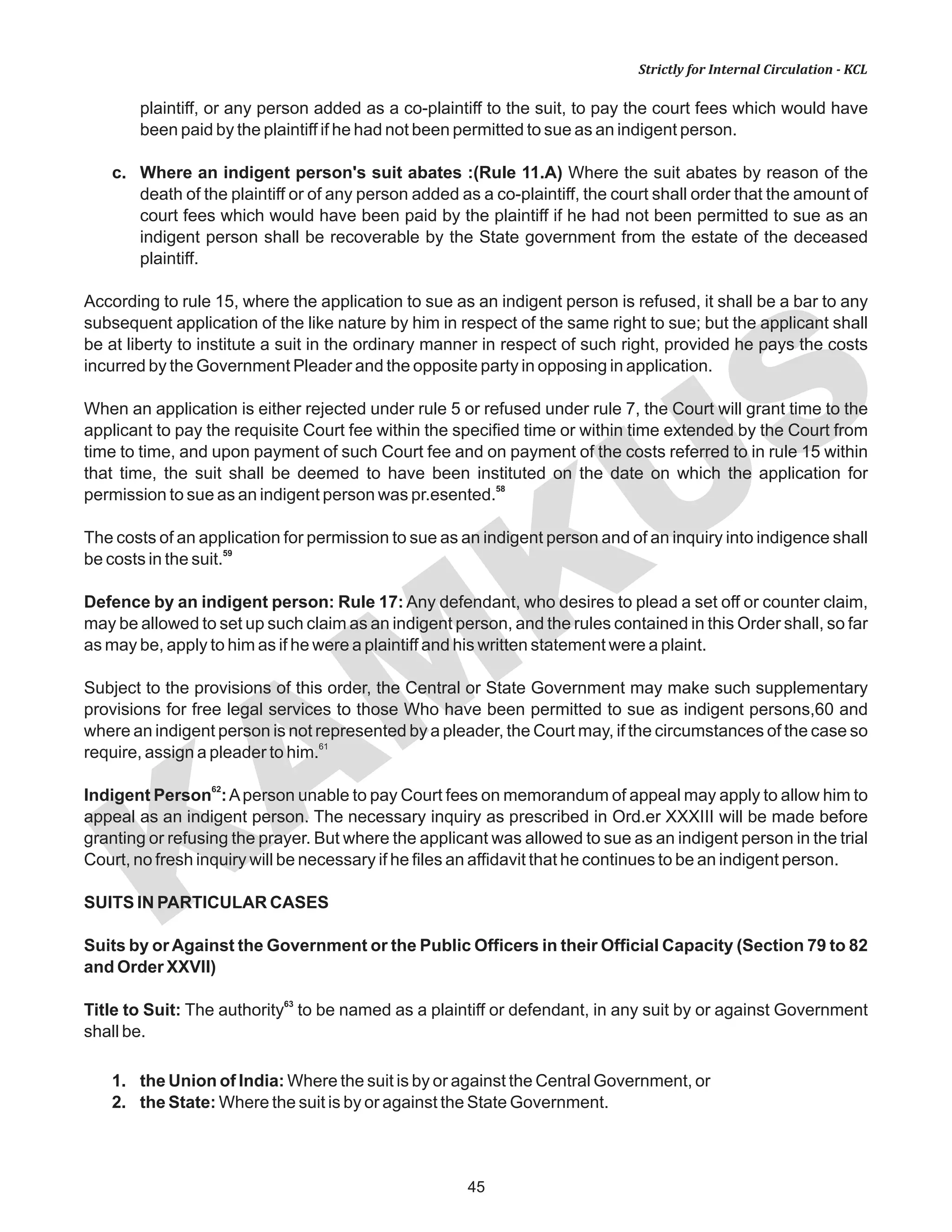
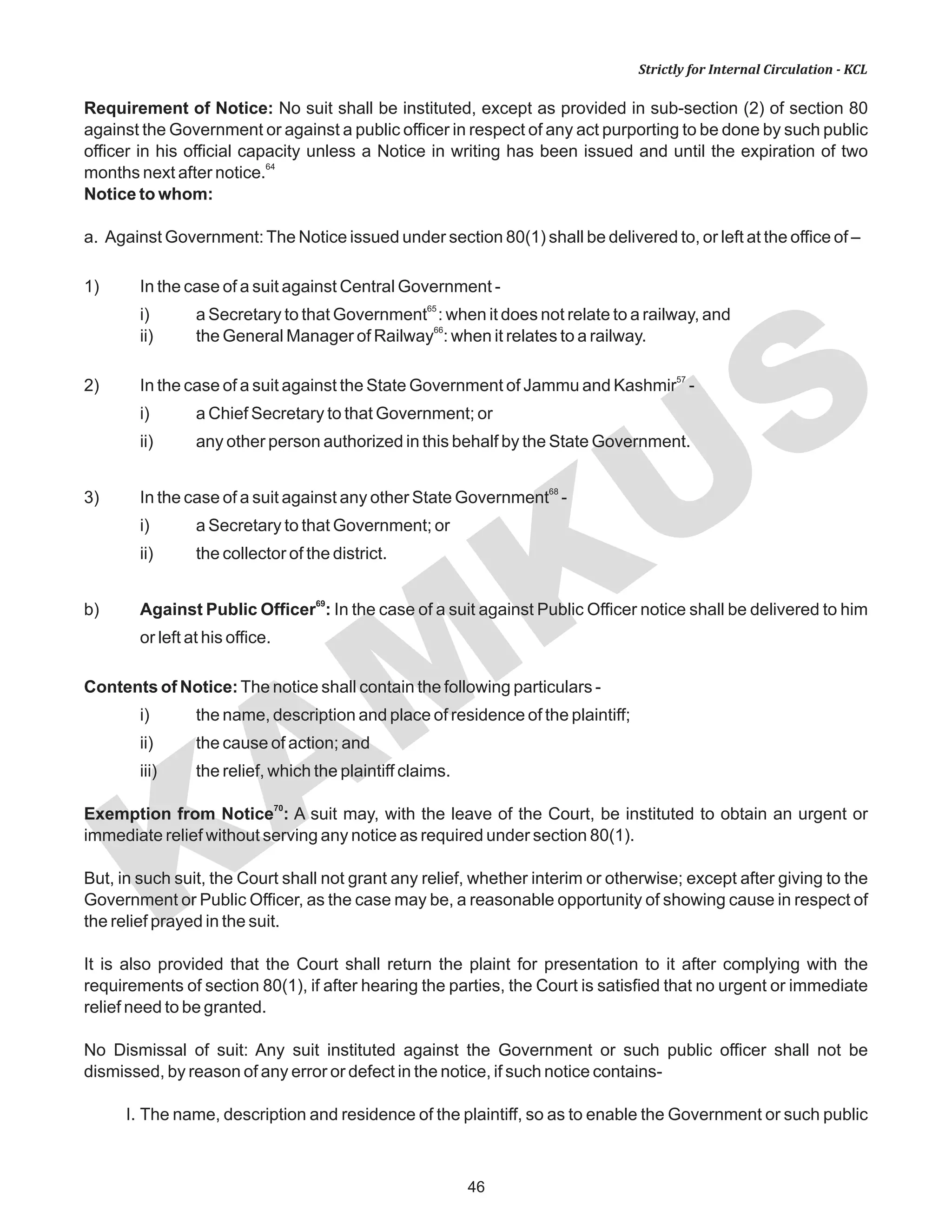
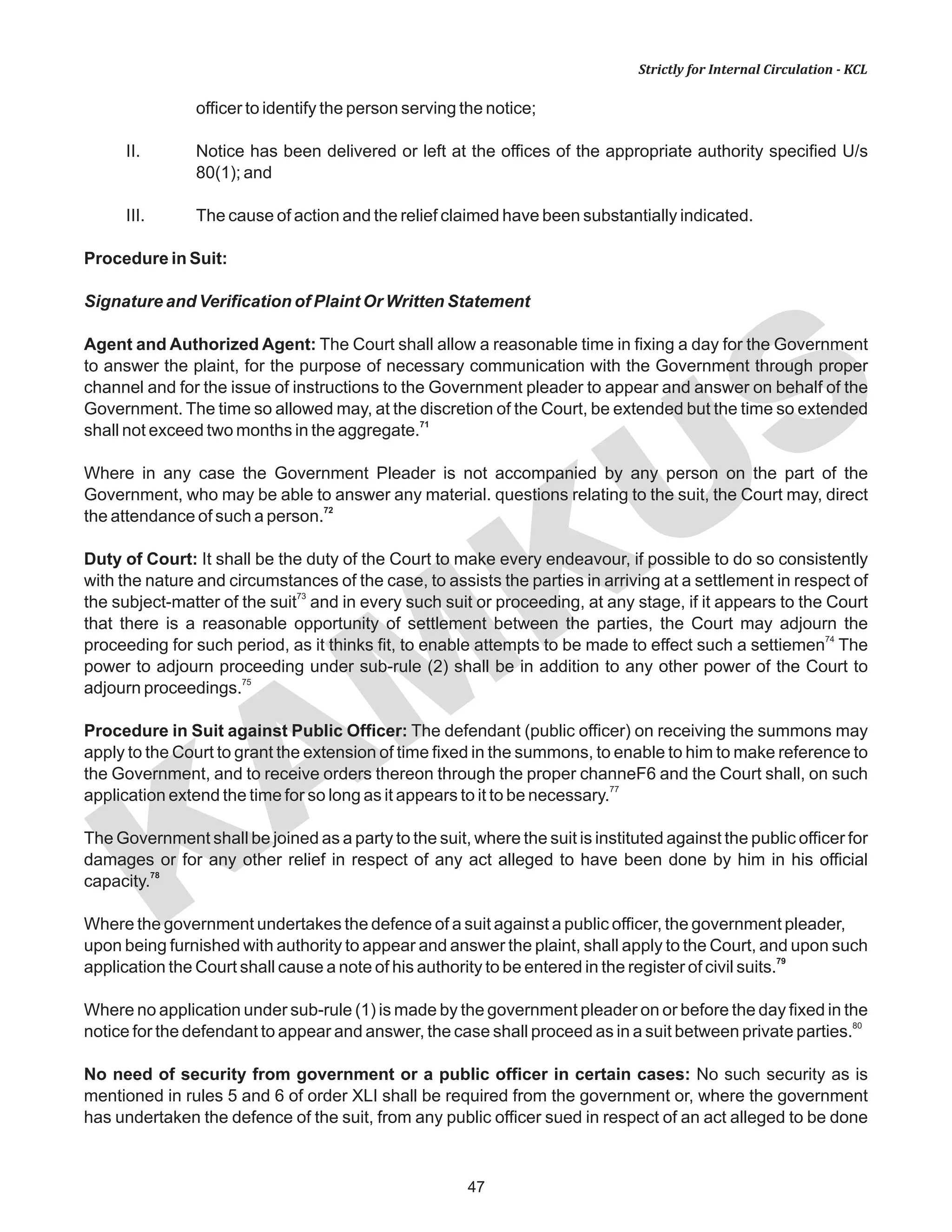
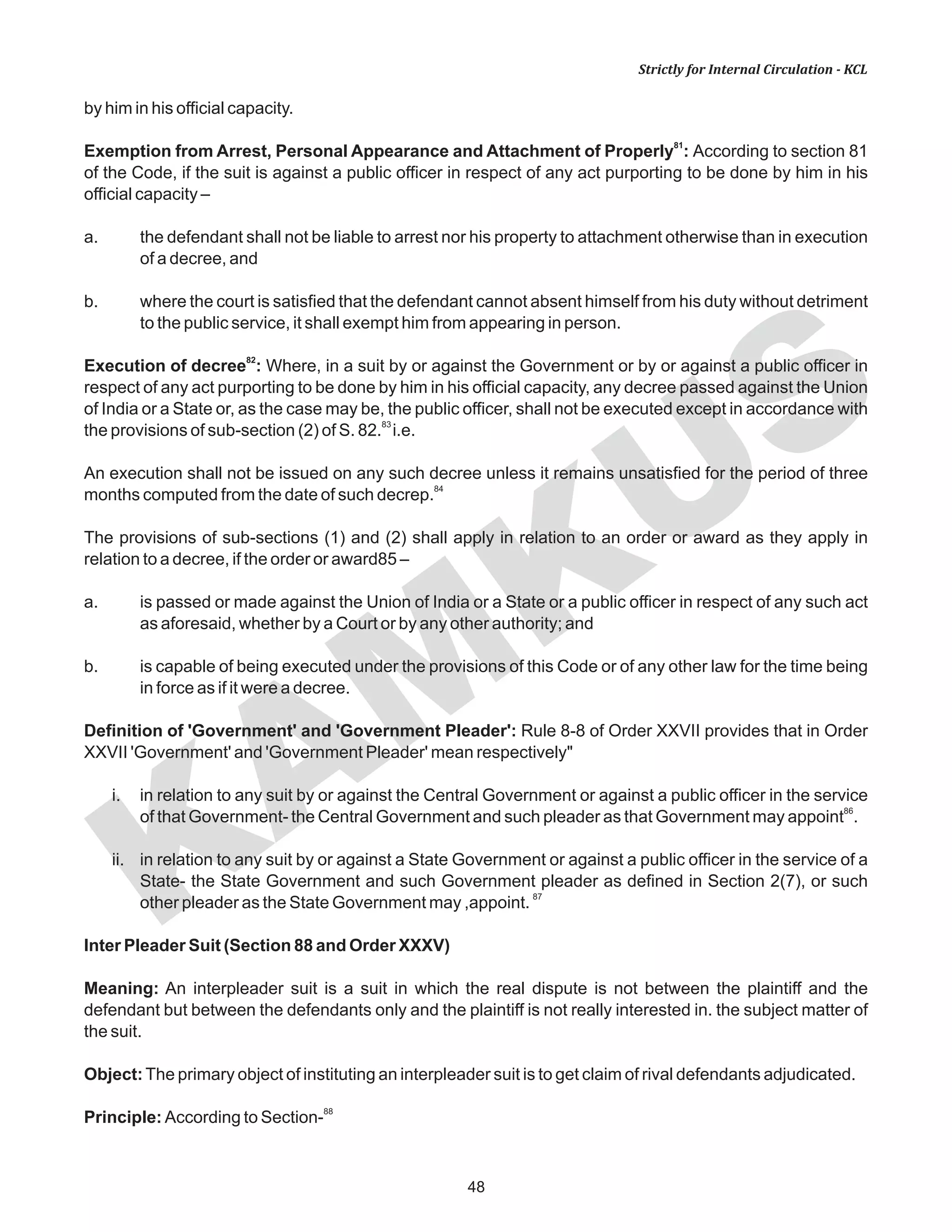
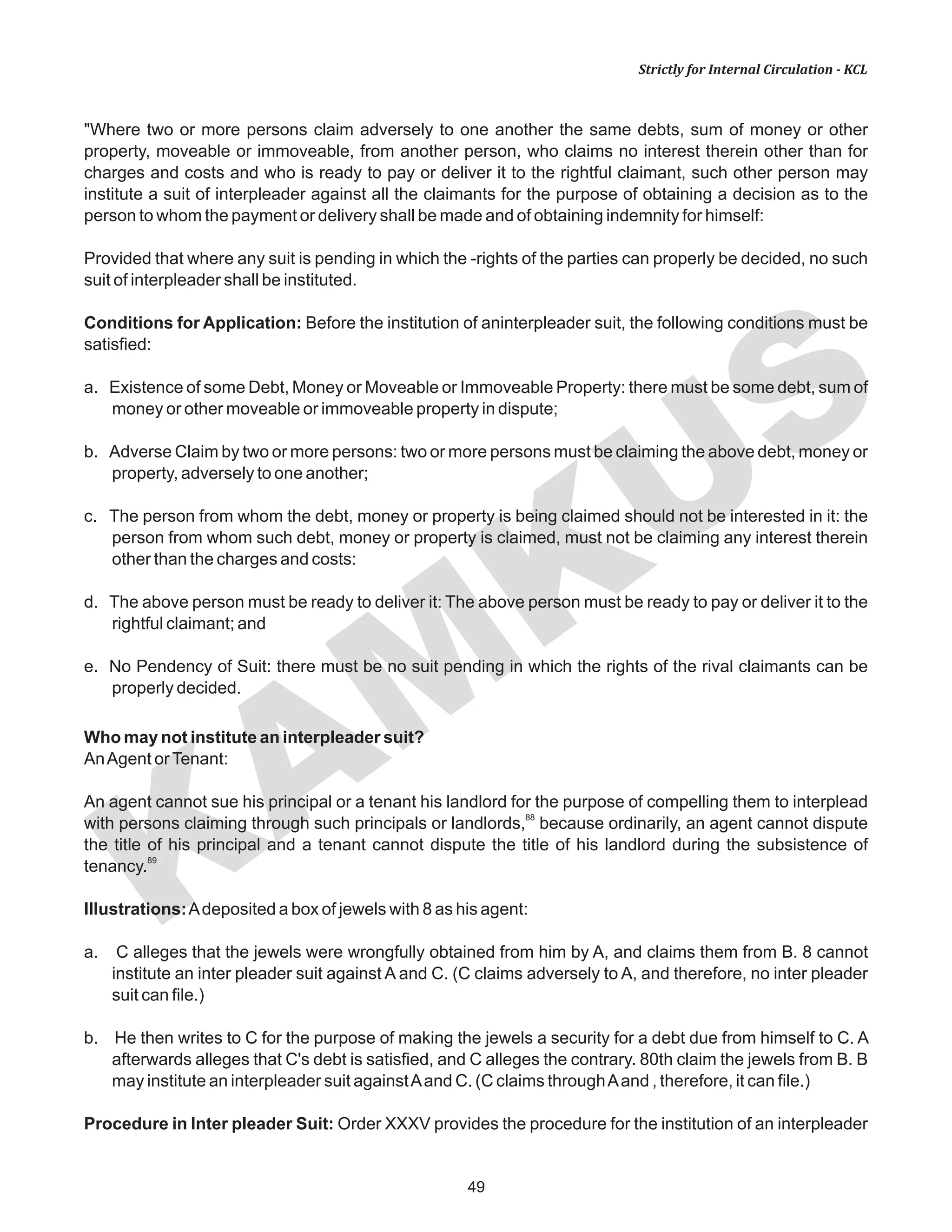
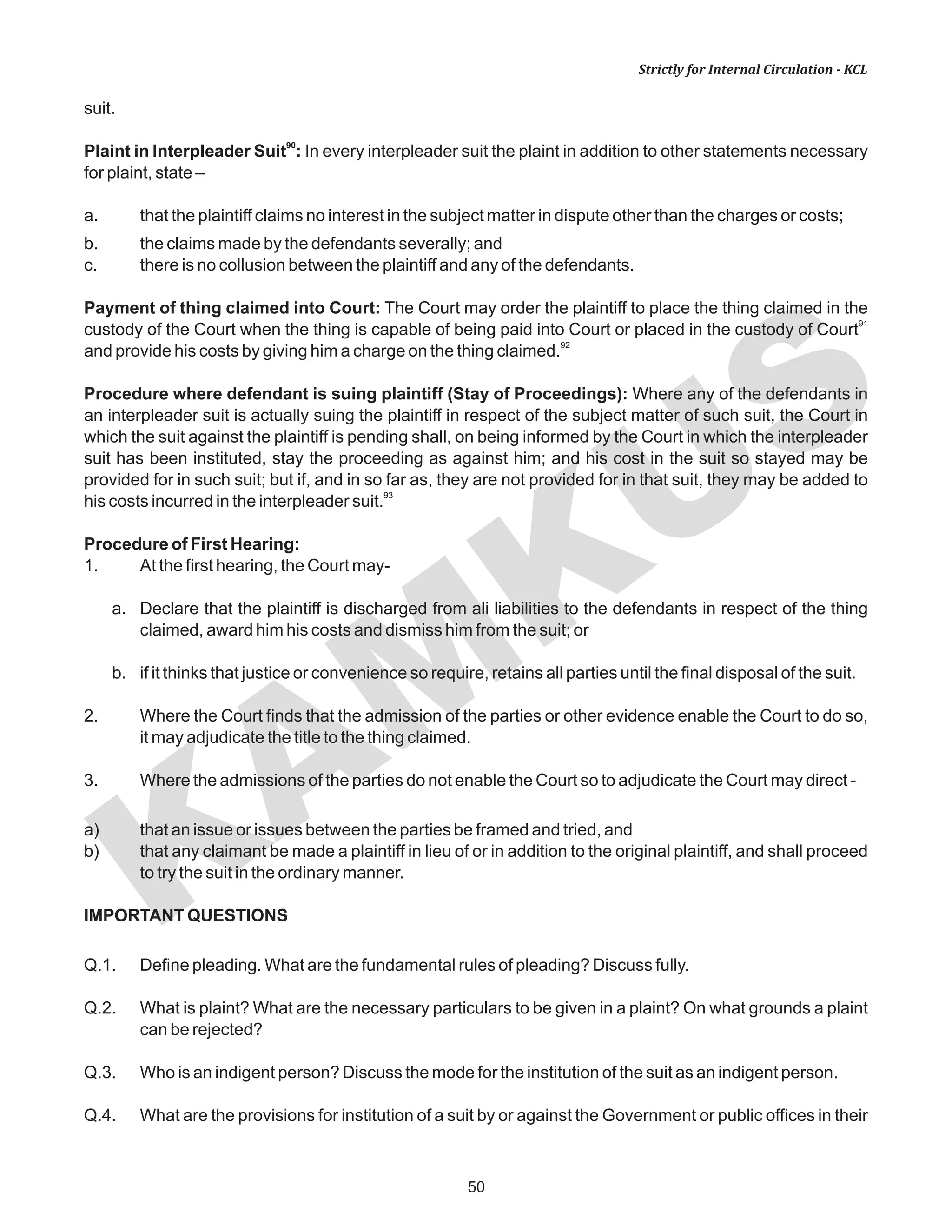

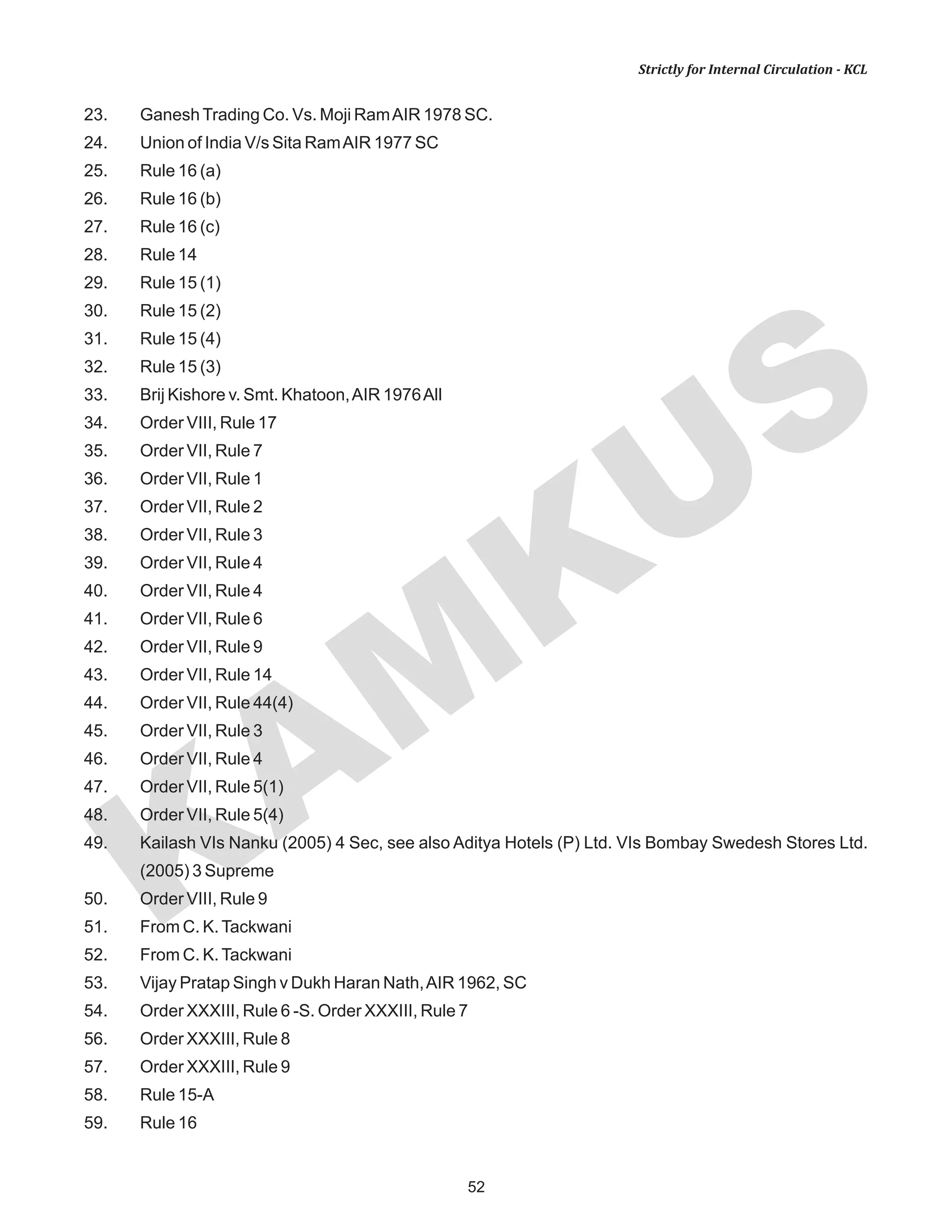
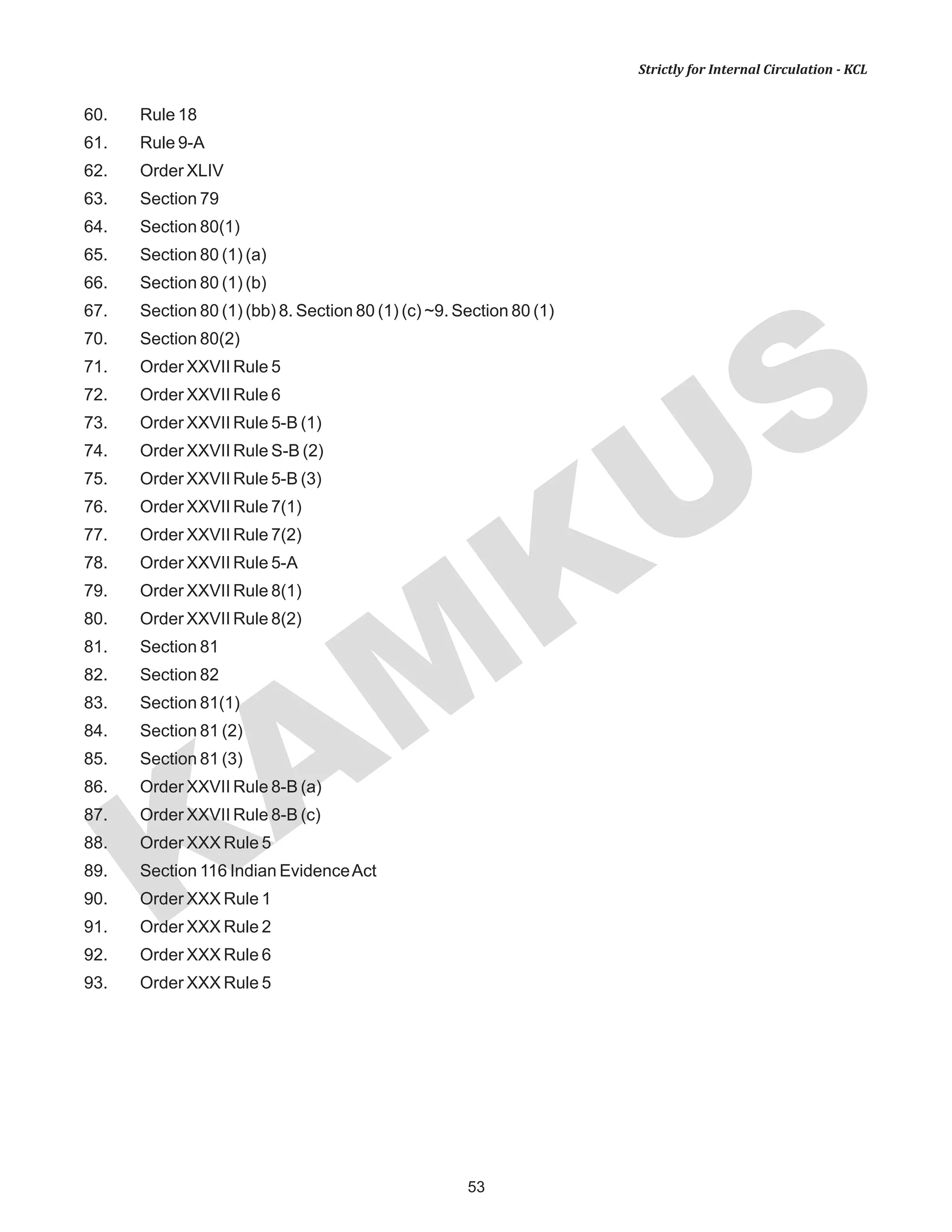
![KAM
KUS
54
Strictly for Internal Circulation - KCL
UNIT - III
SUMMONSAND DISCOVERY, ISSUE OF SUMMONS (SECTION 27 TO 29)
(An intimation sent to the defendant/witness by the Court)
To Defendant (Order 5) and To Witnesses (Order 16)
1
Meaning: The word summons has not been defined in the Code, but according to the dictionary meaning;
"A summons is a document issued from the office of a court of justice, calling upon the person to whom it is
directed to attend before a judge or office of the court for a certain purpose."
Essentials of summons: Every summons shall be signed by the judge or such officer appointed by him
and shall be sealed with the seal of the court [Rule1 (3)] and every summons shall be accompanied by a
plaint or if so permitted, by a concise statement thereof.[Rule 2]
Contents of Valid Summons:
a. The summons must contain a direction whether the date fixed is for settlement of issues only or for final
disposal of the suit (Rule 5).
b. In cases of summons for final disposal of the suit, the defendant shall be directed to produce his
witnesses (Rule 8).
c. The Court must give sufficient time to the defendant to enable him to appear and answer the claim of the
Plaintiff on the day fixed (Rule 6).
d. The summons shall contain an order to the defendant to produce all documents in his possession or
power upon which he intends to rely on in support of his case (Rule 7).
Summons to Defendant:
Section 27: Where a suit has been duly instituted, a summon may be issued to the defendant to appear and
answer the claim and may be served in the manner prescribed on such day not beyond 30 days from the
date of the institution of the plaint.
Order V: Rule 1 (1)
Rule 1(1): When a suit has been duly instituted, a summon may be issued to the defendant to appear and
answer the claim and to file the written statement of his defence, if any, within thirty days from the date of the
service of the summons on that defendant;
Provided that no such summon shall be issued when a defendant has appeared at the presentation of
Plaint and admitted the plaintiff's claim;](https://image.slidesharecdn.com/cpc-smartnotes-190508082159/75/Cpc-smart-notes-56-2048.jpg)
![KAM
KUS
55
Strictly for Internal Circulation - KCL
Provided further that where the defendant fails to file the written statement within the said period of thirty
ways, he shall be allowed to file the same on such other day as may be specified by the Court, for reasons to
be recorded in writing, but which shall not be later that ninety days from the date of service of summons.
Appearance of Defendant [Order V Rule 1 (2)]
Rule 1(2) -Adefendant to whom a summons has been issued under sub-rule (1) may appear
a. in person, or
b. by a pleader duly instructed and able to answer all material questions relating to the suit, or
c. by a pleader accompanied by some person able to answer all such questions. The Court, however,
may order the defendant or plaintiff to appear in person (Rule 3).
Rule 1 (3): Every such summons shall be signed by the judge or such officer as he appoints, and shall be
sealed with the seal of the Court.
Exemption from PersonalAppearance : Order V Rule 4
No party shall be ordered to appear in person
1. unless he resides-
a. within the local limits of the Court's ordinary original jurisdiction, or
b. without such limits but at a place less than fifty or (where there is railway or steamer communication
or other established public conveyance for five- sixths of the distance between the place where he
resides and the place where the Court is situate) less than two hundred miles distance from the
Court-house. Or
2. Who is a woman not appearing in person (Section 132), or
3. Who is entitled to exemption under the Code (Section 132).
2
Mode of service of summons: Service of summons shall be made by delivering or tendering a copy
thereof signed by the Judge or such officer as he appoints in this behalf and sealed with the seal of the court.
The Code prescribes four principal modes of serving a summons to a defendant:
i) Personal or direct service; (Rules 10 to 15 and 18)
ii) Substituted Service; (Rules 20, 17 and 19)
iii) Service by Court; (Rule 9) and
iv) Service by Plaintiff. (Rule 9-A)
1. Personal or direct service: This is an ordinary mode of service of summons. Under the following
categories a service of summons should be made by delivering or tendering a copy thereof3 to the
defendant personally or to his agent or other person on his behalf and for the proper service of
summons following principles must be remembered-
a. Where there are two or more defendants, service of summons should be made on each defendant](https://image.slidesharecdn.com/cpc-smartnotes-190508082159/75/Cpc-smart-notes-57-2048.jpg)
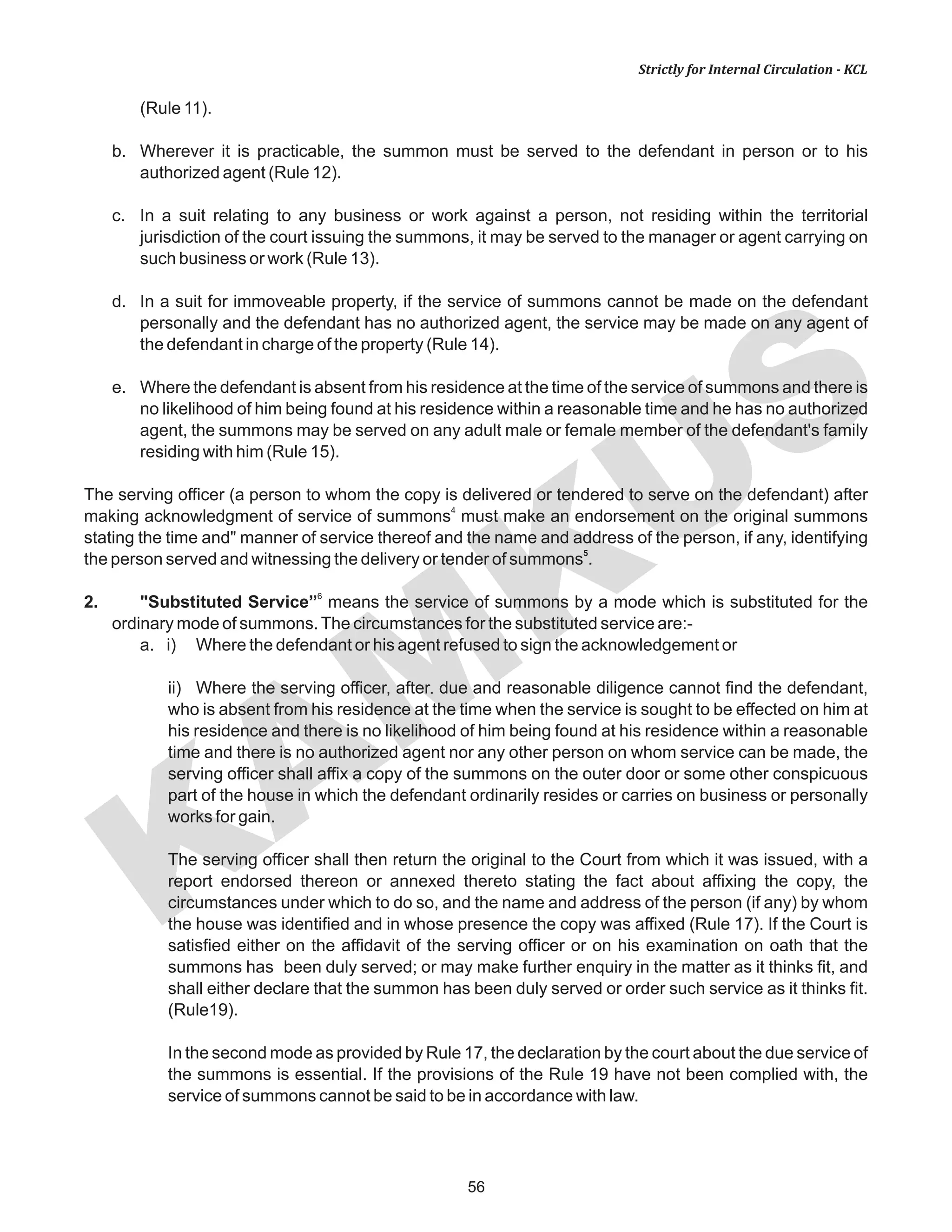
![KAM
KUS
57
Strictly for Internal Circulation - KCL
b. Where the Court is satisfied that there is a reason to believe that the defendant is avoiding the
service of summons or for any other reason the summons cannot be served in the ordinary way,
the Court shall order that the service may be effected in the following manner-
I. by affixing a copy of the summons in some conspicuous place in the court house; and also upon
some conspicuous part of the house in which the defendant is known to have last resided,
carried on business or personally worked for gain; or
ii. In such manner as the court thinks fit [(Rule 20(1)]; or
iii. By an advertisement in the daily newspaper circulating in the locality in which the defendant is
last known to have actually or voluntarily resided, carried on business or personally worked for
gain [(Rule 20(1-A)].
Substituted service Under Rule 20 is as effective as personal service [(Rule 20(2)].
3) By Court: Rule 9 of Order V deals with delivery of summons by Court and states that in cases, where the
defendant or his agent, empowered to accept the service of summons, resides within the jurisdiction of
the Court in which the suit was instituted, the summons shall, unless the Court otherwise directs, be
delivered or sent to the proper officer or to approved courier services to be served on the defendant.
Declaration by Court: The Court issuing the summons shall declare that the summons had been duly
served on the defendant, where
a. the defendant or his agent had refused to take delivery of the postal article containing the summons
or had refused to accept that summons by any other means specified in subrule (3) when tendered
7
or transmitted to him, and
b. Where the summons was properly addressed, pre-paid and duly sent by registered post
acknowledgment due, notwithstanding the fact that the acknowledgement having been lost or
mislaid, or for any other reason, has not been received by the Court within 30 Days from the date of
8
issue of summons.
9
4) By Plaintiff: In addition to the provisions of rule 9, the Court, on the plaintiffs application may permit
and deliver the summons to such plaintiff for service on the defendant and the provisions of rule 16 and
18 shall apply to a summons personally served under rule 9-Aas if, the person effecting service were a
serving officer.
10
Service of summons where defendant resides within jurisdiction of another Court: Asummons may
be sent by the Court by which it is issued, whether within or without the State, either by one of its officers or
by post or by such courier service as may be approved by the High Court, by fax message or by Electronic
Mail service or by any other means as may be provided by the rules made by the High Courts to any Court
11
(not being the High Court) having jurisdiction in the. place where the defendant resides.
Where a defendant resides outside the jurisdiction of the Court in which the suit is instituted, and the Court
directs that the service of summons on that defendant may be made by such mode of service of summons
as is referred to in sub-rule (3) of rule 9 (except by registered post acknowledgement due), he provision of
12
rule 21 shall not apply.](https://image.slidesharecdn.com/cpc-smartnotes-190508082159/75/Cpc-smart-notes-59-2048.jpg)
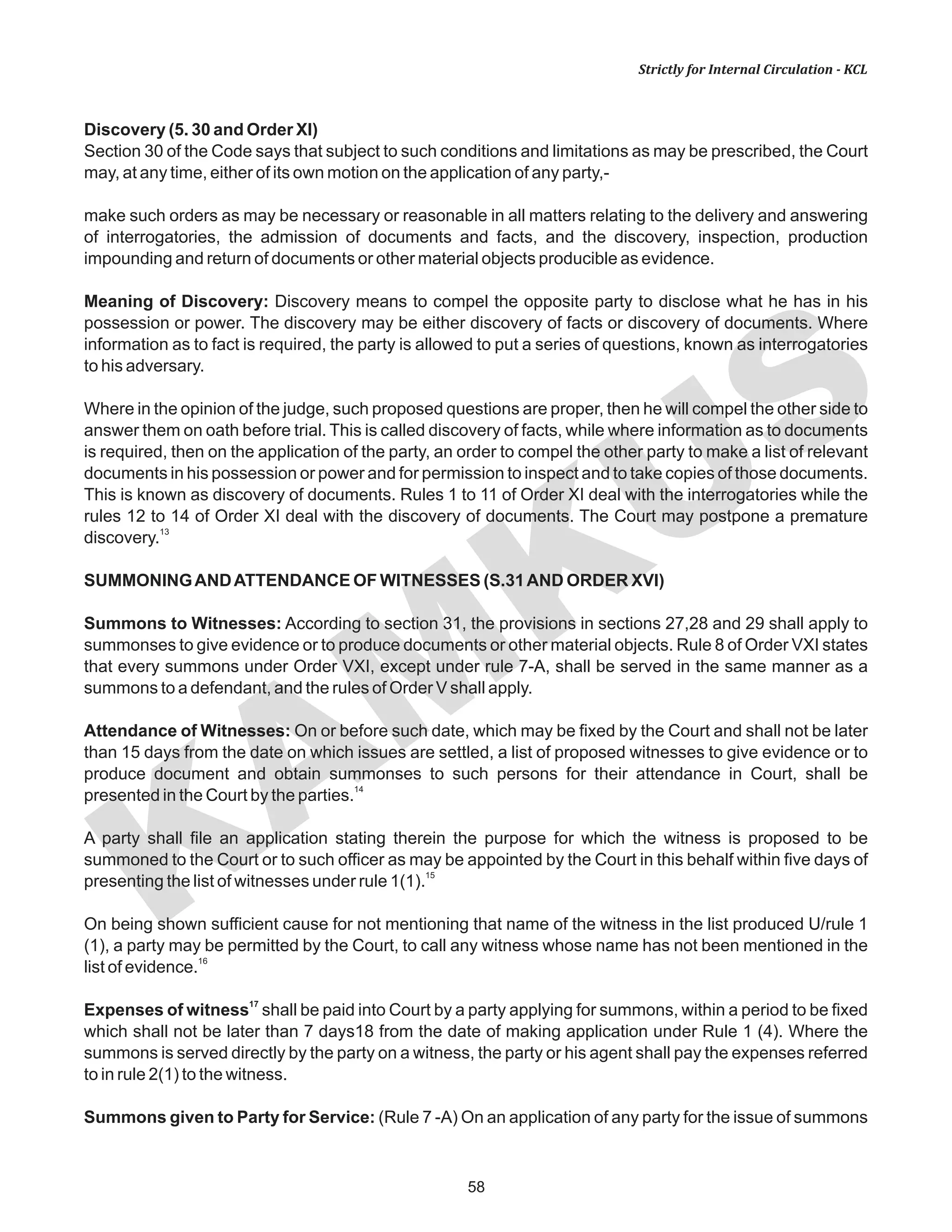
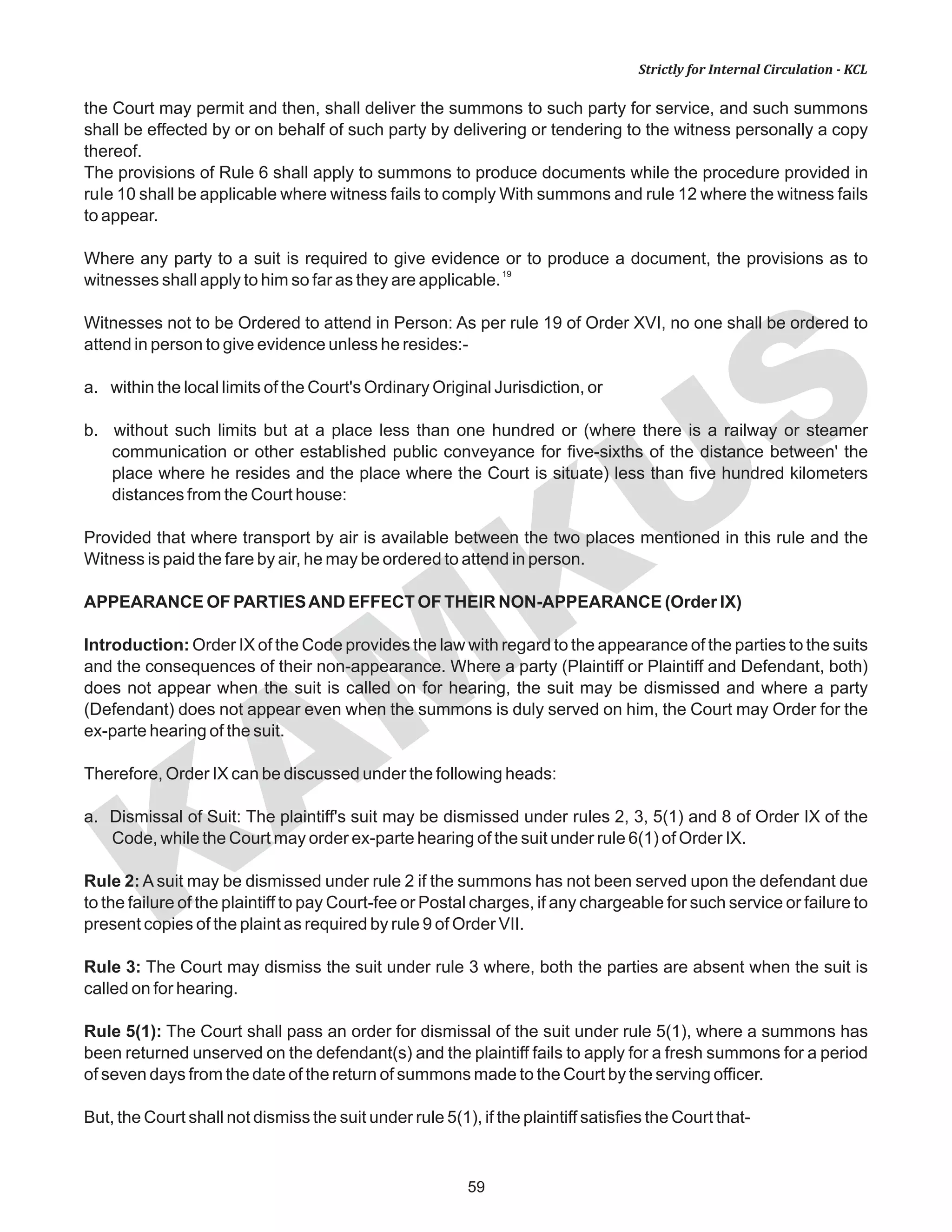
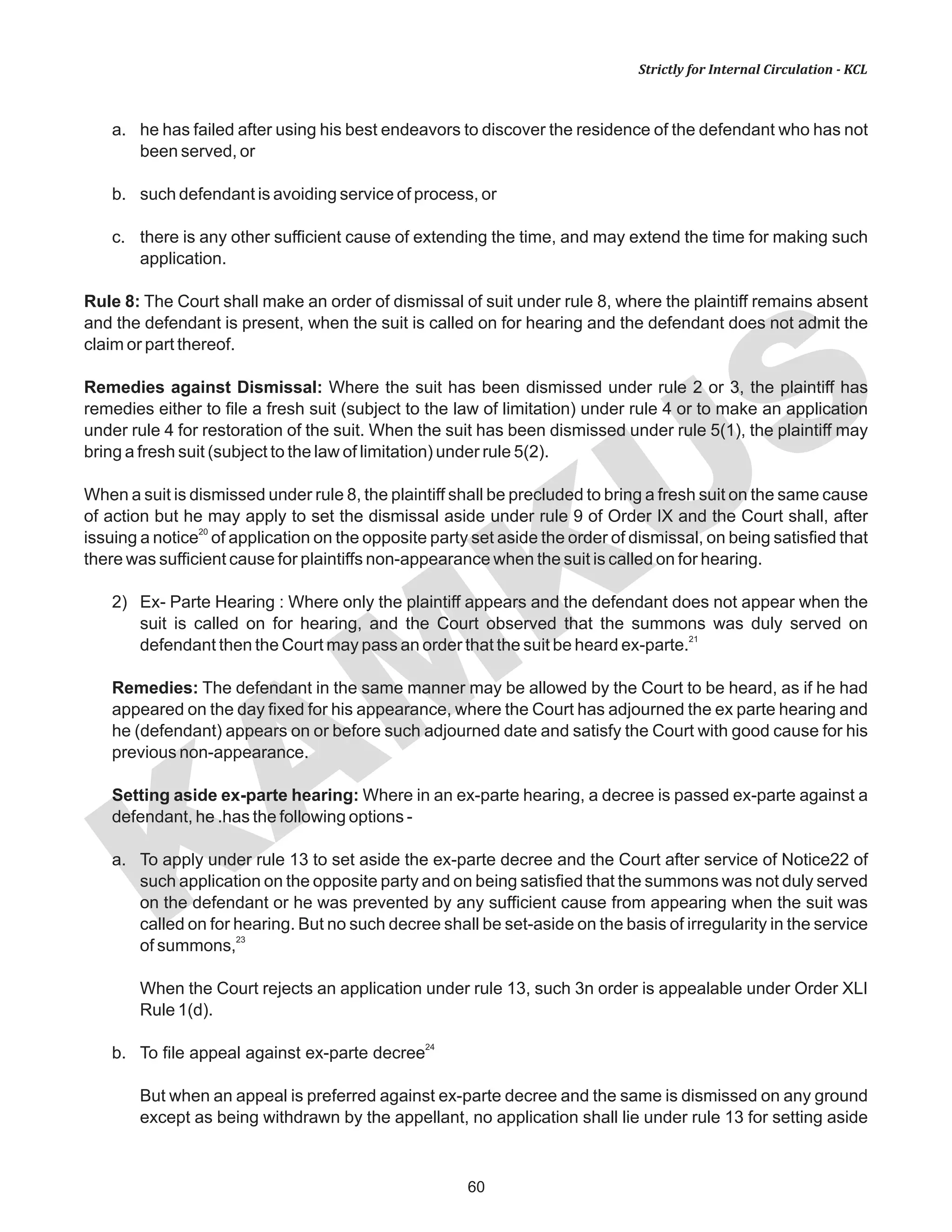
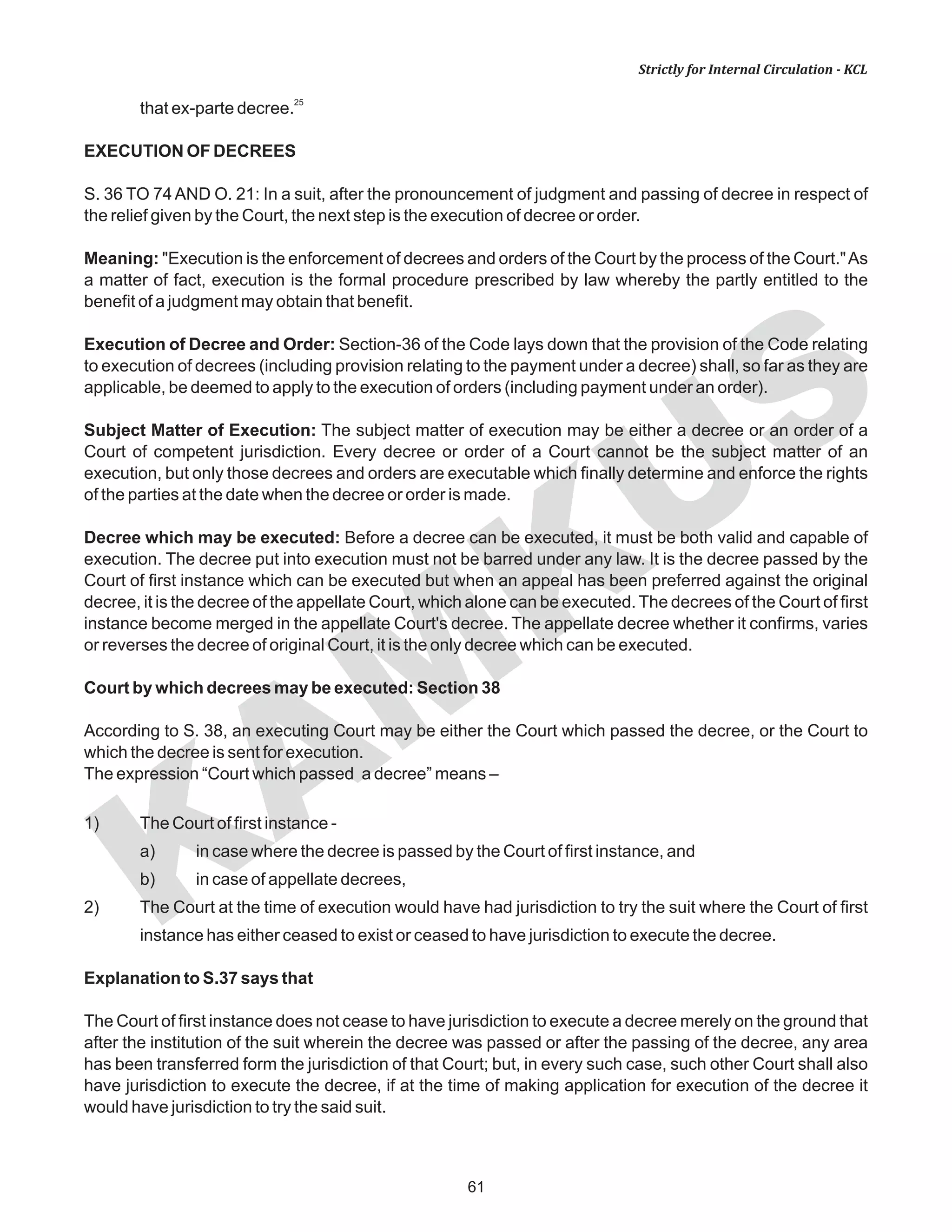
![KAM
KUS
62
Strictly for Internal Circulation - KCL
Application for Execution: The execution proceedings commence with the filing of an application for
execution before the Court, which passed the decree, or before the Court to which the decree has been
transferred for execution. Rules 10-25 and 105-106 of Order 21 deal with execution applications.
Who may apply for execution: Rule 10
An execution proceeding may be started on the application of the -
i) Decree holder- Rule10 of Order 21
ii) Where the decree-holder is dead, his legal representative-S 146.
iii) Any other person claiming under the decree-holder-S. 146.
iv) Representative of or a person claiming under the decree-holder - S. 146.
v) Transferee of decree-holder26, subject to the following-
a. Where the decree has been transferred by an assignment, in writing or by operation of law;
b. The application is to the Court which passed the decree;
c. Notice and after providing an opportunity of being heard to the transferor and the judgment
debtor.
vi) One or more of the joint decree holders,27 subject to the fulfillment of the following
conditions:
a. There is no contrary condition imposed by the decree.
b. The execution application is to the execution of the whole decree; and
c. The application is made for the benefit of all the joint decree holders; or if anyone of them is
dead, for the benefit of the survivors and the legal representatives of the deceased decree
holder.
]Against whom an execution proceeding can be started: Execution proceeding may be started against
the following persons:-
a. Judgment debtor, S. 50, 0.21, R.15
b. When the judgment debtor is dead, against his legal representatives. But the legal
representatives shall be liable only to extent of the property of the judgment debtor received
by them. -So 50, 52, 53.
c. Representative of or the person claiming under the judgment debtor.-S.146.
d. Surety of the judgment debtor. S. 150.
Court to whom an execution application may be made: As per S. 38, an execution application may be
filed either in the Court who passed the decree or in the Court to whom the decree has been transferred for
execution.
Contents of Application:According to Rule 11 of 0.21, every application for execution, except in a case of
a money decree, shall be in writing, signed and verified by the applicant or by some other person
acquainted with the fact of the case and shall contain the particulars like the number of the suit, the name of](https://image.slidesharecdn.com/cpc-smartnotes-190508082159/75/Cpc-smart-notes-64-2048.jpg)


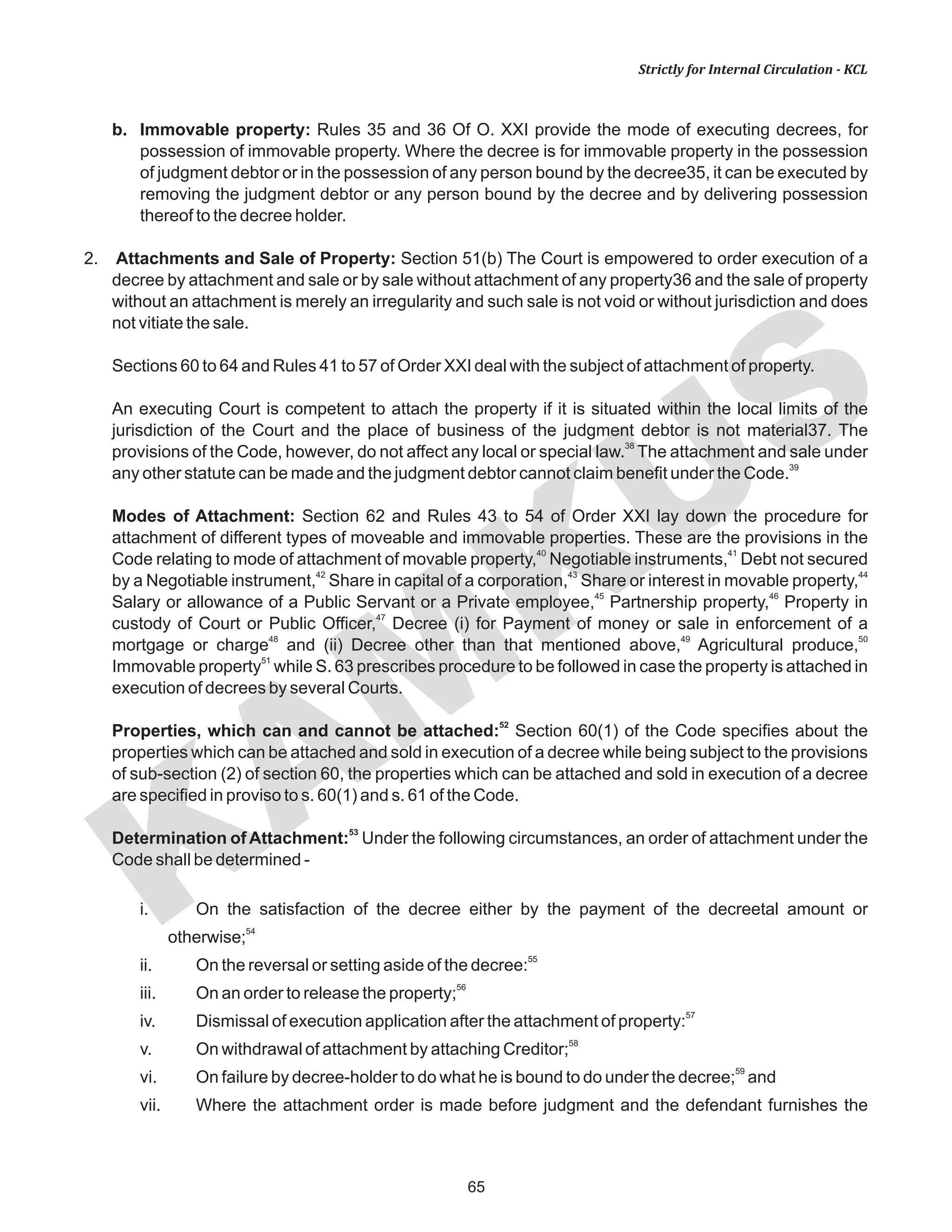
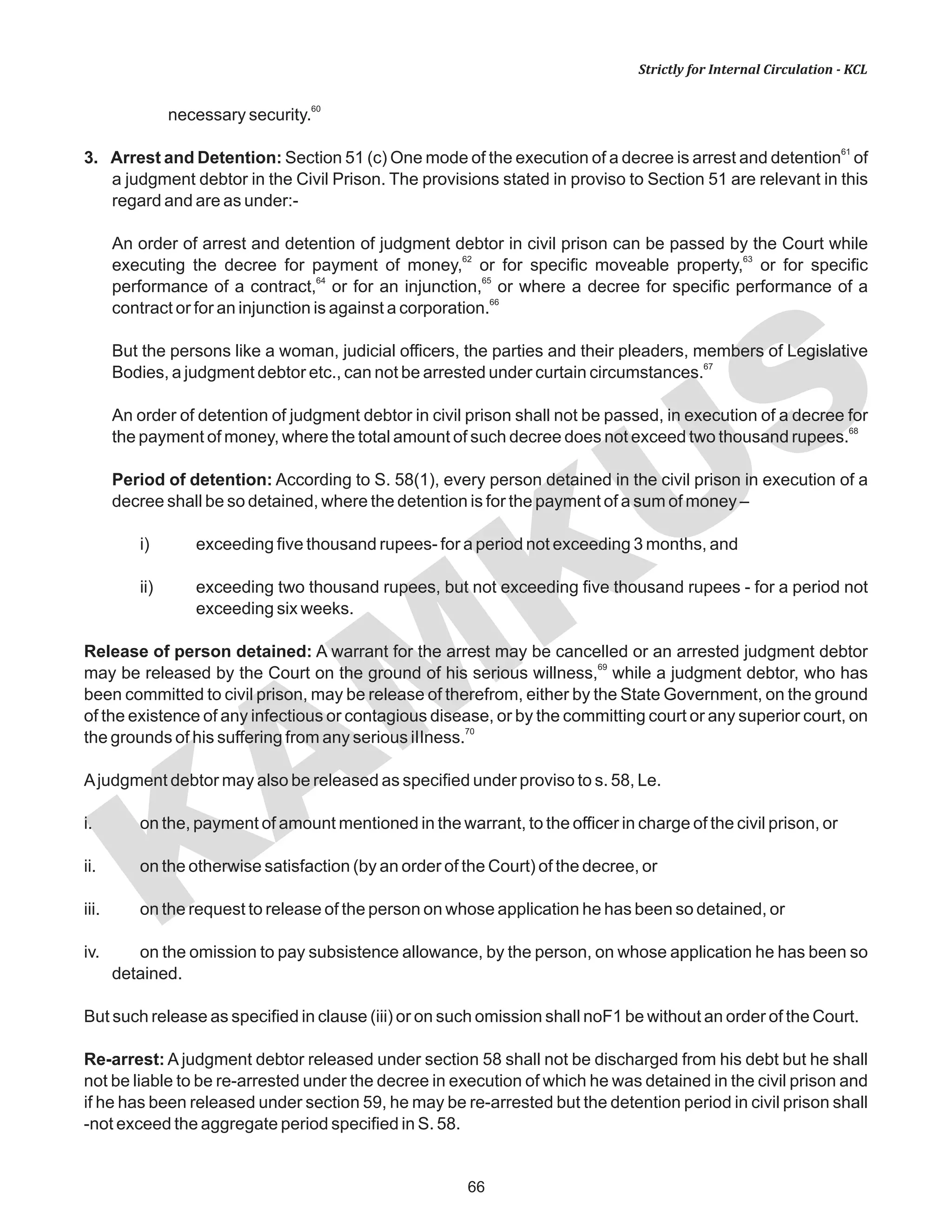
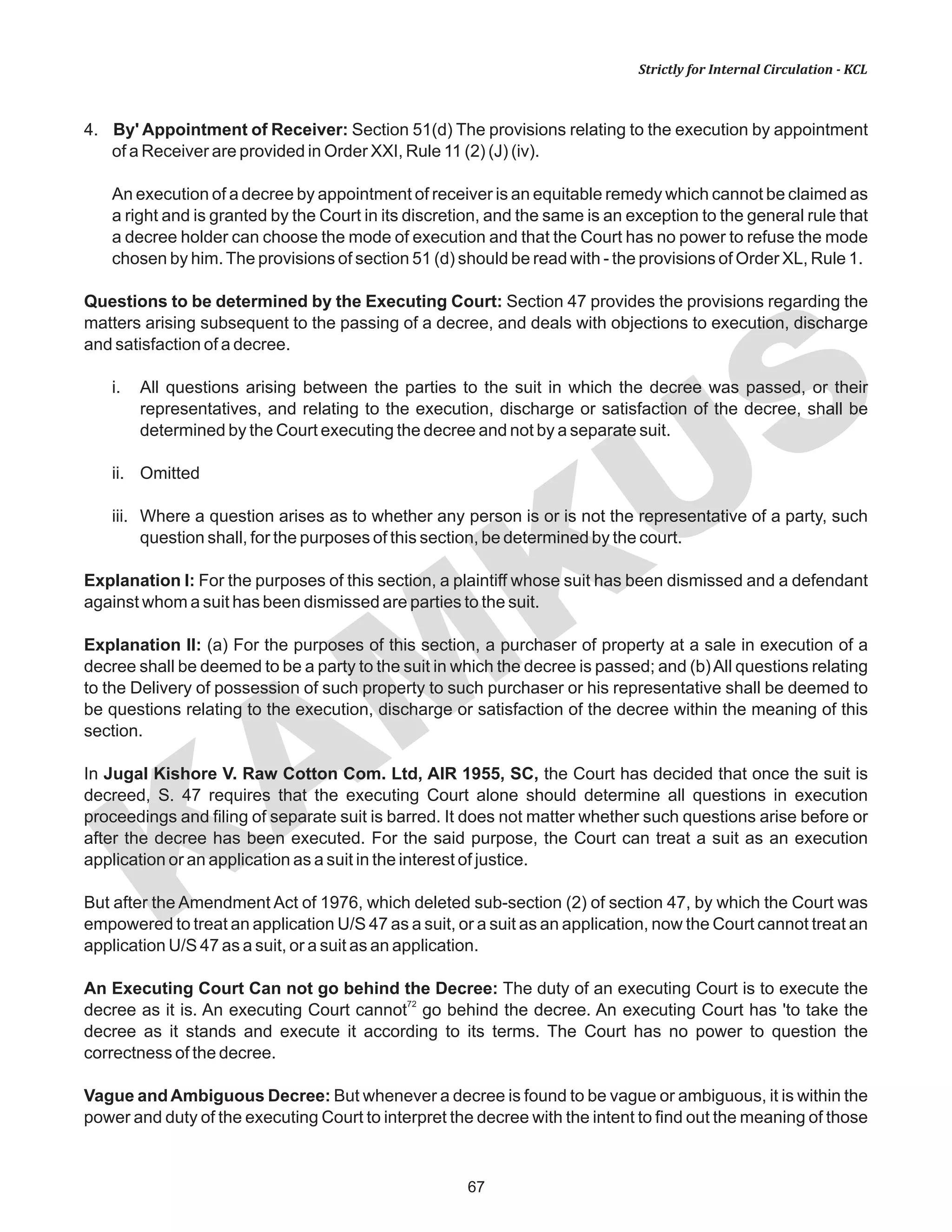
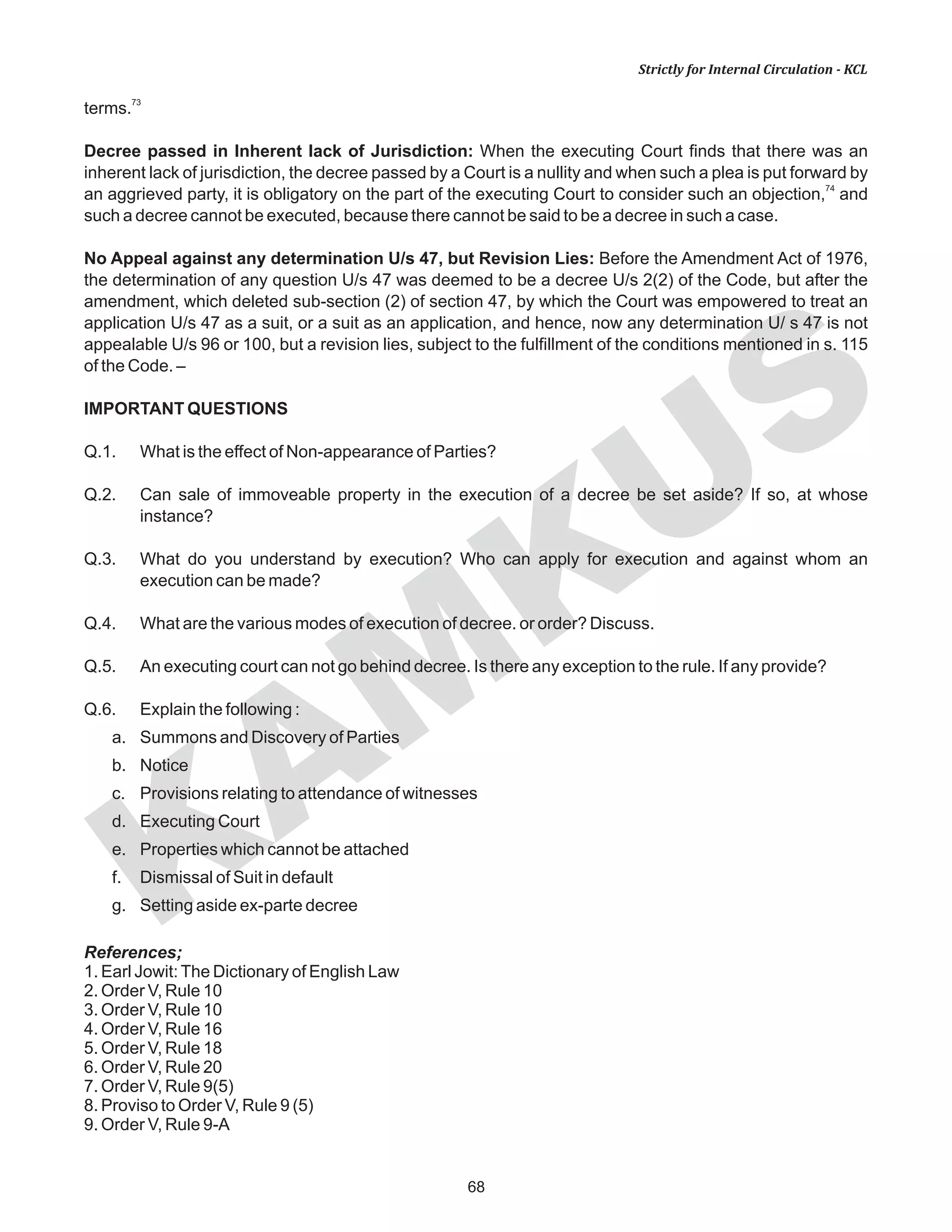


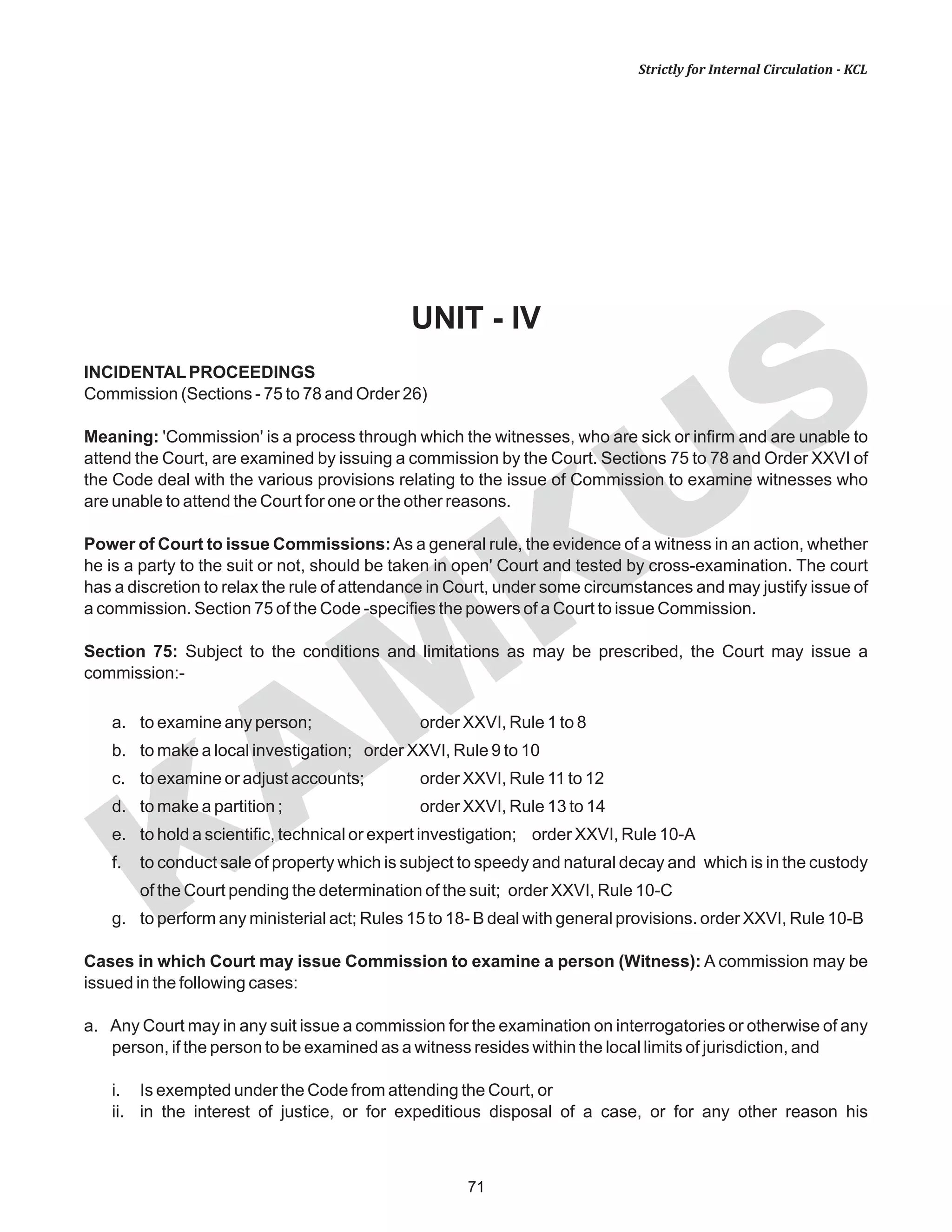
![72
KAM
KUS
Strictly for Internal Circulation - KCL
1
examination on commission will be proper; or
2
b. if he resides beyond the local limits of jurisdiction of the Court, or
3
c. he is about to leave the jurisdiction of the Court, or
d. If he is a Government servant and cannot in the opinion of the Court, attend without detriment to the
4
public service, or
5
e. he is residing out of India and the Court is satisfied that his evidence is necessary.
Persons for whose examinations commission may be issued: Rule 4(1):
Any Court may in any suit issue a commission for the examination on interrogatories or otherwise of any
person,
a. If he resides beyond the local limits of the jurisdiction of the court or [(Order XXVI, Rule4(1)(a)]
b. if he is about to leave the jurisdiction of the Court, or [(Order XXVI, Rule4(1)(b)]
c. if he is a Govt. servant and cannot, in the opinion of the court, attend without detriment to the public
service, or [(Order XXVI, Rule4(1)(c)]
d. if he is residing out of India and the Court is satisfied that his evidence is necessary. Rule 5
To whom Commission may be issued: [Rule 4 (2) and (3)]
Rule 4(2): Such commission may be issued to any Court, not being a high Court, within the local limits of
whose jurisdiction such person resides; or to any pleaded or other person whom the Court issuing the
commission may appoint.
Rule 4(3): The Court on issuing any commission under this rule shall direct whether the commission hall be
returned to itself or to any subordinate Court.
Order for Issue of Commission: (Rule-2)
The Court may issue such a commission –
a. either sue motu (of its own motion) or
b. on the application of any party to the suit, or
c. "ii) of the witness to be examined.
Evidence to be a part of Record: (Rule-7): The evidence taken on commission shall, subject to the
provisions of rule 8, form part of the record.
When deposition may be read in evidence: (Rule-S) : Evidence taken under a commission shall not read
as evidence in the suit without the consent of the party against whom the same is offered, unless.
a. The person, who gave the evidence, is beyond the jurisdiction of the Court or dead or unable for
sickness or infirmity to attend to be personally examined, or exempted from personal appearance in
Court, or is a person in the Service of the Government who cannot, in the opinion of the Court,
attend without detriment to the public service; or](https://image.slidesharecdn.com/cpc-smartnotes-190508082159/75/Cpc-smart-notes-74-2048.jpg)


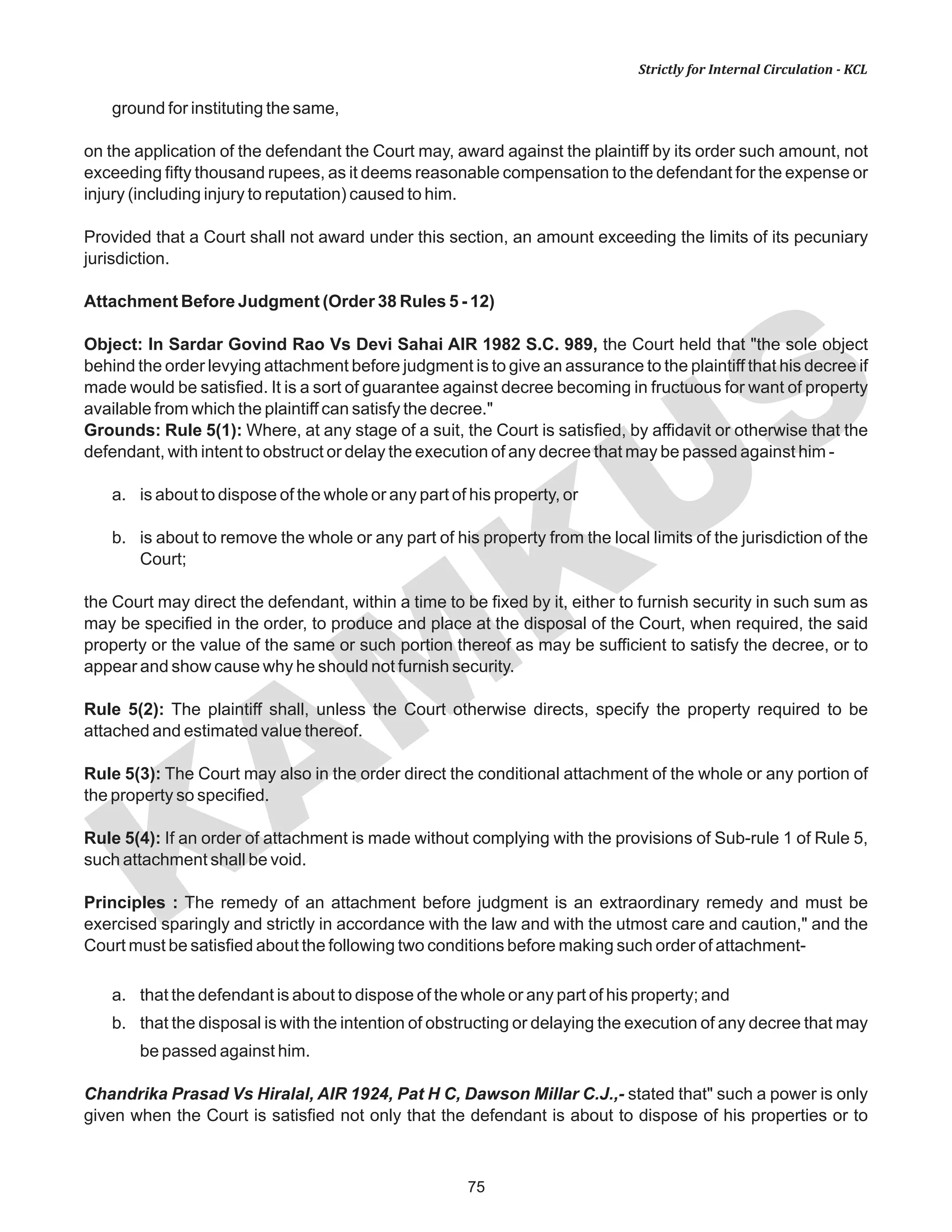
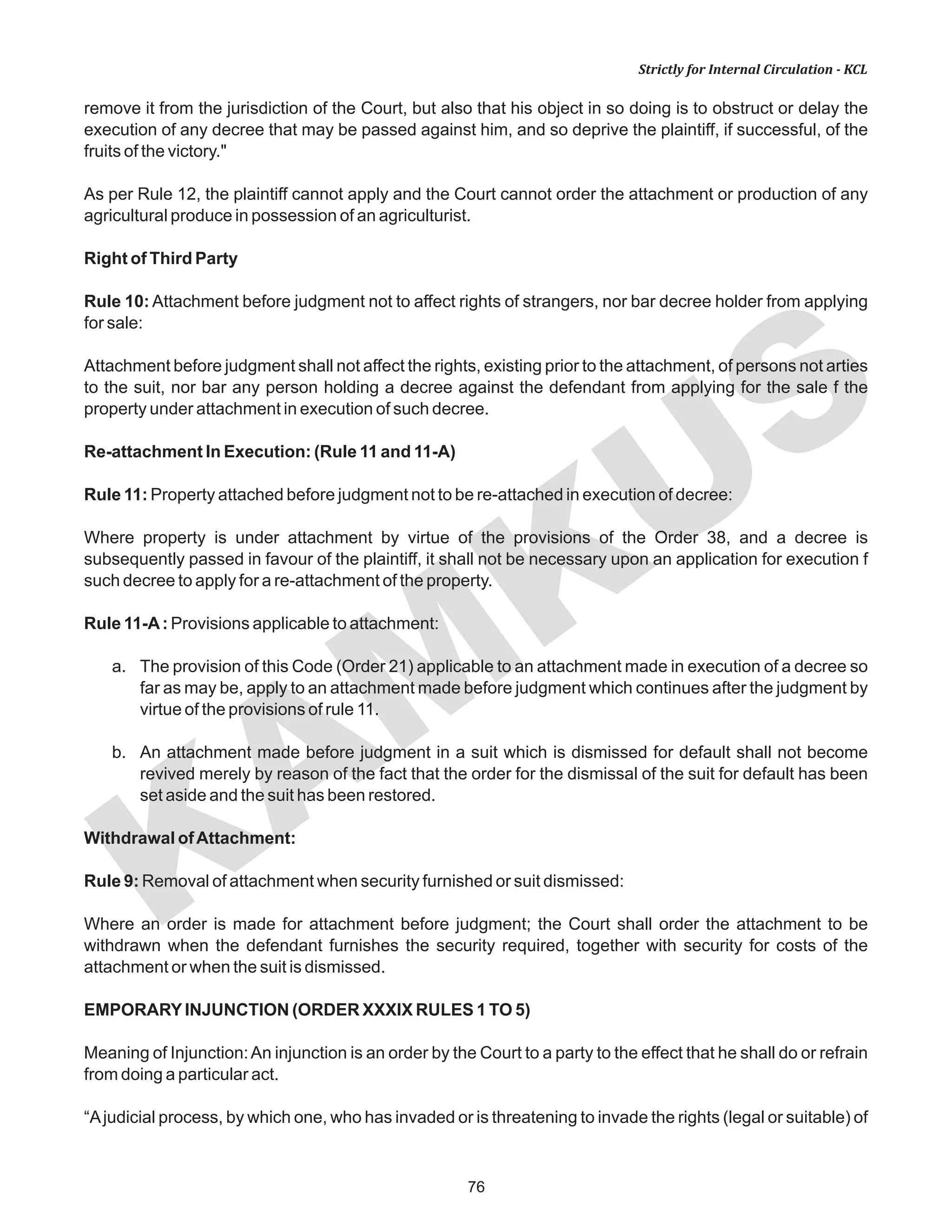
![77
KAM
KUS
Strictly for Internal Circulation - KCL
another, is restrained from continuing or commencing such wrongful act."
According to Lord Halsbury: "An injunction is a judicial process whereby a party is ordered to refrain . am
doing or to do a particular act or thing." In the former case it is called a Restrictive Injunction and the later
case a Mandatory Injunction.
Characteristic of Injunction:
An injunction has three characteristics -
1. It is a judicial process,
2. The object thereby is restraint or prevention, and
3. The thing restrained or prevented is a wrongful act.
Classification of Injunction: The law relating to injunction is laid down in the Specific Relief Act, 1963 (
Section 36 to 42 )
An injunction may be classified according to the relief granted or according to its nature or according to the
operation ofTime
As regards the "time" of their operation the injunction may be divided into two categories-
i) Perpetual or (Permanent), and
ii) Interlocutory Or (Temporary)
i. Perpetual or (Permanent): A perpetual injunction restrains a party for ever from doing the specific
act and can be granted only on merits at the conclusion of the trial after hearing both the parties to the
suits. Section 37(2) of the Specific-ReliefAct, 1963
ii. Interlocutory or (Temporary) :
Definition: A temporary injunction or interim injunction, restrains a party temporarily from doing the
specified act and can be granted only until the disposal of the suit or until the _ further orders of the Courts. It
is regulated by Order 39 rule 1 to 5 of the C.P.C. and may be granted at any stage of the suit.
Section 37(1) of the Specific ReliefAct, 1963
Object: The primary object of granting temporary injunction is to maintain and preserve status quo at the
time of institution of the proceedings and to prevent any change in it until the final determination of the suit.
Grounds: [Order 39 Rule 1, 2 and also Sec. 94 (c)] A temporary injunction may be granted by the Court
under the following cases:
1. Where in any suit it is proved by affidavit or otherwise:
a. that any property in dispute in a suit ,is in danger of being wasted, damaged or alienated by
any party to the suit, or wrongfully sold in execution of a decree; or Rule 1 (a)](https://image.slidesharecdn.com/cpc-smartnotes-190508082159/75/Cpc-smart-notes-79-2048.jpg)
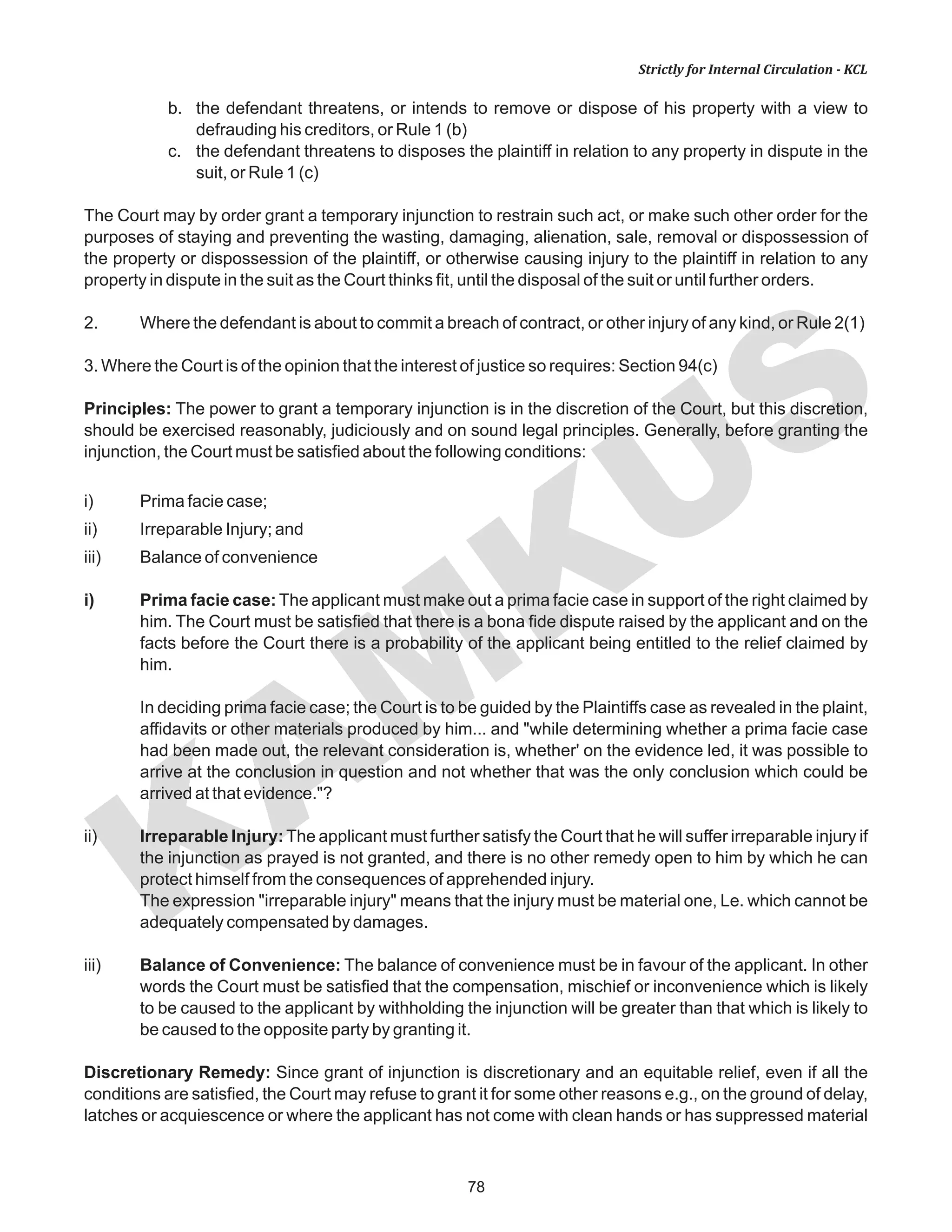
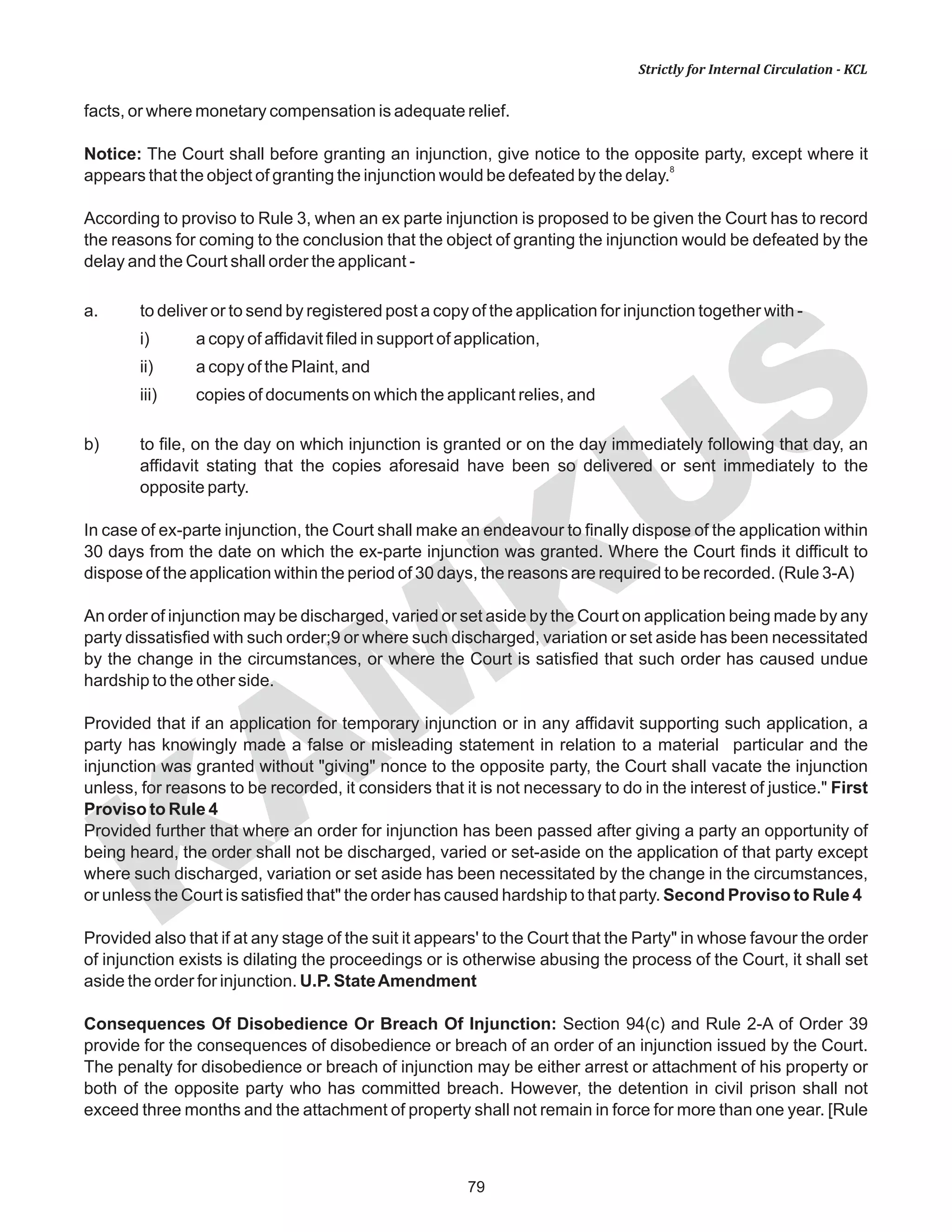
![80
KAM
KUS
Strictly for Internal Circulation - KCL
2-A(1)]
If the disobedience or breach still continues, the property attached may be sold and out of the proceeds, the
Court may award such compensation as it thinks fit to the injured party. [Rule 2-A(2)]
The transferee Court can also exercise his power and can punish for breach of injunction granted by the
transferor Court. [Rule 2-A(1)]
Injunction on insufficient grounds: When in any suit in which an order of temporary injunction has been
obtained by the plaintiff on insufficient grounds, or where the suit of the plaintiff fails and it appears to the
Court that there was no reasonable or probable ground for instituting it, on application being made by the
defendant, the Court may order the plaintiff to pay such amount not exceeding one thousand rupees, as it
10
deems a reasonable compensation to the defendant for the expense or injury to reputation caused to him.
An order declining to grant injunction and issuing notice to defendants V/s Rule 3 of Order 39 is not
appealable under Order 43 Rule 1 (2) of the Code but when the ex-parte interim injunction is refused
illegally, the Court can in exercise of its power of Superintendence under Section 115 of the Code, grant ad-
interim injunction.
Interlocutory Orders (Order XXXIX Rules 6 to 10)
Meaning: Interim orders or interlocutory orders are those orders passed by a Court during the pendency of
a suit or proceeding which do not determine finally the substantive rights and liabilities of the parties in
respect of the subject-matter of the suit or proceeding.
After the suit is instituted by the plaintiff and before it is finally disposed of, the Court may make interlocutory
orders as may appear to the Court to be just and convenient. [Section 94 (e)]
Interim orders or interlocutory orders are made in order to assist the parties to the suit in the prosecution of
their case or for the purpose of protection of the subject matter of the suit.
Interlocutory Orders Under Order XXXIX:
1. Power of Court to Order Interim Sale: On the application of any party (an application by the
11
plaintiff under Rules 6 or 7 may be made at any time after the institution of the suit while by the
12
defendant, it may be made at any time after appearance) to the suit, the Court may, order the sale
of any moveable property, being the subject-matter of such suit, or attach before judgment in such
suit, which is subject to speedy and natural delay, or which for any just and sufficient cause it may be
13
desirable to have been sold at once.
2. Detention, Preservation, Inspection, etc, of Subject-matter of Suit : The Court may make an
order for detention, preservation and inspection of any property which is the subject-matter of the
14
suit, or as to which any question may arise therein; and authorize any person to enter upon or into
15
any land or building in the possession of any other party to such suit; and authorize any sample to
be taken, or any observation to be made or experiment to be tried, which may seem necessary or
16
expedient for the purpose of obtaining full information or evidence.
Notice to Opposite Party: No order under rule 6 or 7 shall be made without giving notice to the](https://image.slidesharecdn.com/cpc-smartnotes-190508082159/75/Cpc-smart-notes-82-2048.jpg)
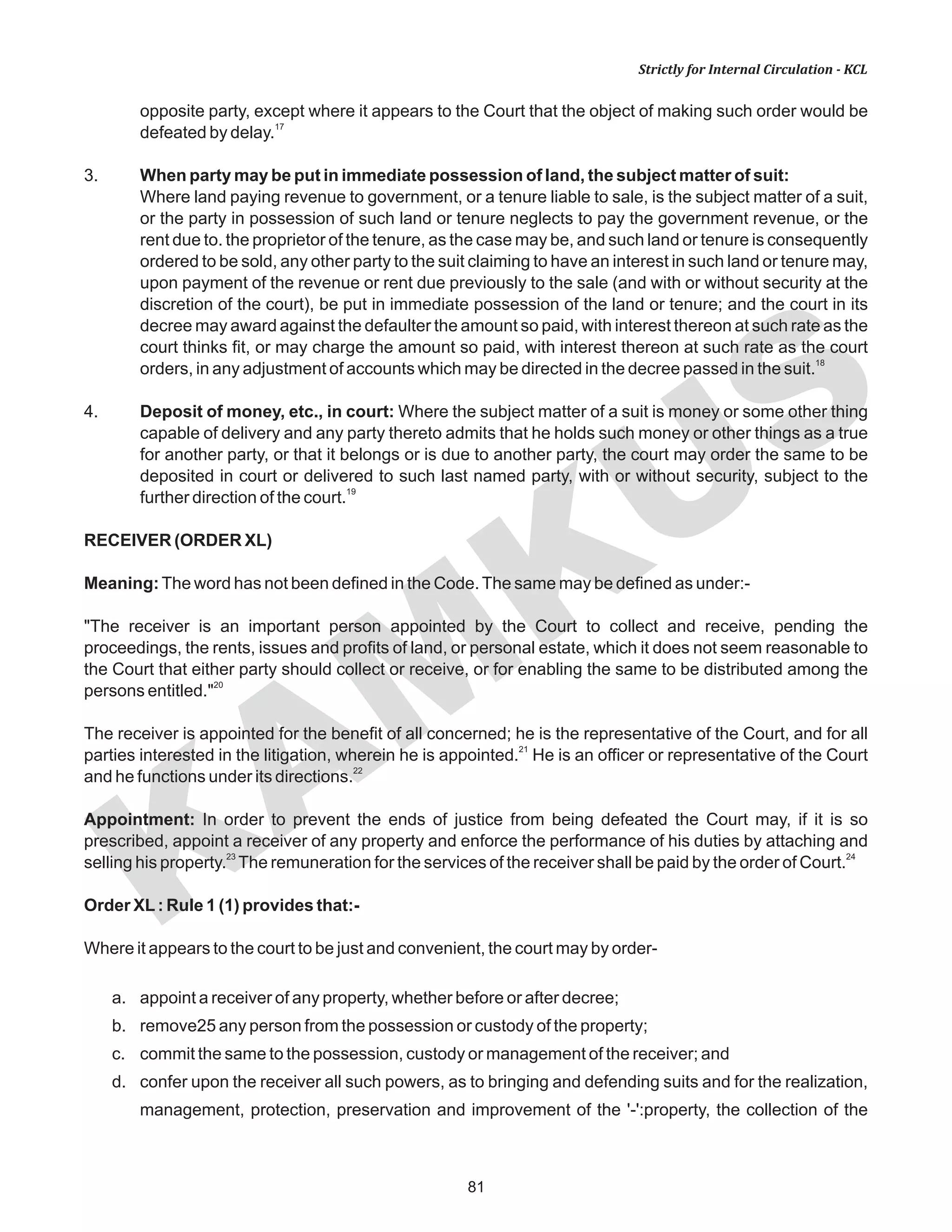

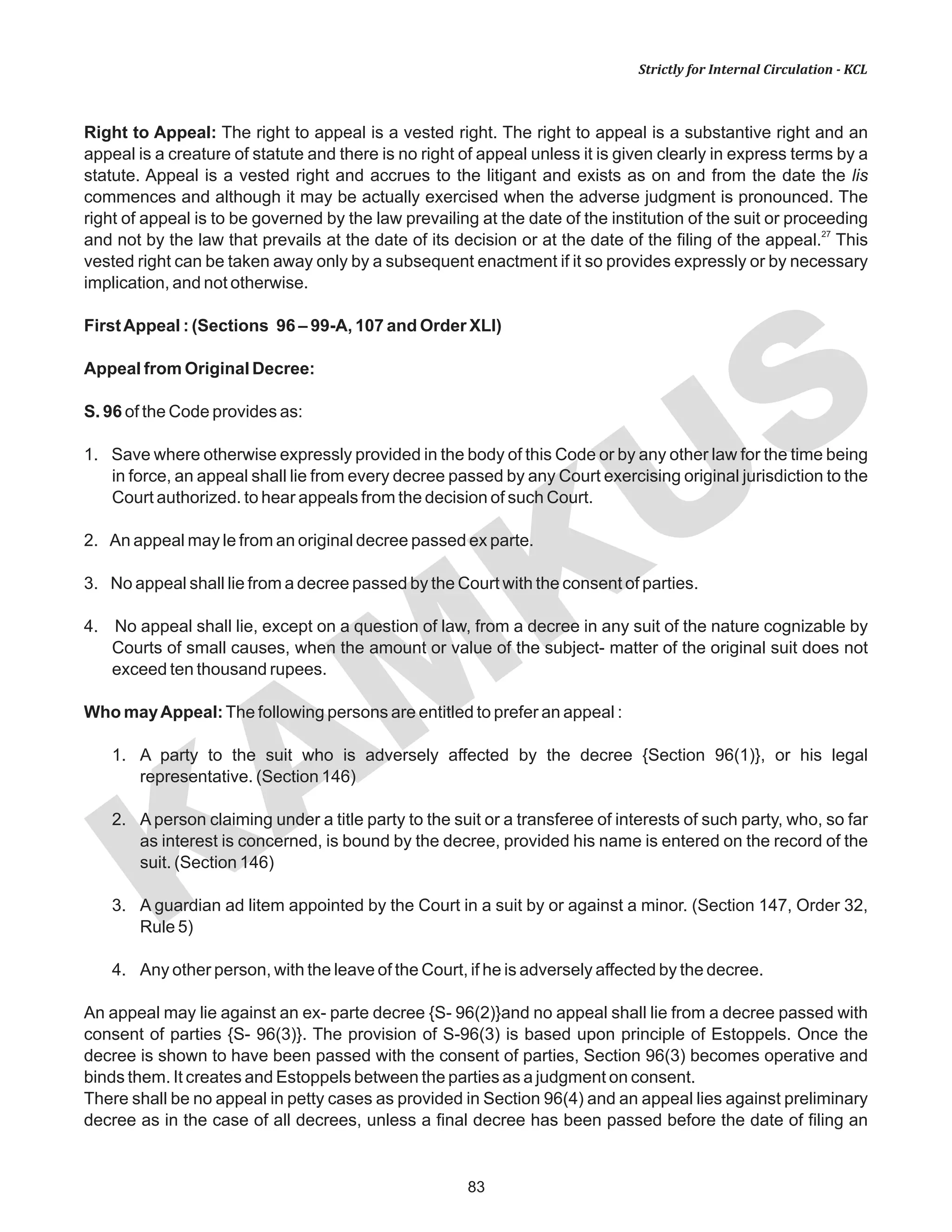
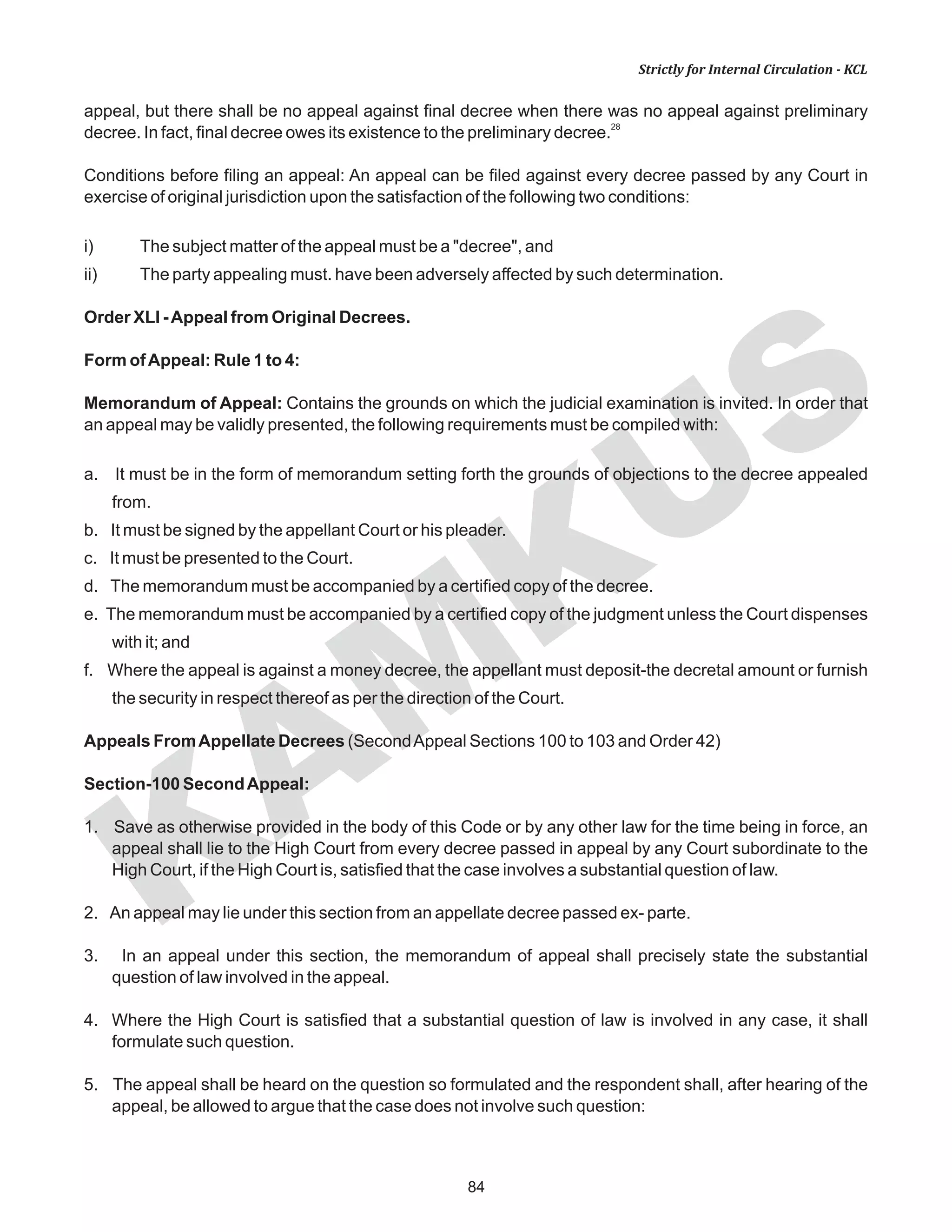
![85
KAM
KUS
Strictly for Internal Circulation - KCL
Provided that nothing in this sub-section shall be deemed to take away or abridge the power of the Court to
hear, for reasons to be recorded, the appeal on any other substantial question of law, not formulated by it, if
it is satisfied that the case involves such question.
Substantial Question of Law: Means a substantial question of law as between the parties in the case
involved. A question of law is a substantial as between the parties if the decision turns one way or the other
on the particular view of law. If it does not affect the decision, it cannot be said to be a substantial question of
29
law.
Form of Second Appeal; A memorandum of second appeal precisely states the substantial question of
law involved, but, unlike the memorandum of 1st appeal, it need not set out the ground of objections to the
decree appealed from. Order 41 Rule 1.
Appeal From Orders (Section 104 and Order 43)
Section 104: Orders from which appeal lies-
1. An appeal shall lie from the following orders, and save as otherwise expressly provided in the body of
this Code or by any law for the time being in force, from no other orders:
I. An order under Section 35A; [Sec. 104(1) (ff)]
II. an order under Section 91 or Section 92 refusing leave to institute a suit of the nature referred to in
Section 91 or Section 92 , as the case may be; [Sec. 104(1) (ffa)]
III. an order under Section 95 ; [Sec.1 04(1) (g)]
IV. an order under any of the provisions of the Code imposing a fine or directing the arrest or detention
in the Civil prison of any person except where such arrest or detention is in execution of a decree;
[Sec.104 (1) (h)]
V. an order made under rules from which an appeal is expressly allowed by rules; [Sec. 104(1) (i)]
Provided that no appeal shall lie against any order specified in clause (ff) save on the ground that no order,
or an order for the payment of a less amount, ought to have been made. {Proviso to, Section 1 04( 1 )}
2. No appeal shall lie from any order passed in appeal under this Section.
Section 105:
a. Save as otherwise expressly provided, no appeal shall lie from any order made by a Court in the
exercise of its original or appellate jurisdiction but, where a decree is appealed from, any error defect or
irregularity in any order, affecting the decision of the case may be set forth as a ground of objection in the
memorandum of appeal.
b. Notwithstanding anything contained in sub-section (1) where any party aggrieved by an order of remand
from which an appeal lies does not appeal there from, he shall thereafter be precluded from disputing its
correctness.](https://image.slidesharecdn.com/cpc-smartnotes-190508082159/75/Cpc-smart-notes-87-2048.jpg)
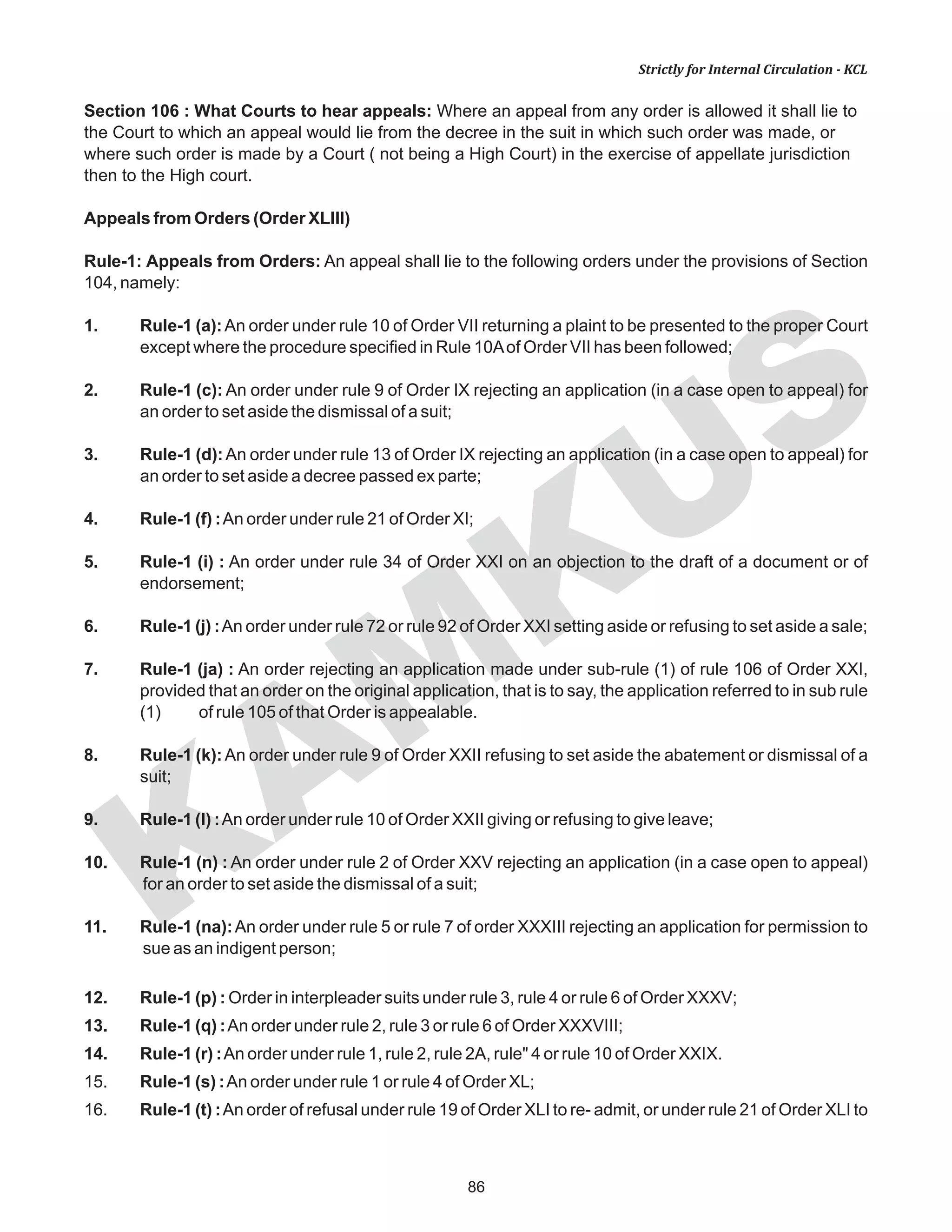
![87
KAM
KUS
Strictly for Internal Circulation - KCL
re- hear, an appeal;
17. Rule-1 (u) : An order under rule 23 or rule 23-A of Order XLI remanding a case, where an appeal
would lie from the decree of theAppellate Court ;
18. Rule-1 (w) :An order under rule 4 of Order XLVII granting an application for review.
1. Where any order is made under this Code against a party and thereupon any judgment is pronounced
against such party and a decree is drawn up, such party may, in an appeal against the decree, contend
that such order should not have been made and the judgment should not have been pronounced.
2. In an appeal against a decree passed In a suit after recording a compromise or refusing to record a
compromise, it shall be open to the appellant to contest the decree on the ground that the compromise
should, or should not have been recorded.
Rule: 2. Procedure: The rules of Order XLI [{(and Order XLI-A) by Allahabad High Court Amendment}]
shall apply, so far as may be, to appeals from orders.
REFERENCE (Section - 113 and Order XIII)
Section 113 provides provisions relating to reference and empowers any Court (subordinate Court) to
state a case and refer the same for the opinion of the High Court. Such an opinion can be sought when the
Court itself feels some doubt about a question of law. The provisions are subject to such conditions and
limitations as may be prescribed.
Object: The object for reference is to enable the subordinate Courts to obtain in non-appealable cases the
opinion of the High Court, on a question of law and thereby avoid the commission of an error which could not
30
be remedied later on.
Conditions for Applications: (Order 46 Rule 1) The following conditions must be fulfilled, before High
Court entertains a reference from a sub-ordinate Court, i.e.
1. Pendency: There must be pendency of a suit or appeal in which the decree is not the subject to appeal
or a pending proceeding in execution of such decree.
2. Question of law:Aquestion of law or usage having the force of law must arise in the course of such suit,
appeal or proceeding ; and
3. Doubt in mind of Court: The Court trying the suit, appeal or executing the decree must entertain a
reasonable doubt on such question.
Questions of law:The subordinate Court may be in doubt relating to the questions of law, which may be-
1. Those which relate to the validity of any Act, Ordinance or Regulation and the reference upon such
31
questions of law are obligatory upon the fulfillment of the following conditions :
1. It is necessary to decide such question in order to dispose of the case;](https://image.slidesharecdn.com/cpc-smartnotes-190508082159/75/Cpc-smart-notes-89-2048.jpg)


